

11 Best Single Handed Bluewater Sailboats

Sharing is caring!
We know that you’re serious about sailing when you finally think of venturing to the ocean. Who can resist dreaming of solo sailing through the Atlantic? This is an adventure to prove your advanced skills, strength, and experience.
But before going off on your ocean adventure, you need to plan and prepare . We cannot stress enough the importance of good equipment. There is a lot of sailboat types and models in the market and we want to help you choose the best one for your needs.
Do you know what hull, rigging, and keel types you will need? What’s the best material and model for you to buy?
We will guide you through important sailboat features needed for the cruise. Follow this review until the end and we will share the 11 best single-handed blue water sailboats for your solo ocean sailing!
What Size Sailboat Is Best for Single-Handed Sailing
What type of hull handles rough water the best, sailboat keel types for blue water sailing, keel or decked stepped mast, sloop or ketch, how many spreaders, cutter rig, self steering gear, furling sails, westsail 32, albin vega 27, pacific seacraft 34, canadian sailcraft 36 traditional, hallberg rassy 352, contessa 32, fast passage 39.
If you are planning to manage your boat single-handedly, then size is an important factor to consider. It can affect the size of your accommodation, and maybe the boat’s design for speed and power.
Being alone, you need to have a clear overview of what is happening on your boat. This is especially important when maneuvering or for docking operations.
Experienced sailors can handle a 60-foot sailboat but novices would find it difficult with its steep learning curve . Check out the Vendee Globe if you don’t believe me. In general, a good sailboat size for single-handed sailing would range from 25 to 40 feet.
We recommend sailboats with sizes under 40 feet. These have good displacement and are great when against bad weather. They are solo-friendly and simply the most manageable.
But in the end, choosing a suitable size depends on your experience and preference. You need to consider your overall health, age, and physique. Make sure to have a complete understanding of your sailboat before going on your journey to prevent accidents.
The hull or the main body of your boat comes in varying shapes and sizes. Each different type of hull is designed for specific purposes.
When venturing the blue waters, you need to have a hull design that could handle rough waters easily. The hull shape determines the performance of your sailboat and therefore, should align with your strengths and skills.
Today, the most popular design would be the heavy displacement hull . This design is intended for ocean cruising and longer sailing travels.
It has great stability and performs better the deeper the draft is. With this design, you would expect a slow and steady motion during your sea travels with minimal effort.
V-type hulls, on the other hand, are designed to plane or ride on top of the water. You can usually see these types of hulls on powerboats. The V-type hull usually has a bigger engine and best when dealing with choppy waters while moving at high speed.
Narrow beams are also a great option for those who are looking for another ocean friendly feature . These are usually seen in traditional sailboats.
Canoe stern or the double are considered to be the best sterns for offshore sailing. They help cut through a following sea and really helps prevent the waves from pushing the stern over too much. It also has great buoyancy and balance that is perfect for bluewater cruising.
The best materials for hulls would be fiberglass, metal, and aluminum. These are durable and could last for decades if properly maintained.
Aluminum is lightweight and has resistance to corrosion and impervious to magnetism. Boats built with aluminum are fast, stable, and seaworthy.
Fiberglass hulls need less attention. Currently, boats are usually made of fiberglass as the material is easier for companies and also great for seakeeping and stability.
Metal like steel has high abrasion resistance. It helps retain the boat’s appearance but can be prone to rust and corrosion.

A keel is a fin-like blade found at the bottom of a sailboat. It supports the ballast and helps to control and steer the boat.
It is generally designed to stop the boat from getting blown sideways because of wind pressure. The full keel, modified full keel, fin skeg, and fin spade rudder are all suited for bluewater sailing.
A full keel runs along the full length of the boat – from the bow to the stern – which makes it the most stable in the water. It carries the vessel well and is the safest to use when grounding as it reduces the chances of damage.
This is most ideal when cruising and the most comfortable out of the four keel types with its minimal heel. Although the slowest on the list, it has great directional stability and steering capability.
An improved version is the modified full keel . It is a hybrid with improved windward performance and better heel reduction than the full keel. However, it made small concessions on its stability and comfort.
Meanwhile, the fin keel with skeg rudder has more strength and protection against damage and impact. It also has better mobility and steering capability.
This type has a faster speed and windward performance compared to the modified and full keel types. It is also more balanced, which is ideal for cruiser-racer types of sailboats.
Lastly, we have the fin with a spade rudder. This is the fastest type on the list but also the most vulnerable as the spade rudder greatly relies on the rudder stock. But if you want speed and great windward performance, then this type is the right one for you.
Sailboat Rigging Types
Rigging is the whole system of ropes, chains, and cables. It supports the sailboat mast and controls the sails’ orientation and degree of reefing.
There are two main groups of sailboat rigs, Deck Stepped and Keel Stepped. The main difference lies in the location of its mast step. Both are fine choices and the better rig would depend on your preference.
Just as its names suggests, you can find the mast stand on top of the deck with Deck Stepped and on the hull’s bottom with Keel stepped. This means that to reach the keel, the mast would need to pierce through the cabin.
Deck Stepped rigs have masts that are more flexible because of their contact points, and are easily adjustable for optimal performance. Keel Stepped rig is rigid and strong and offers slow and steady cruising.
Now let’s move on and talk about Slope rigged and Ketch rigged. Which is better?
A sloop rig is simple. It is composed of a mast with a jib and a mainsail. Ketch, on the other hand, is more complex with its two masts with any foresail, main and mizzen mast combinations.
If you are choosing between Sloop and Ketch rigged sailboats for solo sailing, then we recommend Sloop. Although, Ketch is manageable and can be easily used with less strength and effort. This is perfect for cruising as it can work around multiple sailing conditions.

In terms of spreaders, you can freely choose between a single or dual spreader. This deflects shrouds and supports the mast. We do recommend dual spreaders but single spreaders are also good.
It’s just that double spreaders give the rig more strength and better sail control.
The cutter rig is sometime referred to as an inner forestay or baby stay. Simplest way of describing it is that you have two head sails instead of just one. Gives you more options on sail configurations.
Single Person Sailboat Equipment and Gear
Your sailboat would not be complete without gear and equipment. You might want to invest in autopilot or wind vane, furling headsails, electric windlass, life jackets, and AIS to make your voyage much easier.
Wind Vane is an autopilot steering that you can use without electricity. It is usually placed on the back to catch the wind and respond to various wind conditions.
It automatically adjusts the rudders in response to the wind to alter the boat’s course. This is helpful because it’s like having another crew member on board you don’t have to listen to and feed.
Headsail furling or roller reefing is necessary for easier management of your headsails. It is important to have a functioning and updated roller furling system in order to reef, dowse, or stow the headsail efficiently.
Another item we would recommend is an electric windlass . You can choose one that works vertically or horizontally, depending on your needs. This will help you move the anchor effortlessly with a single button. Using the two windlasses that god gave you makes anchoring more difficult then it needs to be.
Life jackets are a must in every sailboat. Just be sure it fits you and that you know how to use it. Also, be sure to buy a coast guard approved product with a harness that could support your weight.
The Automatic Identification System (AIS) will help you avoid collisions . It is recommended to get a receiving and transmitting one when going solo sailing.
This way, you and the other boats with AIS within the radar area are alerted to each other’s speed, course, and direction.
Really, you won’t know what you might encounter in the ocean so you must always be prepared. We hope that these items will help you achieve a safer and more secure sailing experience.
11 Best Sailboats for Solo Sailing
Now, here are 11 sailboats that are best for solo sailing. Any of these vessels are guaranteed to take you safely and comfortably anywhere around the world.

This is a long full keel fiberglass sailboat that was built from 1971 to 1981. Its design was based on a previous model, Kendall 32, and has an amazing interior size geared for comfortable cruising.
W32 is widely noted for its seaworthiness. It is built with a strong and durable design and materials to resist extreme sea conditions.
It was used on various voyages and circumnavigations. Its hull is a heavy displacement and double-ender type designed for long periods of sailing.
It is also a cutter-rigged sailboat equipped with a single mast, forestaysail, mainsail, and jib. Its overall length including the bowsprit and boomkin is roughly 40 feet, which is perfect for sailing single-handedly.
Most people would note that the speed and acceleration of W32 are quite slow. This is due to its larger wetted area and sometimes newbies’ mistake of carrying too much on board.
With the right keel, sails, and rig configurations you can improve on W32’s speed and weaknesses. As seen from David King’s documented modifications, W32 proved to be safe, steady, and fast when sailing on blue waters.

Vega 27 is a modified full keel sailboat with a masthead sloop rig. It was designed around 1966 and became the most popular production sailboat in Scandinavia.
It has a unique look because of its reverse sheer commonly seen in smaller boats to increase the area of its interior. It is made with fiberglass, but has a narrower hull compared to similar sized boats in its class.
Its shallow hull has a large cutaway as seen with modified full keel designs. This can make her quite stiff, heeling to about 15 degrees when its shoulders are buried.
Still, it is great for single-handed sailing because of its manageability and balance under different conditions. You cannot help but admire its light helm and great tracking capability.
Vega’s light air performance is okay but it shines when the wind blows at 15 knots or more. It could even maintain its dryness even with rough waves and weather conditions.
The most comforting feature would be its control and stability at all times unlike other more modern vessels with spade rudders. Overall, it is safe and ideal for longer cruises offshore.

This 30-foot traditional sailboat could take you anywhere. Alberg is notable for its narrow beams, long overhangs, and full cutaway keel with its directly attached rudder.
It is strong and durable. Its materials were mostly aluminum, hand-laid fiberglass, and polyester resin. More ballasts were produced in later productions as the early ballast was built with iron as opposed to the original lead design.
Alberg is greatly influenced by folk boats in Scandinavia. It is built with fiberglass and has an interior with comfortable full standing headroom and a well-vented galley.
This classic design from 1962 is ideal to cross oceans and is used for various circumnavigations. Alberg is a stable and seaworthy boat that could even be used in casual racing. Its best point of sail seems to be a beam reach and close reach.
It is praiseworthy when crossing oceans. Unlike modern designs that tend to be thrown around on rough seas, Alberg’s narrow beam design slices through big and rough waves and moves quickly. Under extreme weather conditions, it could perform heaving-to and lying-a-hull with no problems.
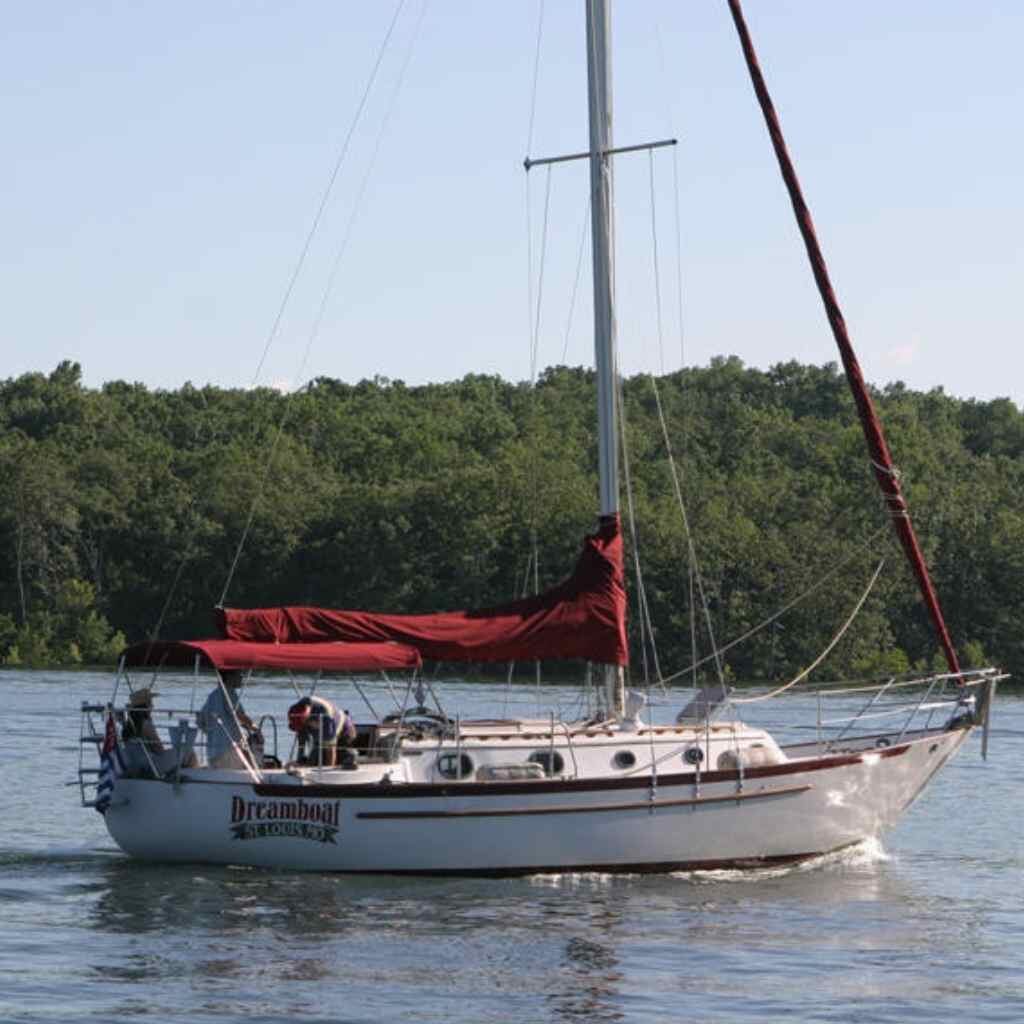
Pacific Seacraft 34 is a smaller heavy displacement semi-long keel sailboat based on the highly successful Crealock 37. It has the same graceful lines and appearance as the Crealock and is known as the Voyagemaker.
It is built with comfort and safety in mind with its large overhanging bow and beautiful sheer line ending with a traditional canoe stern. Constructed with the highest standard, it is a seaworthy sailboat that is ideal for bluewater voyages.
It is a cutter-rigged sailboat with skeg-hung rudders and control lines being fed back to its cockpit. The smaller cockpit may feel cramped but its design lowers the risk of flooding.
Still, it has a great interior suited for living aboard. It has a large headroom, comfortable galley, and up to five berths for comfortable cruising.
Although you may feel some hobby-horsing windward because of the overhangs, Seacraft 34 is overall a very balanced boat with great upwind performance. It has outstanding control capabilities and is able to sustain surfing speed with ease.

This is a double-ended full keel cruiser designed by Bob Perry and built-in Taiwan in response to the rising popularity of Westsail 32. It was offered to the market as a semi-custom boat and built with high-quality materials.
You can modify the internal layout and can choose a ketch, cutter, or pilothouse version. There is an option to use wood or aluminum spars. The mast could also be keel-stepped or deck-stepped.
Before, only 20 were ketch sailboats due to the popularity of the cutter design at that time. Now, ketch has proven to be faster and more balanced between the two.
Tayana is relatively faster than any sailboat in its class. Its best point of sail is in its broad reach. It also tracks well windward, and is an ideal choice for the trades. It is also great how the cockpit is secured from any flooding even when traveling.
Today, a lot of people are still actively sailing this. Tayana 37 has become well known for offshore and blue water sailing.

Canadian Seacraft is well known for its fiberglass racer and cruiser. CS 36 is a small traditional fin keel sailboat with a masthead sloop intended for recreational use. It is seaworthy and has good performance in different weather conditions.
It was designed by Raymond Wall and had a production run between 1978 to 1987. It remains to be popular in both north and south borders.
It is a beautiful sailboat with a graceful sheer line and balanced overhangs at both bow and stern. Its details and quality in design and production are clearly of a higher tier.
It is mostly built with fiberglass and balsa wood. It is equipped with an internally mounted spade transom hung rudder. All of its lines lead to the cockpit, which is ideal for single-handed sailing.
CS 36 Traditional also has a deep-depth draft and wide beams with great access to the cockpit and foredecks. It is wide and spacious, which is perfect for comfortable cruising.
The sailboat has great proportion and traditional aesthetics. It is simple and straightforward, which makes it ideal for bluewater sailing.

This is a sturdy and high-quality sailboat built between 1978 to 1991. It features a progressive design, combining a walk through with the aft-cabin from the main saloon. It is made with a tall and standard rig each supported on double and single spreaders, respectively.
Hallberg Rassy 352 has a nicely balanced hull sporting a fin keel with rudder on skeg, a generous beam, and a 45 percent high ballast ratio. Its water and fuel tanks are placed low in the keel to improve sail carrying ability.
Its production spanning 14 years allowed for continuous improvements in its specifications. Newer sailboats have raised hulls for bigger headroom in the under the deck, aft cabins, and the walkthrough. Engines were also replaced by a Volvo and later a Penta Turbo or the bigger MD 22.
It is impressive how they balanced good interior and sailing performance. It has great seakeeping ability and smooth motion in heavy seas, easily an ideal sailboat for singlehanded sailing.

Corbin 39 was designed based on a Dufour design named Harmonie, increasing freeboard, and flushing the deck. Its style is influenced by the classic Scandinavian cruiser, Westsail 32.
It has a long fin keel, blunt bow, and a high freeboard. It was sold as kits, and various deck molds were produced. They have pilot, aft, and center cockpit variations.
It was made of sturdy and high-quality materials. The earlier version’s decks were of marine grade mahogany but it was later changed with Airex foam. Its lead ballast was encapsulated with fiberglass for added protection.
Earlier boats had a single spreader main or a turbocharged double spreader. Later, Corbin used 49 feet double spreader rigs instead, and all were deck-stepped.
Corbin 39 is truly a strong and seaworthy vessel. With its fin keel and skeg rudder, cutter rig, and reefed main combinations, it could take anyone safely and comfortably anywhere in the world.

Valiant 40 took its looks from Scandinavian double-ender sailboats. It had a successful production run that spanned for 47 years. It proved to be one of the pioneers for modern blue water designs.
Its hull is made from thick hand-laid fiberglass, bolted and covered with teak. Its ballast is cast with lead bolted to the keel stub. Lastly, the skeg is constructed separately from hull molding and encased with fiberglass before being fastened to the hull.
It has a beautiful bow and sheer lines and a longer LWL for maximum speed. At the back are a non-spacious cockpit and a canoe stern ideal for bluewater sailing operations.
Under the waterline is a fin keel with its skeg hung rudder. It perfectly matches with the cruising hall above, minimizing wetted surface area
Overall, Valiant 40 is a seaworthy vessel with great blue water performance. Extremely balanced and well-mannered, it can withstand extreme weather conditions with ease and minimal effort on your part.
It soon gained a reputation as a fast water passage-maker with high integrity. Now, it is regularly used for circumnavigations by solo sailors and voyagers.

If you like a sailboat with a proven track record, then Contessa 32 is for you. It is a seaworthy racer-cruiser with good all-around sailing capabilities released in 1971.
Like its younger sister, Contessa 26, it has great speed, integrity, and affordability . Contessa 32 is a definite combination of old and new with its traditional narrow beam, a full hull with a fin keel, and fiberglass rudder protected by a skeg found in more modern yachts.
It has marked overhangs and a narrow tuck-up stern. It has less headroom below in return for its lesser wind resistance.
This configuration delivers fast racing speed and great stability. It could definitely withstand extreme weather and rough waves. Contessa 32 is claimed to be able to right itself when rolled or capsized.
Contessa 32 is known for its forgiving nature. It has a responsive helm and excellent windward performance. With its astounding stability, it can carry full sail for up to 25 knots.

Fast Passage 39 was designed by William Garden and is said to be a legendary cruiser with speed, ruggedness, and fame. It is a stout double-ender comparable to the Valiant 40.
It has the same LOA and LWL as Valiant and also has nearly identical ballast and displacement. The difference is its narrower frame and more evolved underwater shapes resulting in flatter forward and aft keel sections and less wetted area. It also has great directional stability as its rudder allows great control under wind vane and down steep waves.
It is a high performing sailboat but also difficult to find as only 41 were produced. A part of the group was offered as hull and deck kits intended to be finished by the sailboat owners.
Fast Passage 39 also has a proven track record and has won single-handed blue water races. It performs great under a wide range of conditions, especially in light winds.
By now you should have some idea what makes a vessel Bluewater friendly. There are hundreds of vessels that can make long distance voyage safe and enjoyable. These examples above are just a few examples of the Best Single Handed BlueWater Sailboats.
Leave a Comment Cancel Reply
Your email address will not be published. Required fields are marked *
Save my name, email, and website in this browser for the next time I comment.
Get your "Sailing and Boating" Free Guide

10 Best Solo Bluewater Catamarans and What Makes Them Great!
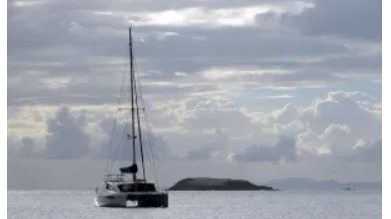
As an Amazon Associate, we earn from qualifying purchases. We may also earn commissions if you purchase products from other retailers after clicking on a link from our site.
Finding the best solo bluewater catamaran is hard, I have been looking for the right balance of lightweight, sturdy, spacious, and compact. But what are the best solo bluewater catamarans on the market?
The ten best solo bluewater catamarans have unique designs, are about 40 feet (12.2m) long, boast an autopilot, all lines to the cockpit, and can provide a safe ocean passage with only one sailor on board. Popular short-handed bluewater cat models include the Manta 42, Dolphin 42, and the FP Belize 43.
Whether you’re looking to buy a brand new catamaran or refit an older one, I know one thing, there’s a solo sailing boat out there for you. Read on to learn about the best models available on the market today, this article is a synergy of my own knowledge together with the experience of expert sailors.
Table of Contents
What To Look For in a Solo Bluewater Catamaran
If you’re sailing single-handed (aka shorthanded or solo), you’ll want an easy-to-maintain boat that allows you to stay at the helm for the bulk of your trip. Typically, you’ll want a catamaran that’s about 40 feet in length (and with a beam to length ratio above 53%) too big of a boat, and it will be hard to handle, and too small it becomes unable to sail large waves and strong winds safely. Sail size plays a big part in how easy your reefing and winching will be.
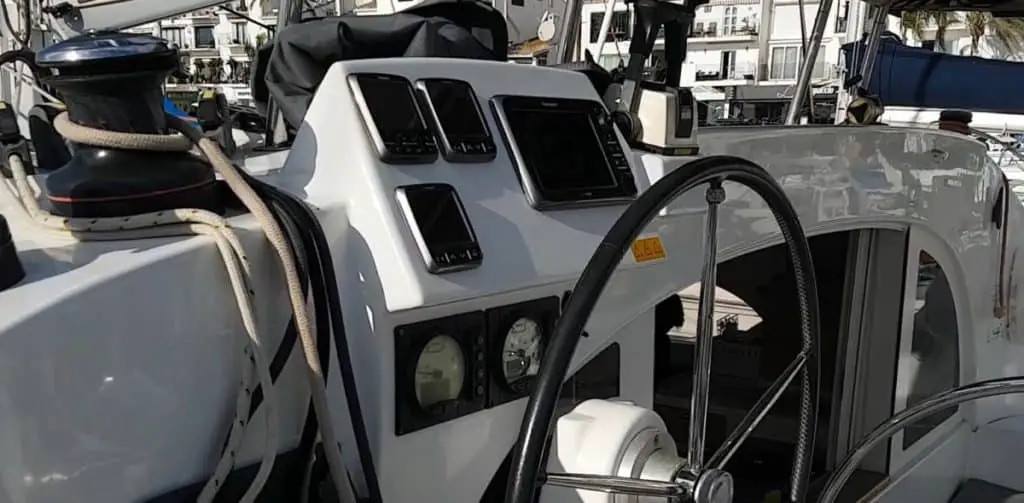
If your boat has an autopilot , which a well-outfitted bluewater boat definitely should, you will have an easier time managing sails and navigation. With autopilot mode enabled, you can cruise along without having to worry about adjusting the course since the autopilot will do this for you. These systems can be standalone or tied into a GPS and make a great asset for single-handed sailors.
Remember that autopilot works better under power than under sail because of the amount of electric power it needs to work. You can increase performance under sail, however, by trimming correctly for a neutral helm.
Autopilot functions can sometimes be managed with a remote controller that you can wear on your wrist or a lanyard for added convenience.
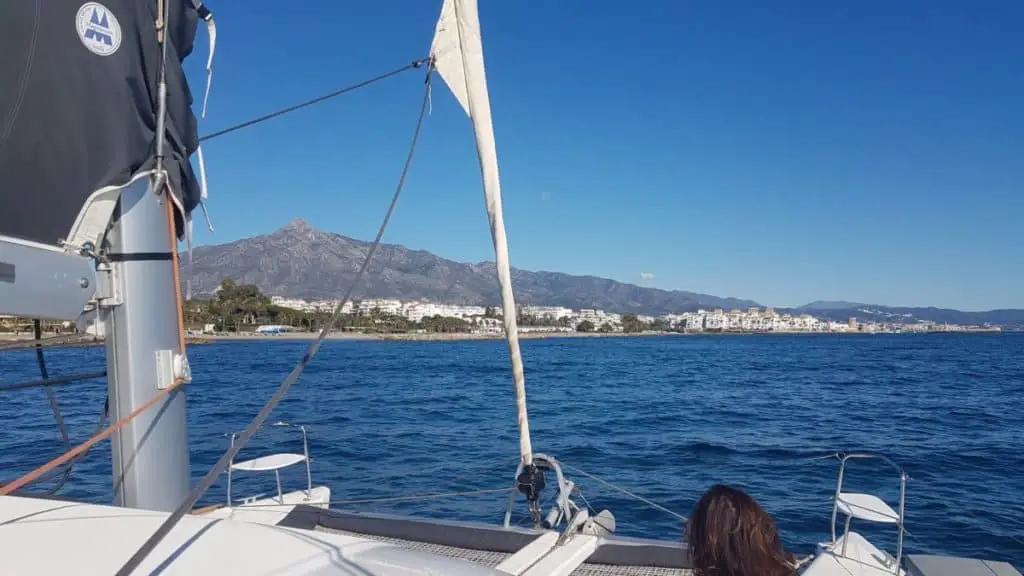
Having a furling headsail can save you effort on the foredeck, and in-mast or in-boom furling makes the job of mainsail reefing more simple. However, this comes with a tradeoff in performance.
A slab-reefed main takes longer to reef, but it’s easier to handle than others because of the lines led aft. The only thing you need to worry about in this case is adding lazy jacks, which will prevent the main from blocking your vision.
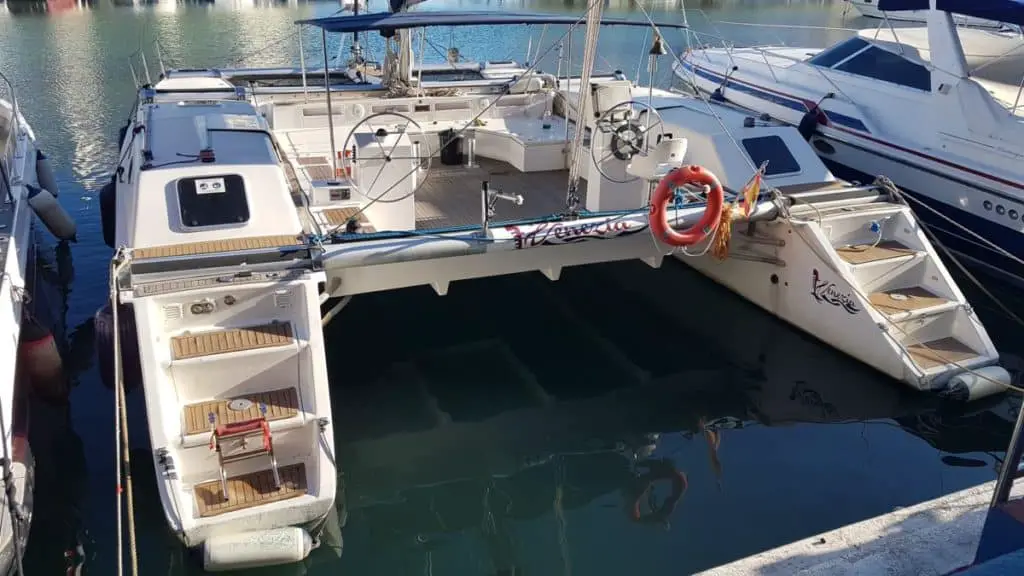
Handling & Safety
One of the riskiest things a solo sailor can do is leave the cockpit , so choosing a ship with quick and easy sail handling is of great importance. This is especially crucial near harbors, where there’s likely to be lots of other boat traffic. The best bluewater catamarans for solo sailors will have lines that run into the cockpit so that you don’t have to abandon your position at all.
Even if you don’t run all your lines to the cockpit, you should at least take the main halyard back with you to the cockpit . This ensures that you’ll be able to stay in control of the boat without having to scramble quickly between stations.
When mooring by yourself, you might find midships cleats valuable in that they provide an anchoring point that keeps your ship from drifting away before it’s been completely secured.
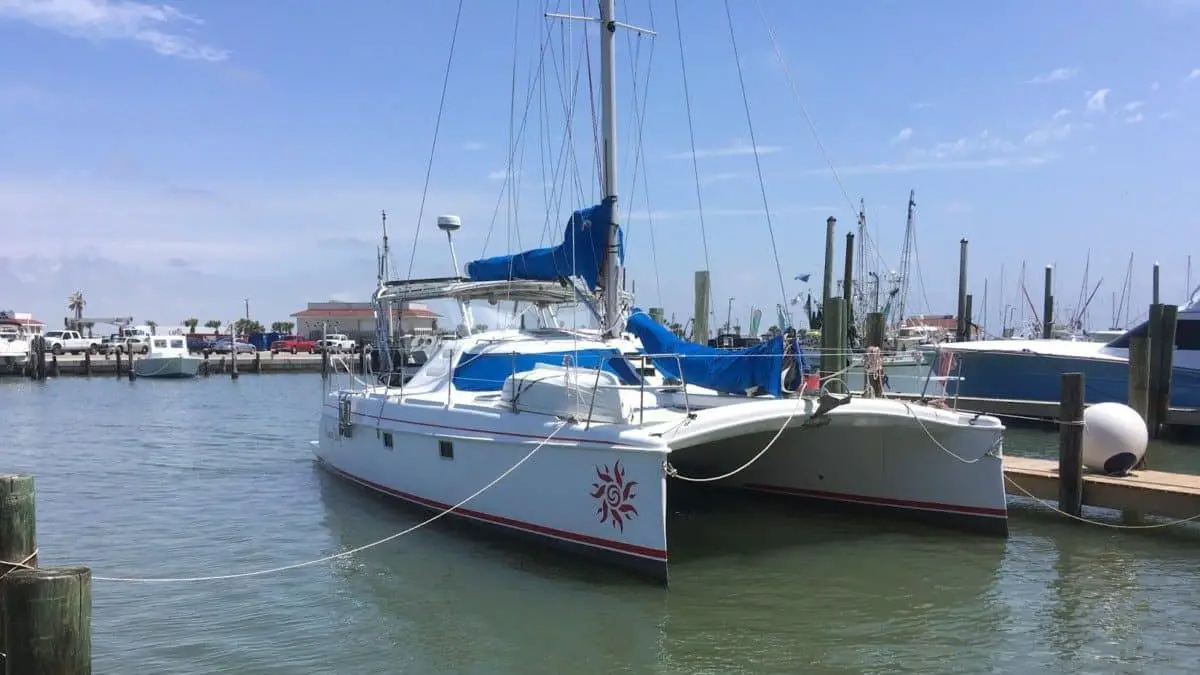
The Manta 42 is a classic multihull catamaran built in the late 1990s to 2000s in Florida. It was designed by French naval architect Eric Lerouge and can be identified by its high bows and curved crossbeam. A Manta 42 is relatively light and has room for added features, like solar panels or dinghies.
What Makes It a Good Solo Sailing Cat
The Manta 42 is great for single-handed sailing because it’s lightweight and easy to handle. It also has pinned aluminum crossbeams rather than conventional aluminum crossbeams, which means that the bows’ twisting forces will be absorbed. But note that this can lead to stress cracks in the bow area.
For more information about the Manta 42, see this video walkthrough:
The Brazil-made Dolphin 42 comes equipped with a daggerboard for stability, which allows it to point higher. This also reduces the amount of wetted surface and allows you to anchor in shallower water. The Dolphin 42 also has a foam core for reduced weight and a lower chance of developing a wet core.
This catamaran is 41 ft. (12.5 m) long, with a displacement of 24,255 lbs (11,001.88 kg). It has two 60 horsepower engines, six feet (1.83 m) four inches (10.16 cm) of headroom, and comes with a built-in GPS-integrated autopilot system and a fully battened mainsail. Additionally, this ship has several household comforts, like hot water, air conditioning, a TV set, and a computer built-in, as well as a refrigerator.
The Dolphin 42 is lightweight, stable, and compact, great for short-handed sailing. Dolphins have been known to perform successful circumnavigations comfortably and safely and are very reliable. However, you should be sure to choose a model that has not had any major modifications to the structure post-production.
Privilege 435
The Privilege 435 is a heavier cruiser meant for long-distance trips , designed according to the French tradition of multihull ships. These have been on the market for about 30 years and are made by large producers like Lagoon and Nautitech. The Privilege 435 can be purchased as an owner version or with four cabins and four head/showers.
This catamaran is low-slung and has low wind resistance. Its windows come with internal shades and optional outdoor shades, but without “eyebrow” overhangs, the saloon can become quite hot in the tropics. Still, this boat is of very high quality and has a solid, stylish finish.
The Privilege 435 is a luxurious choice, built for long-distance cruising . This catamaran is well-made, will not give in easily to stress, and has low wind resistance for increased efficiency. If you’re looking for a high-end boat with a stylish design, this could be the choice for you.
Fountaine Pajot Belize 43
The Fountaine Pajot Belize 43 is perhaps the most popular catamaran on the market today. It has a full-length owner suite with a clever design that pairs a curvaceous saloon with a wraparound dinette and nav area. The galley comes with wraparound windows, and the outer deck is easy to walk on.
The Fountaine Pajot Belize 43 has a foam core, which means it’s lightweight and unlikely to develop a wet and soon rotten core. It makes for a great solo sailing boat due to its ease of use, stability, and comfortable design. This catamaran is especially good for long travels due to its comfortable and spacious layout. It would make for a great single-handed sailing trip for a family.
Nautitech 44
The Nautitech 44 was one of the first catamarans with an integrated hardtop bimini , one of the many ways this design set the trend for short-handed sailing catamarans. It has two modes, one that allows single-wheel steering at the bulkhead and another that allows twin wheel steering closer to the stern. The Nautitech 44 also has slim hulls, which means more speed.
This ship is produced out of Rochefort sur Mer, a hub for naval architecture and shipbuilding. Nautitech was the first luxury boating company to introduce the concept of open living onboard, combining the saloon and cockpit to make one functional and spacious living area.
Because the Nautitech 44 has two modes for steering, it allows each sailor to choose the steering method that best fits their wants and needs. Both modes have their advantages, but many prefer the sailing sensation of the two-wheel approach. This ship’s design also allows the saloon door to be left open even in the heavy rain, without fear that water will leak inside.
The combined saloon and cockpit also make for a comfortable trip for the single-handed sailor, allowing you to enjoy your leisure room without leaving your ship’s control room.
The Lagoon 440 has a lot of volume for a single-handed sailing catamaran and a signature squared-off structure. This ship isn’t lightweight, but the saloon is spacious and accommodating to furniture. One version of the Lagoon 440, the flybridge version , is a difficult ship for shorter sailors to operate, simply because of a high boom position.
The Lagoon 440 is a good solo sailing boat if you’re looking to go on a long-distance trip, spending lots of time out at sea. It isn’t particularly fast, but it’s very stable, easy to use, and has lots of room for furniture and supplies. Several versions of this model are available on the market, all of which have slightly different layouts.
This catamaran is 49 ft. (14.94 m) long , bigger than most solo sailing ships. However, it does come with an autopilot system that makes solo sailing easier, as well as a GPS, radio, and built-in radar detector.

The Leopard 45 is a South African-made multihull ship on the market since the late 1990s. Most Leopard 45s on the market are four-cabin versions, although a three-cabin version of the ship also exists. It also has a large, open-plan saloon with a large galley and a trademark rear arch.
See the Leopard 45 in action in the following video:
What Makes It a Good Solo Sailing Boat
The Leopard 45 is a good solo sailing boat because it has a sturdy fractional rig for stability and is easy to use. It also has an open cockpit, which makes circulation easy. And you’ll find the engine access points on the outside of the ship, which makes maintenance easier.
The Voyage 44 is a South African-made catamaran with a rugged design, considered a cost-effective option with superior sailing performance relative to other ships sold at the same price point. This boat has a particularly wide beam, which makes for more stability and more space. However, it also has a very exposed low bridge deck to be aware of.
The Voyage 44 makes a great single-handed sailing boat because it’s so stable with its ultra-wide beam. It makes the ship very easy to steady, even for beginners. While it’s not particularly lightweight, it’s built with an aerodynamic design, enough so that it can move along at a steady clip.
What is the largest boat one person can sail?
Outremer 45
The Outremer 45 is a product of La Grande Motte in the South of France, built with a well-executed, smart design. The hulls and deck are made with vinylester and a divinycell core, and its high-load areas are suited with carbon for extra durability and rigidity. You’ll find secure glassing at the joints of the ship rather than glue that could come undone.
The Outremer 45 has a classic multihull structure, small volume, and incredible responsiveness to the helm. It has a high bridge deck clearance , as well as well-proportioned bows. It also has a balanced weight distribution to prevent pitching and encourage steady motion forward. This is a pricier option, but an option with many great features.
The Outremer 45 is a good solo sailing ship because it’s very compact and easy to manage. Its proportionate design means more stability and less pitching. It’s a very light ship, so it’s likely to move faster through the water than its competitors.
The Prout 45 is built for long distances rather than speed. It’s a heavy, sturdy boat that you’ll have an easy time guiding without worrying about pitching.
The Prout 45 has space for a small stateroom in the center of the boat and comes in both owner and four-cabin versions. It has next to no bridge deck clearance due to a “nacelle” that runs along the main deck from end to end. This adds headroom and buoyancy and adds drag that can take away from the experience by slowing you down and creating noise.
If you want to better understand the difference between a solid foredeck and a net, a.k.a. trampoline, then I suggest you read my article comparing the two.
The Prout 45 has smaller, more manageable sails than other options and allows easy access to the rigging, which runs right into the cockpit. It’s a heavier ship and one that’s easy to keep stable. It’s a great ship for a solo sailor because you can do most of your work right from the cockpit, and it’s a sturdy catamaran that’s unlikely to pitch.
Tips for Single-Handed Sailing
Sailing solo is a great way to get to know your boat and is necessary for many people. The idea is to be able to cruise, whether it be close to coasts or at high seas, without needing a crew on board. It’s a challenge, so it’s best not to embark on a trip single-handed unless you have a good amount of experience and feel confident doing so.
Before heading out single-handed, you should test yourself with an inactive crew. Go together when the weather is nice and have them be your backup while you try solo sailing and see how it feels.
Make sure that you’ve also physically trained for the level of fitness you’ll need to operate the ship, especially if you’ll be going out on a longer excursion than you’ve done in practice. Taking care of a ship is demanding work, and you can quickly burn out if you’re not ready for it.
Preparation
Prepare yourself thoroughly for the sail, study the route, read sailing guides for every area you’ll be in, and make yourself aware of any dangers that may arise. Become aware of possible shelters, and know where you’ll be entering and exiting the harbors. It’s a great idea to save these locations as waypoints on your GPS, just in case.
I asked catamaran sailors what their favorite books are, Here is the list: 15 Best Books about Cruising Cats!
A great way to prepare yourself for possible situations is by reading books, I have bought plenty of books and I list some of my favorite on this page . So far I haven’t found any good solo bluewater books that I would recommend, but here are two catamaran cruising books that I have read and that I feel comfortable recommending. I suggest you get both of them since they complement each other.
Multihull seamanship is very informative but offers boring graphics, and Cruising guide for sailors is inspirational with beautiful pictures.

Make sure you choose a good weather window. Avoid sailing a few hours ahead of a forecast gale at all costs. Instead, seek a time with a reasonable breeze and a calm sea. You can gradually introduce yourself to different weather conditions, but remember not to challenge yourself too much too quickly.
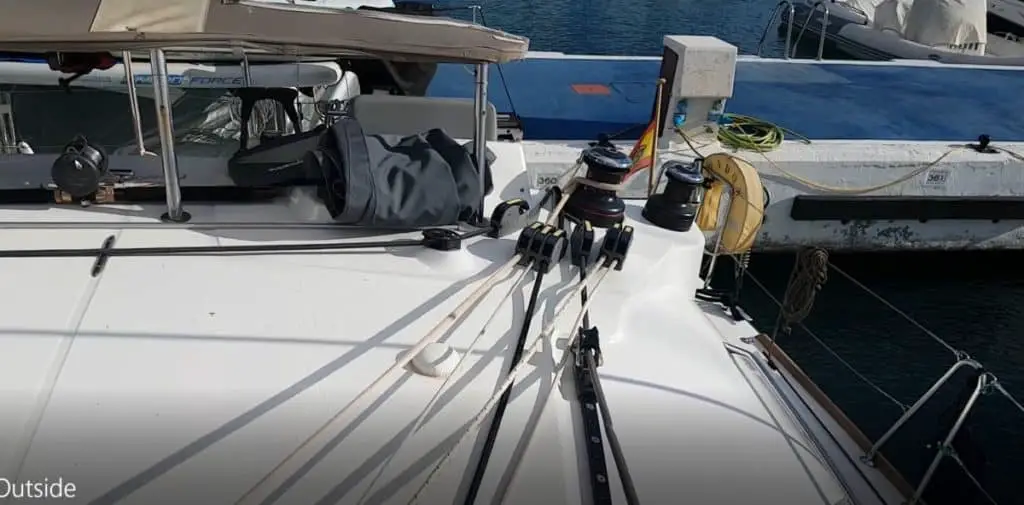
All lines To The Cockpit
The cockpit layout plays a big role in determining whether a catamaran can work for solo sailing . You’ll need to see a chartplotter on deck so that you can keep course without needing to go to reference chart tables. Having a visible battery monitor is also important, especially if you’re going to use autopilot, which pulls significant power from the battery.
Don’t forget to also bring sunscreen, water, and a compass, which you should have on hand at all times. Having a good communication system available in the cockpit is also a good idea. In case of emergency, you should have a radio that you can use to call for help, as well as flares and binoculars.
The ten best solo bluewater catamarans each offer a positive and unique experience for the sailor, and the best one for you depends on your needs, wants, and preferences. Those looking to make a longer trip will need something different than those looking for speed, but every solo sailor has some common needs, like the need for a stable and easy-to-manage vessel.
Owner of CatamaranFreedom.com. A minimalist that has lived in a caravan in Sweden, 35ft Monohull in the Bahamas, and right now in his self-built Van. He just started the next adventure, to circumnavigate the world on a Catamaran!
2 thoughts on “ 10 Best Solo Bluewater Catamarans and What Makes Them Great! ”
Cool that really helps, thank you.
I’m glad you appreciate it!
Leave a Reply Cancel reply
Your email address will not be published. Required fields are marked *
Save my name and email in this browser for the next time I comment.
Recent Posts
Must-Have Boat Gear for Catamaran Sailors!
Sailing is probably the most gear-intensive activity I've ever done; there are so many decisions to be made about what gear to buy now, for tomorrow, and what to definitely never buy. The gear on...
6 Best Trailerable Trimarans For Bluewater and Coastal Sailing
Having a boat costs a lot of money, even when you are not using it, marina fees, etc. And once it is in the water most sailors never go very far from their "home marina" and sailing will be somewhat...

Editor’s Choice: 18 Bluewater Sailboats We Love
Advantages of bluewater sailboats, factors to consider when buying a blue water sailboat, allures 51.9, contest 55cs, discovery revelation 480, grand soleil 42 lc, hallberg-rassy 48mk ii, island packet 349, j/boats j/45, najad 395 cc, outbound 56.

Looking to sail the open seas? Bluewater sailboats are your answer. With their sturdy construction and ability to handle rough conditions, these boats are designed for serious offshore sailing adventures. In this comprehensive guide, we will delve into the world of blue water sailboats and provide you with everything you need to know. From their unique features to their advantages and considerations, we will explore it all.
Bluewater sailboats are known for their strength and durability. Built to withstand the challenging conditions of ocean crossings, these boats offer stability and safety on long voyages. Whether you’re planning a solo trip or setting off with a crew, a blue water sailboat is an excellent option to explore the depths.
We will discuss the key characteristics that make blue water sailboats stand out, such as their hull design, rigging, and navigation systems. Additionally, we’ll explore the various types and sizes available to help you find the perfect fit for your sailing aspirations.
So, if you’ve ever dreamed of embarking on a thrilling ocean adventure, join us as we navigate the world of bluewater sailboats and uncover everything you need to know.
Bluewater sailboats are designed to withstand the demanding conditions encountered during long ocean voyages. They possess several key characteristics that set them apart from other types of sailboats.

1. Sturdy Construction
Bluewater sailboats are built with robust materials and construction techniques to ensure their strength and durability. They feature reinforced hulls made of fiberglass, aluminum, or steel, which can withstand the impact of large waves and adverse weather conditions. These boats are designed to handle the constant stresses of offshore sailing without compromising their structural integrity.
2. Seaworthiness
One of the defining characteristics of bluewater sailboats is their seaworthiness. They are designed to handle rough seas and strong winds, providing a stable and comfortable ride even in challenging conditions. The shape of their hulls, with a deep V or modified full-keel design, allows them to cut through waves and maintain stability, minimizing the rolling motion commonly experienced on other types of sailboats.
3. Self-Sustainability
Bluewater sailboats are equipped with systems that enable self-sustainability during long voyages. They typically have large water and fuel tanks, allowing sailors to carry ample supplies for extended periods at sea. In addition, these boats often come equipped with renewable energy sources such as solar panels or wind turbines, reducing the reliance on external power sources.
Bluewater sailboats offer numerous advantages for sailors looking to embark on offshore adventures. Here are some of the key benefits of choosing a blue water sailboat for your next sailing journey.
1. Safety and Stability
When sailing across vast oceans, safety is paramount. Bluewater sailboats provide a high level of safety and stability, thanks to their sturdy construction and seaworthiness. These boats are designed to handle adverse weather conditions and rough seas, ensuring the safety of the crew and the vessel. The robust hulls and well-balanced designs make them less prone to capsizing or taking on water, providing peace of mind during long voyages.
2. Long-Distance Capability
Bluewater sailboats are specifically designed for long-distance sailing. They have the capacity to carry ample supplies, including food, water, and fuel, allowing sailors to embark on extended journeys without the need for frequent resupply stops. With their self-sustainability features and efficient hull designs, these boats can cover long distances efficiently and comfortably.
3. Comfort and Liveability
Living aboard a bluewater sailboat for an extended period requires comfort and practicality. These boats are designed with spacious interiors, allowing for comfortable living quarters during long voyages. They often feature multiple cabins, a well-equipped galley, and ample storage space for provisions and personal belongings. The layout and design of blue water sailboats prioritize functionality and convenience, ensuring a comfortable living experience even in the middle of the ocean.
And now… it’s time to discover together our selection of 18 Bluewater sailboats we love!
The Allures 51.9 innovates with its full-beam aft owner’s cabin. This model disrupts the codes of the yard also outside with its cockpit of 6 meters long with sunbath and swim platform for comfort; the navigation space can be protected by a hardtop to navigate in any security. The boat has a length of 51.9 feet (15.8 meters) and a beam (width) of 15.4 feet (4.7 meters). It is equipped with a fixed keel and a composite hull, which provides good stability and seaworthiness. The Allures 51.9 is available in a variety of configurations, including a three-cabin layout with a spacious owner’s cabin and two guest cabins, or a two-cabin layout with a larger owner’s cabin and a smaller guest cabin. It is also equipped with a well-equipped galley, a large saloon, and a navigation station. Allures official website .

In a dynamic evolution and complementary to their range, Amel launched a larger model, with a higher specification and built with attention to details. Riding on the success of the Amel 50 , the Amel 60 is an enhanced version of the new Amel design . The brand’s fundamental characteristics are well represented in this large yacht, with an additional 10 feet increasing her volume as well as her interior and exterior living spaces, while still ensuring ease of use for a small crew.
Signed Berret-Racoupeau, the generous volumes of this large yacht have been designed to allow owners and their guests to fully enjoy life on board, while preserving everyone’s privacy: a large living space in the saloon, an ultra-equipped high-end galley three cabins each with a bathroom, an even larger protected cockpit, opening onto sunbathing areas ideal for relaxation.

The Dutch specialist in semi-custom constructions Contest Yachts presented the brand new 17-metre Contest 55CS at Boot Dusseldorf 2020. Don’t call it “simply” a bluewater yacht. The stunning lines both above and below water from star designers Judel/Vrolijk shall ensure a real sporty character. A newly conceived interior styling now features an even bigger flowing corner radius to the exquisitely finished timber work. There are also now more optional hull windows in up to four stations along the yacht’s length.

Discovery Yachts presented the new Revelation 480 at Boot Dusseldorf 2020 . This is the first model of the new Revelation line and differs from the Southerly line for the fixed keel and the lowered saloon. Yes, the Revelation 480 is a lowered saloon boat based on the well-known Southerly 480. The Revelation 480 combines bluewater capability with a low, sleek coachroof that contributes to an interesting aesthetic. Down below, the single level interior is extremely light and exquisitely furnished.

The Grand Soleil 42 LC is Cantiere del Pardo ’s latest entry model of the bluewater line. Comfort and sailing autonomy are the main features of this 12-meter, designed by Marco Lostuzzi together with Nauta Design and Cantiere del Pardo’s Technical Office.
The 42 LC is available in two versions; standard or sport. The former is equipped with aft benches, and a carbon arch over the cockpit, designed to keep this area free of the mainsheet traveller. The GS 42 LC’s hull guarantees great stability thanks to greater hull volume. The well-proportioned sail plan optimizes the high-performance sailing standards. As with the rest of the Long Cruise range, the Grand Soleil 42 LC is designed to provide greater and more luxurious comfort on board.
The interior layout is available with either two or three cabins, to meet the client’s needs. Both versions include two heads with a shower. In the saloon, a three-seater sofa is found on the starboard side, while the central seat can be transformed into a chart table.

The Hallberg-Rassy 48 MK II is a true bluewater cruiser that offers more natural light, more comfort and more elegance than ever before. With three double cabins and a vast saloon, she offers great space for modern comfort aids. Known far and wide for sturdy construction, superb craftsmanship and signature seaworthiness, Hallberg-Rassy boats are globally respected for their elegant lines and spirited performance.

Hylas Yachts has collaborated with German Frers for over 40 years and built a reputation for yachts that combine ocean sailing capability, classic lines and exquisitely finished interiors. Now the company is staking out new territory with the H60. Still ocean capable, still with an exquisite interior but also embracing some of the contemporary demands of today’s cruising sailors.
Longtime Hylas fans will not be disappointed by her performance. Built using the most advanced construction technologies, the H60 has been designed to excel in all conditions with excellent seakeeping ability. A plumb bow and broad transom make the most of her waterline length underway, providing speed with optimal comfort.
The builder partnered with Milan-based firm Hot Lab , known for their elegant designs in the superyacht world, to offer interiors that immediately set the new Hylas on a new level.

The project of the ICE 70 by ICE Yachts has been realized using the most advanced modeling and analysis software available today. “ Thanks to the new virtual reality ‘tools’ ,” explains Felci Yacht Design , “ we have been able to make the owner and the shipyard participant of many geometric and stylistic choices. It is a yacht with high technological potential, starting from the design of the hull and the appendices “. With this sporty bluewater sailboat, the Italian yard wanted to create a technologically avant-garde boat with large, comfortable indoor and outdoor spaces, which is easy to sail and entirely safe at sea. Like all ICE Yachts models, the ICE 70 is a semi-custom product with which the owner has many possibilities for customization and equipment. ICE Yachts official website

With this model, iconic Island Packet has returned to the Solent-style rig as standard, featuring a mainsail with a working jib and an optional lightweight 170% reacher or asymmetrical that mounts on the integral bow platform and furled with Harken systems. The working jib is fitted with a Hoyt Boom that is self-tending and improves performance with its close sheeting and self-vanging feature, while the large optional reacher or asymmetrical boost performance in light air or when off the wind.
The fully battened mainsail is equipped with a low friction Battcar system and drops easily into a stack pack with an integral cover and lazy jack system. This rigging offers ease of use and versatility in the varied wind or sea conditions and increased speed and maneuverability.

The J/Boats J/45, is a true bluewater sailing yacht, designed and built for the sea by life-long sailors. The J/Boats and J/Composites teams have collaborated to create a special design for discerning sailors seeking an exceptional sailing experience. The J/45 can be sailed solo, cruised by 2-3 couples or large family, and pleasure sailed or raced with room for the whole crew. This is an investment-grade sailboat that won’t require a professional crew to sail, handle or maintain. J/Boats official website

The Kraken 50 is designed to be the short-handed bluewater cruising yacht. Due to her steady motion and stability, her crew will be equally comfortable at sea or in the anchorage, and special consideration has been given in the K50 layouts above and below deck to allow for short-handed ocean passage making. The Kraken 50 features the renowned integral Zero Keel and fully skegged rudder.

N395 CC (centre cockpit) is part of the all-new Najad 395 range, designed in a joint venture by Najad, Farr Yacht Design, and Ken Freivokh Design – superyacht stylist, architects, and interior designers. The N395 CC is characterized by a well-protected large cockpit located close to the center of gravity. It has a well-designed interior and a very comprehensive options list that includes all equipment necessary to tailor the yacht to any individual needs. This model is available in two or three cabin layouts with one or two large heads.

Welcome aboard the newest addition to Outbound’s impressive line of offshore passage makers. The new Outbound 56, built from German Frers timeless and proven design continues to fulfill our single mission of building great offshore yachts. Fast, accommodating and gorgeous, the 56 will take you anywhere your heart desires in style and comfort.

The entry level yacht for the ‘G6’ range of seven models up to the Flagship Oyster 118. Using the latest generation of Oyster hull shapes, developed with Humphreys Yacht Design, the Oyster 565 is designed for family sailing without professional crew.
A generous sail locker and lazarette, headroom and bunk lengths to match the larger Oyster Superyachts, the 565 can be configured with many different cabin layouts – and for the first time in Oyster Yachts – can have the master cabin forward and a dinghy garage in the transom.

The Brittany based yard is well known not only among ocean sailors but also to those who love short-handed sailing and are looking for seaworthy and easily driven bluewater sailboats, both safe and comfortable. This last aspect is where Fora Marine has made great progress in the last few years, shedding some of the spartan image that characterized their products for many years.
What has not changed, and what is still the RM range’s defining characteristic, is the twin-chined hull, made of Okumé plywood impregnated with epoxy resin (the deck is in fiberglass sandwich). Below the hull, the yard offers two options, a single deep keel or double shoal draft keels. The RM are designed by Marc Lombard, probably one of the architects most able to transform the fashionable chine into an important element in cruising design. A chined hull, when properly drawn, gives both better hull shape and interior volumes. ( Read our test )

The Rustler 42 is a classic looking yacht which combines style that is traditional yet modern. Her cruising layout results in a live aboard yacht that has stability and elegance with the same unique sea-kindly characteristics as the Rustler 36. Below the waterline, she looks conservative with a deep canoe body, long fin keel and a big skeg hung rudder.
Below the decks, this yacht has a spacious open plan saloon. The large, finished saloon table can comfortably seat eight. The aft cabin has standing headroom, a full-width double berth and plenty of storage within lockers and a vanity unit with seat. The aft head incorporates a shower unit and a ‘wet lilies’ locker. At the forepeak the grand master cabin has a 6 ft 6 in double V berth.

Signed by German Frers , the Swan 58 needs to combine the spaces of bluewater sailboats with a fast cruiser performances. Key details include a deck featuring soft and rounded shapes, a new cockpit design, a redefined coach-roof style and large swimming platform. The concept is easy: to give the maximum comfort and liveability at rest, together with maximum efficiency for short handed sailing, without losing the capability to race with a full crew.
The interiors of the new Swan 58 , which is fitted with European oak, have been conceived as a combination between luxury and comfortable living spaces, storage and volumes for systems and safety features; we find here a large saloon, a galley with a 360 degree layout and three heads. Various interior styling layouts are available varying woods and materials.

Designed by Tartan naval architect Tim Jackett, the 395 comes out of the Tartan factory in Fairport Harbor and is the perfect example of bluewater sailboats. Her hull shape is an evolution of tried and true concepts proven to deliver great stability and high interior volume while maintaining comforting manners throughout a wide range of sailing conditions. On deck Tartan 395 sports hallmark Tartan design elements such as a traditional cabin house fitted with functional polished stainless steel rectangular portholes.
Like her smaller sister 345, 395’s handcrafted interior is built in maple as standard, with cherry a no-charge option. The lighter maple opens up her interior in ways the darker cherry simply cannot.
Grand Soleil 52 Performance: New Life to the Myth
Nautor swan merges with sanlorenzo group, royal huisman project 410, ready to roll the hull, the first wallywind110 to debut at the monaco yacht show 2024, live your passion, subscribe to our mailing list.

Home » Blog » Bluewater sailboats » The best bluewater sailboats under 40 feet (we analyzed 2,000 boats to find out)
The best bluewater sailboats under 40 feet (we analyzed 2,000 boats to find out)
By Author Fiona McGlynn
Posted on Last updated: August 17, 2023
What are the best bluewater sailboats under 40 feet?
Last year we analyzed 2,000 offshore designs to bring you a list of the most popular bluewater sailboats .
However, most people are searching for a boat in a particular size class. So, we decided to do a double-click and look at the best sailboats under 40 feet for offshore sailing.
If you’re interested in an even smaller boat, there are plenty of great options under 30 feet in our list of the best small sailboats for sailing around the world .
The characteristics that make a sailboat a bluewater sailboat are a hotly debated topic, so we wanted to use real-world data and find out what cruisers are using to cross oceans and sail around the world.
We looked at 2,000 boats that entered the Pacific Puddle Jump (PPJ) over the last 12 years. For those of you who aren’t familiar with the PPJ, it’s a rally that crosses the Pacific ocean. We took part in 2017 and had a ball!
Also, if you’re looking to buy one of the bluewater boats on this list, you might want to check out our post on the best places to buy used boats and how to find free or cheap boats for sale .
Just be aware that a bluewater boat isn’t necessarily offshore-ready. Our top five picks are all older boats and will undoubtedly require work.
Every cruiser we know made substantial repairs and additions before going offshore: adding watermakers , life rafts, solar panels, and more.
Also, always have a boat inspected by a professional and accredited marine surveyor before buying it or taking it offshore.
So, without further preamble, here are the best bluewater sailboats under 40 feet.
The best bluewater sailboats under 40 feet
1. the westsail 32.
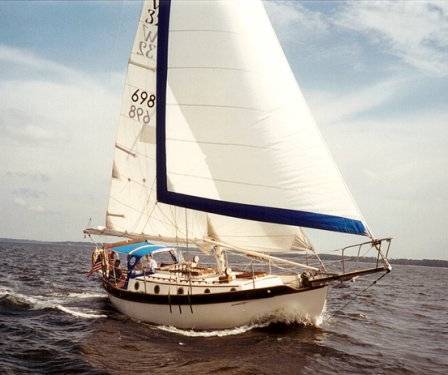
The Westsail 32 is one of the most iconic bluewater cruisers. Built by the Westsail Corporation in the 1970s, this plucky, small sailboat has developed a cult following over the decades. Since 2009, 19 have set out to cross the Pacific in the PPJ rallies.
The Westsail 32 is known for its sturdy construction, seaworthiness, and classic looks. In fact, it set the standard for what a real bluewater cruiser should look like. In 1973, the Westsail 32 was featured in Time magazine and inspired many Americans to go cruising.
Though popular, this boat has earned the unenviable nickname “ Wetsnail 32″, a reference to its poor ability to windward and sluggish performance. But Westsail 32 owners don’t care that they won’t be winning any races.
What the boat lacks in speed it makes up for in classic looks and excellent offshore cruising characteristics. Many owners have crossed oceans and circumnavigated the globe in their Westsail 32s.
| LOA | 32.00 ft / 9.75 m |
| First built | 1971 |
| Builder | Westsail (USA) |
| Designer | W. Crealock / W. Atkin |
| Hull type | Long keel, trans. hung rudder |
| Rig type | Cutter |
| Displacement | 19,500 lb / 8,845 kg |
2. Tayana 37
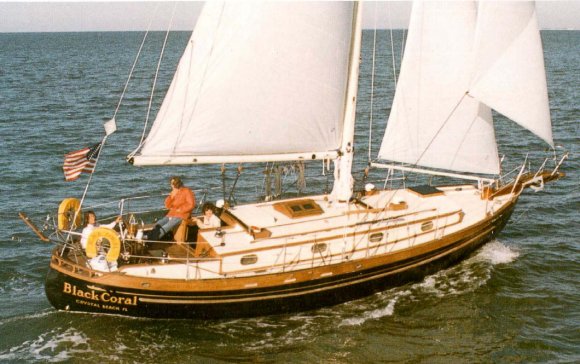
The Tayana 37 is a wildly popular Bob Perry design. It first rolled off the production line in 1976 and there are now several hundred of them sailing the world’s oceans.
Above the waterline, the Tayana 37 boasts beautiful traditional lines. However, Perry wanted to avoid the unenviable (read: sluggish) performance characteristics, associated with double-enders.
So, he designed the Tayana 37 with a cut-away long keel and moderate displacement, maintaining the classic look, while achieving reasonable performance.
The Tayana 37 has a devoted following of offshore enthusiasts. Since 2009, 12 Tayana 37s have set out to cross the Pacific in the PPJ rallies.
Read more about the Tayana 37 in this Practical Sailor review .
| LOA | 36.67 ft / 11.18 m |
| First built | 1976 |
| Builder | Ta Yang (TWN) |
| Designer | R. Perry |
| Hull type | Long keel |
| Rig type | Cutter |
| Displacement | 22,500 lb / 10,206 kg |
3. Hans Christian 38T
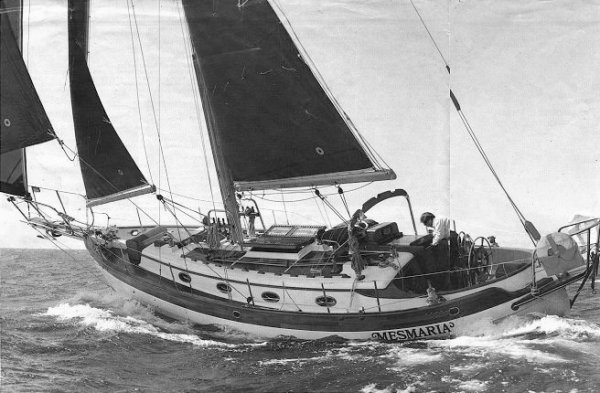
The Hans Christian 38T is a full-keeled, heavy displacement bluewater boat with a long bowsprit and a clipper bow, giving it a distinctive appearance. It was first introduced in 1976 and was produced until the early 1990s.
If you hadn’t already guessed, the “T” in the name stands for “Traditional”. Like many boats on this list, it takes a cue from Crealock’s famous Westsail 32 which sparked a craze in the 1970s and 80s for Scandinavian-style doubled-enders.
It’s gained a reputation as a capable and seaworthy cruising yacht. Many owners have crossed oceans and completed circumnavigations in Hans Christian 38Ts.
By our count, eight Hans Christian 38Ts have participated in Pacific Puddle Jump rallies over the last 12 years.
| LOA | 37.92 ft / 11.56 m |
| First built | 1976 |
| Builder | Anderson Yachts Ltd. (TAIWAN) |
| Designer | Harwood Ives |
| Hull type | Long keel |
| Rig type | Cutter |
| Displacement | 26,500 lb / 12,020 kg |
4. Island Packet 380
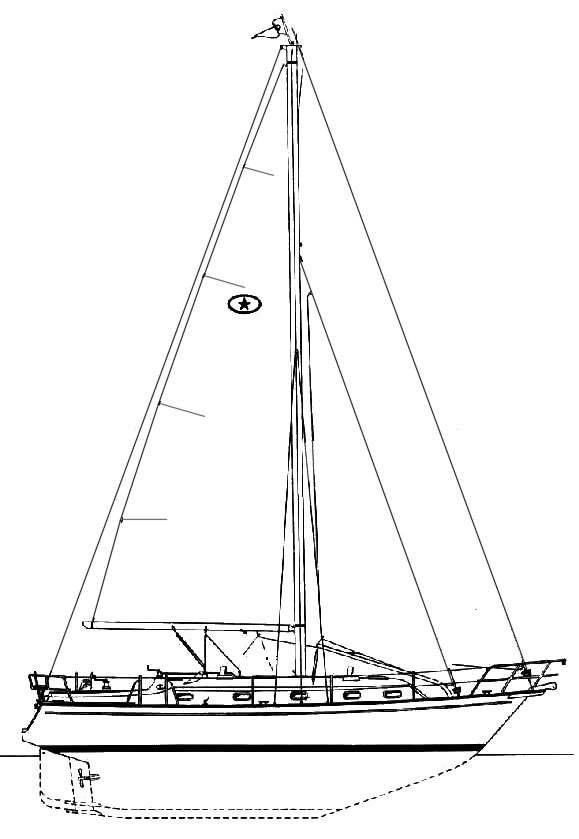
I’ve always considered Island Packets the Rolls-Royce of the bluewater boat world. Their distinctive cream-colored topsides make them easy to spot and their robust bluewater construction makes them the envy of many far-flung anchorages.
Designed by Bob Johnson and built by Island Packet Yachts in Florida, the Island Packet 380 was first introduced in 1998. 169 were built before 2004, over which time it gained a reputation as a capable and comfortable offshore cruiser.
Having been built in the ’90s and early 2000s, this is a relatively newer boat. In many ways, it offers the best of both worlds, a classic-looking boat with all the modern cruising conveniences.
The Island Packet 380 design prioritizes safety and stability. It also has several offshore features including standard twin bow rollers, a divided anchor locker, and ample storage for cruising gear.
Life below deck is comfortable too. With a 13-foot (4 meter) beam there’s plenty of room for liveaboard amenities.
The Island Packet 380 is a popular choice for long-distance cruising and offshore passages. Since 2009, six Island Packet 380s have set out to cross the Pacific in PPJ rallies.
Read more about the Island Packet 380 in this review by Yachting Monthly .
| LOA | 39.58 ft / 12.06 m |
| First built | 1998 |
| Builder | Island Packet Yachts (USA) |
| Designer | Bob Johnson |
| Hull type | Long keel |
| Rig type | Cutter |
| Displacement | 21,000 lb / 9,525 kg |
5. Ingrid 38
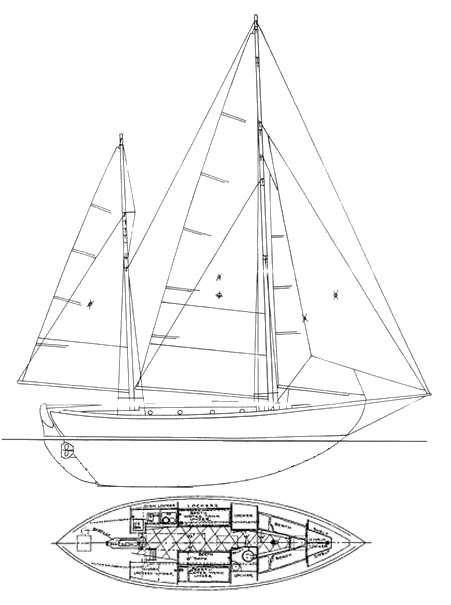
The Ingrid 38 is a double-ended sailboat that was originally designed for wood construction in 1938.
In 1971, Bluewater Boat Co. began building a fiberglass version. The design proved hugely popular and more than 140 were built.
With a full keep and heavy displacement, the Ingrid 38 epitomizes the traditional bluewater cruiser. Yet, it remains a well-loved design today. Since 2009, six Ingrid 38s have set out to cross the Pacific in PPJ rallies.
| LOA | 38.00 ft / 11.58 m |
| First built | 1938 |
| Builder | Bluewater Boat Company (USA) |
| Designer | William Atkin |
| Hull type | Long Keel |
| Rig type | Cutter |
| Displacement | 26,000 lb / 11,793 kg |
Description
Fiona McGlynn is an award-winning boating writer who created Waterborne as a place to learn about living aboard and traveling the world by sailboat. She has written for boating magazines including BoatUS, SAIL, Cruising World, and Good Old Boat. She’s also a contributing editor at Good Old Boat and BoatUS Magazine. In 2017, Fiona and her husband completed a 3-year, 13,000-mile voyage from Vancouver to Mexico to Australia on their 35-foot sailboat.
Terms and Conditions - Privacy Policy
Your source for the latest news on yachts, boats and more. Read through our articles to find out how to compare boats and find the right fit for you!
Solo Sailing: Best Boats for Single-Handed Sailing
Aug 22, 2023
less than a min
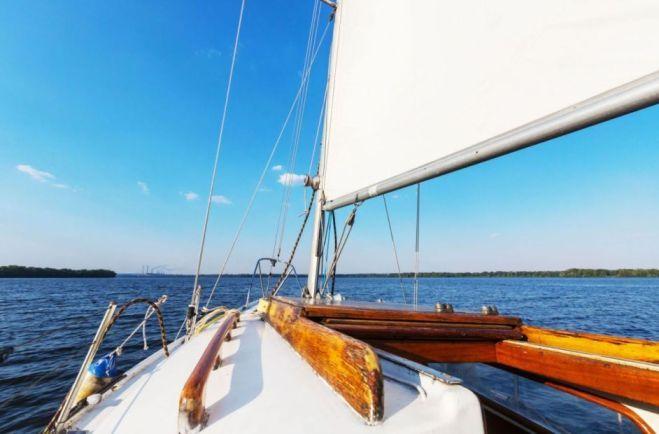
Best Boats for Single-Handed Sailing
Embarking on a solo sailing adventure requires not only skill and preparation, but also the right vessel. Not all sailboats are equal when it comes to handling them single-handedly. Below, we'll explore some of the best options for single-handed sailing boats, focusing on their unique characteristics, strengths, and why they might be the perfect choice for your next solo voyage.
Engineered with meticulous precision, the Hanse 458 is an embodiment of masterful German craftsmanship, showcasing an optimal blend of performance and comfort. This sailboat's key advantage is its self-tacking jib and a fully automated sail handling system that enables smooth sailing single-handedly. The incorporation of a performance-oriented hull, large sail area, and unique rigging designs contribute to its excellent speed and agility. The Hanse 458's high degree of automation and efficient layout reduce the physical demands and decision-making load on the solo sailor, making it a well-suited companion for solo sailing adventures.
The Dufour 430 is a French sailboat designed with versatility and performance in mind. It has been acclaimed by many single-hand sailors due to its impressive balance of cruising comfort and easy handling. The vessel is equipped with a self-tacking jib and an intuitively positioned control panel in the cockpit for hassle-free manoeuvring and sailing. The spacious and luxurious interior design of the Dufour 430 ensures a comfortable stay onboard, making it ideal for extended solo voyages. Safety, seaworthiness, and a sense of freedom on the water make this French-built sailboat a top choice among single-handed sailors.
Jeanneau Sun Odyssey 410
Emerging from the drawing boards of the reputed French yacht manufacturer Jeanneau, the Sun Odyssey 410 is a fine blend of innovation and simplicity. With features such as a walk-around deck and the award-winning inclined side decks, it brings an unprecedented level of convenience for solo sailors. Its balanced sail plan and hull shape, which capitalises on the latest advancements in naval architecture, ensure the vessel remains stable and easy to handle in varying conditions. These characteristics, combined with an ergonomic cockpit layout and a comprehensive set of navigational tools, make single-handed sailing on the Sun Odyssey 410 a joy rather than a challenge.
Beneteau Oceanis 40.1
The Beneteau Oceanis 40.1, hailing from another celebrated French manufacturer, Beneteau, is designed for comfort, speed, and ease of handling. Its unique flared hull design significantly increases the interior space without compromising on performance. The yacht's rigging, centralised sail handling system, and an optional self-tacking jib make for straightforward single-handed sailing. Moreover, the spacious cockpit, equipped with dual helms, enhances manoeuvrability and vision, essential attributes for those sailing alone.
Built by the Slovenian shipyard Elan, the E6 model is an epitome of high-performance sailing and comfort. The use of Vacuum Assisted Infusion Lamination technology results in a strong, lightweight structure contributing to superior sailing efficiency and speed. The boat's deck layout is designed with single-handed sailing in mind, with all sail controls led back to the cockpit. The twin-wheel setup and a balanced rudder ensure precise steering in various sea conditions.
The Dehler 29, manufactured by the esteemed German brand Dehler, is a compact yet robust sailing yacht. Despite its relatively small size, it's equipped with an impressive set of features that facilitate solo sailing. Its fractional rig and self-tacking jib provide excellent performance and ease of handling. A meticulously designed cockpit and easily reachable sail controls further enhance the single-handed sailing experience. Moreover, its smart interior design makes efficient use of space, ensuring a comfortable stay onboard.
Jeanneau Sun Odyssey 490
The Jeanneau Sun Odyssey 490 is a modern performance cruiser that does not compromise on comfort and ease of handling. Its generous sail plan and balanced hull shape ensure fast passages, while the twin helm positions and all lines led aft to the cockpit allow for efficient single-handed control. The high-quality interior, filled with an abundance of natural light, provides a comfortable living space during long solo voyages.
The Oyster 565, produced by the prestigious British manufacturer Oyster Yachts, is an epitome of luxury and performance. Designed for blue-water cruising, it incorporates several features that make single-handed sailing possible. The boat's centre cockpit design, combined with in-mast furling and powered winches, ensures all controls are close at hand and easy to operate. The strong, seaworthy build of the Oyster 565 offers peace of mind for solo sailors when faced with challenging sea conditions.
Each of these boats has unique features that make them suitable for single-handed sailing. However, regardless of the boat you choose, good seamanship and a proper understanding of the boat's handling characteristics are crucial for a safe and enjoyable solo sailing experience. For those interested in exploring other options, our comprehensive boat database at TheBoatDB offers more selections from these boat manufacturers and other brands known for their high-quality sailboats.
You might like these too

Sailboat or Motorboat – Learn the pros and cons
Aug 24, 2022

Types of Catamaran Boats: Sailing, Power, and Luxury Catamarans
Feb 10, 2023

Which is better a wooden boat or fiberglass boat

What are the main types of sail rigs for sailboats

Which is the Best Economical Catamaran
Oct 04, 2021

What is a Chine on a Boat
Oct 01, 2021
Best Sailboats for One Person (With 9 Examples)
One of the most common challenges of sailing is finding the right boat to sail alone. Luckily, there are some good sailboats out there suited for one person. Let's take a look at them, and find out why they're especially good for single-handing.
In this article, I talk about single-handed sailing and look at the nine best sailboats for one person, ranging from small lake dinghies all the way to comfy cruisers capable of oceanic crossings.
Here are the best sailboats for solo sailing
Jeanneau Sunfast 3200
Beneteau oceanis 62, pacific seacraft flicka 20, tartan 3700, hunter channel 31, j boats 109.
Now let's look at them in detail so that you can choose the one best for you.
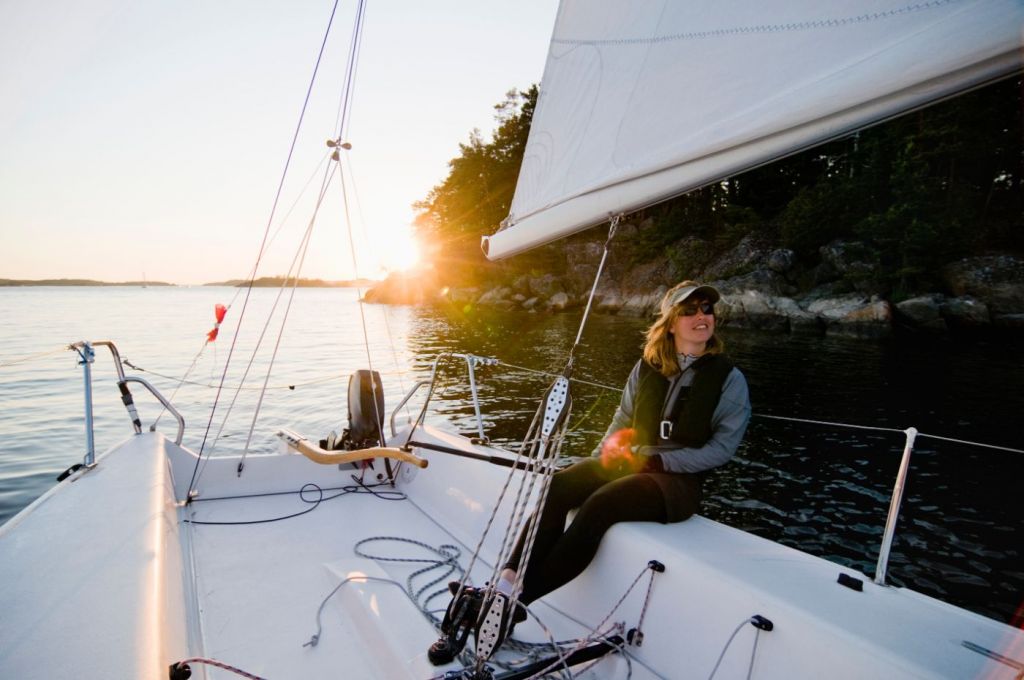
On this page:
What you need for short-handed sailing, features of a good single-handed boat.
Before talking about anything else, let's take a quick look at the features you want in a sailboat for short-handing (a fancy way of saying sailing alone ).
Scroll down to the list of sailboats here .

What to look for in a single-handed sailboat:
- Easy-to-operate sails
- Self-tacking jib
- Self-reefing sails
- Good autopilot
It's nice to have a team of friends, each with their own position within the crew, taking care of their specific thing. One behind the helm, one at the navigation, one trimming the mainsail, one taking care of the foresail, and an extra deckhand just to be sure. But if for whatever reason you want to sail on your own, you'll be the one to fill all those positions.
To make sure that it is physically possible and as easy as can be under the circumstances, start with a good boat choice. The idea is to pick a design that will be easy to operate with just one person available.
Now the good news is that since around 1990, many boat manufacturers have been focusing on ease of operation. That's just what the current market demand dictates. In other words, good single-handed sailboats aren't a rare find.
So what are the specific features to look for when sailing on your own? Let's clear a common misconception first - single-handed doesn't mean the boat has to be small.
Sure, small boats are easier to dock, and things tend to be within reach… but you will find large numbers of 70-footers that are designed as single-handed projects.
You can operate 100-footers on your own. Read all about it in our article What's the largest boat one person can operate?
Easily Operated Sails
A good start are sails that can be operated without much hassle. That doesn't necessarily mean being able to reach all the lines and winches from the helm. If you can, that's great, but if the boat has an autopilot, all you need is to be able to tweak the sails from the front of the cockpit.
Try to avoid setups where you'd have to walk to the mast to play with your sheets - not only it takes time but doing that in heavy winds, tall waves, on a boat that is healing, is a recipe for disaster that nobody is there to save you from.
When solo sailing, the ability to reef and tack quickly is important since those are oftentimes time-sensitive maneuvers. So self-tacking jibs would make your life way easier.
Individually Suitable Boat
The best test, though, is to take the boat out and try it out for yourself. A boat that handles easily in the hands of one person can be unmanageable in the hands of another.
A spinnaker pole might be a handful for the shorter folks, while a 6'2'' 200lbs bloke won't have issues with it.
But don't go around shopping with a 'must-have' checklist. Sometimes the boat is almost there, and all it needs is a little DIY technical push, like adding an extra jammer to the cockpit and running a reef line through it, or getting your hands on a windvane self-steering kit.
As somewhat touched upon before, manufacturers are trying to cater to the ease of use and since technology is going forward, what used to be a hi-tech racing equipment piece years ago, has now made its way into the affordable mainstream.
The canting keel is such an example, something you used to see on racing sailboats only, but now can be put on your average cruiser.
Autopilot Matters
An important part of solo sailing is a good autopilot, for obvious reasons. Luckily, nowadays, these are very reliable compared to what the standard used to be years ago in the cruiser world.
That being said, if you can get your hands on a boat with a proper below-the-deck autopilot with a gyrocompass, you will be much happier than with your average on-deck system, which does the job well, but when things get windier, it might become less reliable.
By the way, racing boats tend to be good solo sailing vessels—they are set up for efficiency. They feature more robust rigging and hulls that can withstand rough conditions and gusts better, and thus are more forgiving, without the necessity to tweak to detail.
I'm not saying that to necessarily have you look for racing boats for your short-handed trips, but rather so that you don't steer away from them on purpose, thinking they would be too much of a handful.
On deck, navigation is a big one too. Again, nothing to cry about if your boat of choice doesn't have one, as it can be easily solved with aftermarket solutions. Or an iPad with the proper app. But having to run below the deck to see where you are isn't the handiest of scenarios, especially in tricky situations.
If possible, consider investing in side thrusters. They can make maneuvering your boat infinitely easier, docking can turn from an unpleasant procedure to a relatively simple joystick play, and especially if you are on a bigger boat, you will appreciate this feature.
We haven't touched on the topic of interiors since it isn't as sensitive as a matter. But having plenty of handles to grab onto regardless of where you are is a good idea, since hitting your head and passing out is unpleasant with a crew, but potentially fatal without it.
To continue with the topic of safety, equipment and boat design aside, remember that you can't really afford mistakes you could make with friends on board. So make sure you have enough spots to clip your harness to, that the boat is sufficiently equipped with communication devices and that all the equipment works as it should.
So let's get specific. What are the nine boats that make great companions for solo sailors?
Let's start with the obvious one—a dinghy. It won't probably be your choice when crossing an ocean, but for practice or a fun day close to the shore, this is one hell of a boat. In comparison to its rivals in the same category, RS Aero is super light weighing 66 lbs. It is among the most technologically advanced sailing dinghies designed specifically for one person.
All of this comes for a price though - 10 000 to over 15 000 USD. You will be getting your money's worth for sure though. An enormous amount of hi-tech work went into this project, and you'd be buying a design that won more awards than could fit on its 13-foot body.
This is a big step up from a dinghy, while still keeping things very simple. It is a lightweight boat, originally designed for a transatlantic race. Thanks to that and its small size, it is easy to handle, the racing pedigree shows in the efficient layout, so everything is within reach. Despite its smaller size, it can reach speeds you would expect of much larger boats.
You can find small family cruisers of the same size, but don't let that fool you. This is very much a Spartan sailboat. Inside, you won't find much more than the bare necessities - two aft cabins, curtains instead of doors, simple seating, not much lining or wood, just a notch above barebones interiors. You get a toilet though, a chart table and a galley as well as much stowage. But you will be reminded of being on a racer, because unless you are shorter than 5'7'', you won't be able to stand up straight.
As mentioned, this boat was designed for a cross-ocean race, so it is a seaworthy bluewater mate that should be able to take you more or less wherever you want to.
Time to go big. As previously mentioned, solo sailing doesn't mean you have to stick to smaller sizes. Why? Because it is a trend now. Even though just some ten years ago, the situation was vastly different, these days, single-handed 60+ footers aren't anything rare.
So why this Beneteau? Well, for one, to meet the new kinds of market demand, it was designed for ease of use, meaning it can be successfully operated by a single person. I don't know what you'd do alone with all that space, but if you want to enjoy oceanic solitude while not giving up the luxuries of having space the size of a family apartment, you can.
And while there are more boats of this size suited for short-handed sailing, like the larger Jeanneaus, Hanses, or even Bavarias, the Oceanis 62 can be yours for around 600 000 EUR new, which is a figure unheard of in that size and quality range up until relatively recently.
This is not the first time I am mentioning this boat in an article, and no wonder, it has so much character! Like others in this list, this one has been designed for single-handed sailing - it had to be. You couldn't fit two people on it comfortably anyway.
So aside from its solo capabilities, why does it deserve to be on the list? Well, it's towable, which you could say about the RS Aero too, but you can actually live on a Flicka, and it is seaworthy. It is about as small as you can go while still being able to cross oceans.
There is no question about everything being within the hand's reach on this one. Ergonomics almost don't matter at this size. Given its towability, the fact that you can park it in your garden, and its short-handed potential makes for the perfect spontaneous getaway mobile.
Another boat you can live on. It is a seaworthy ocean crosser, and thanks to its setup and a self-tacking jib, it is a proper short-handed boat. It also has quite a wide beam, thanks to which you'll get additional stability, further supporting comfort when operating it solo. It is made by a brand that proved its worth over time, as since the 70s, it is still going strong. It's comfortable enough for long distances, with a spacious salon, shower, and space for a small family.
Used, you can get one starting around 150 000 USD, which is one of the reasons why it belongs on this list - if you are serious about solo sailing and want a proper boat without compromises that come with smaller sizes or sportiness, this one is within a reasonable reach. Among the affordable, high-quality, short-handed sailing cruisers, Tartan 3700 has its definite place.
This is the kind of boat I was talking about when I mentioned that formerly racing design aspects started to make it into the cruising world. Hunter started as a racer builder and then shifted to cruisers, while, of course, taking its know-how with them, which makes for boats that are easy to operate, also well-performing ones.
This specific model got on the list because of its low center of gravity, high ballast ratio, and stable hull, which means you won't have to trim the sails all the time to go fast. And less work is always welcome if you are the only person to do all of it.
Another reason it's gotta be here is it is very efficient layout, self-tacking jib, and single-line mainsail reefing system—a smart choice for solo sailors.
If you like what you saw in Hunter Channel 31, but fancy something a bit faster, with a higher quality build, this one's what you want. It has lost much of its sportiness as it is too heavy to be thought of as a proper performance boat today, but in the worst-case scenario, it is a quick cruiser capable of satisfying sprints.
It was designed for single-handed sailing as well as for full crewed racing, so if you want to push as much as you can out of it with a team of your mates, you can, while knowing you will be able to cruise at a good pace when they leave.
So unless you mind the slightly higher price tag, which comes with the high build and components quality, as well as the less generous interior fanciness usually seen in racers, you've found yourself a boat.
The best thing about solo sailing is also the most dangerous thing about it - you will be alone. So you want your boat to be your buddy - forgiving as much as can be, having your back. Amel 60 is such a boat. It has watertight bulkheads, so it is hardly sinkable, its cockpit has a solid roof and windows, so no matter the weather, you'll be protected while behind the helm, it has a stable hull, offering support even in tricky weather, it features electric winches, so you can operate the sails without even touching a line…
...and inside, you get more space and luxury than you could wish for, including a washing machine. All in all, if there is a boat that's got your back even if your skill level isn't the greatest, it is Amel 60. All it wants from you is to be ok with the 1.5 million USD price tag.
Have you seen the film "All Is Lost"? An incredible project without dialogue, where a solo sailor on a Cal 39 makes his way through an ocean. Now, what makes Cal 39 such a great boat for solo sailing? As it turns out, nothing in particular. It wasn't designed with this in mind. It isn't even a notably successful model - though that's mostly due to technical circumstances rather than a lack of quality.
And that's why it must be on this list. To represent all the boats that aren't single-handed projects by design, but make it possible, if you get to know the boat, spend some time with it, and, as mentioned at the very beginning of this article, tweak it so that it makes solo sailing easier.
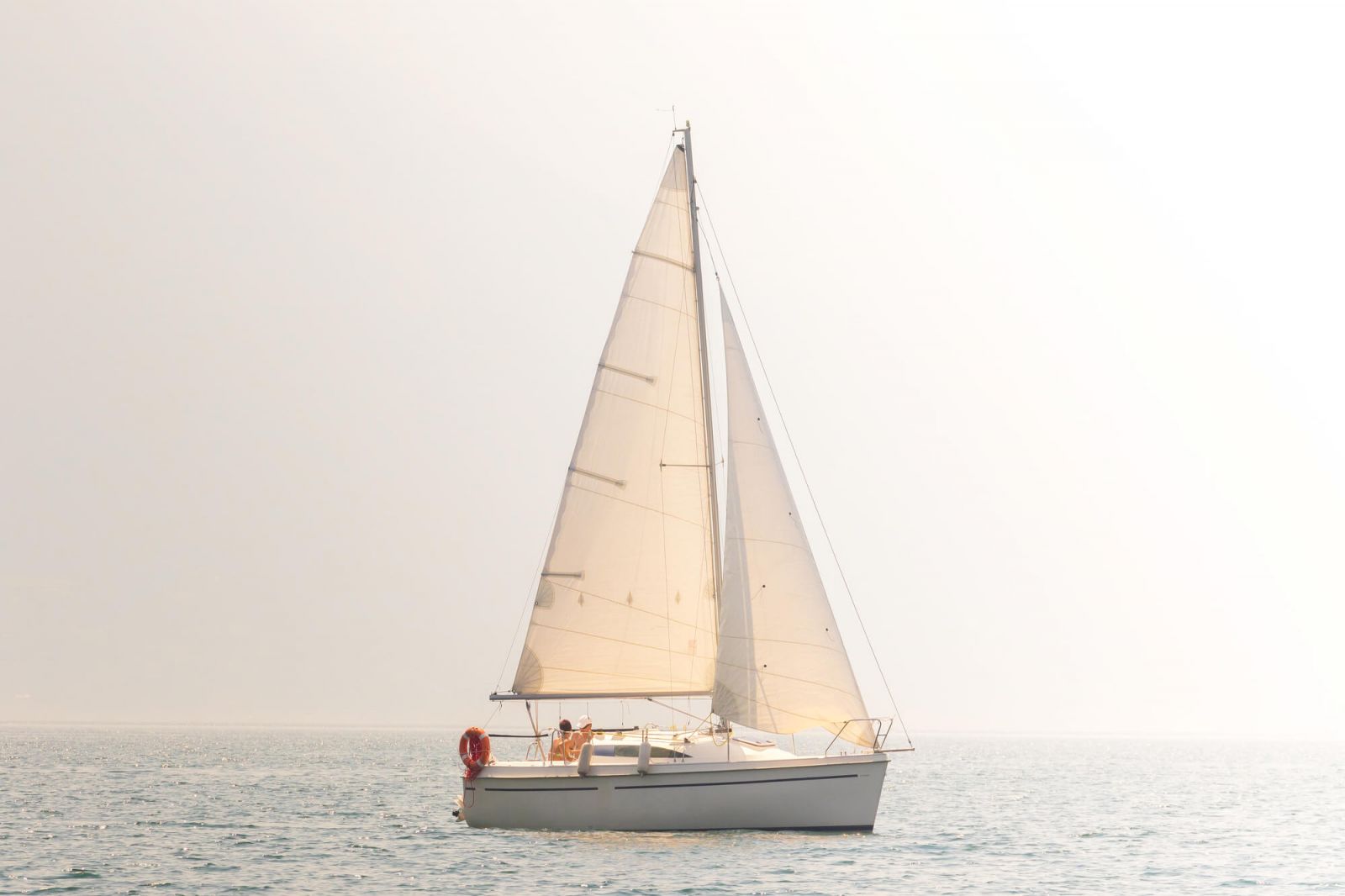
By this, I want to encourage you to get into solo sailing, even if you lack a sailboat that is specifically made for a one-person crew. Quite a few single-handed passages have been done on boats that wouldn't make it to this list because technically, they don't fit the profile. But they were made to be, either with tweaks or with skills. Be honest to yourself regarding your skill level, the boat design, and if it passes the test, go for it.
Happy sailing!
Leave a comment
You may also like, what’s the largest boat one person can operate.
So you're looking for something big, but want to go at it alone. Sailing single-handed (also known as short-handed) is perfectly doable, although not always ideal. …
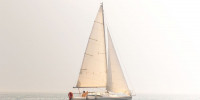
Raising the Mainsail Single Handed: 5 Pro Tips

How Big Should a Sailboat Be to Sail Around the World?

Sail Far Live Free
Top 10 favorite affordable bluewater sailboats.
| CSY 33 |
| Shannon 28 s/v , completing a single handed transatlantic crossing |
| Valiant 32 |
| Welcome home (Fuji 35 cabin) |
| Alajuela 38 |
| Tayana 37 |
| A good look at Mariah 31's transom hung rudder |
| The Westsail 32's full keel means business (photo by ) |
| My kind of math: Baba 30 + tanbark sails = boat porn |
| So functional, so beautiful! |
| HC33t coming at you |
| HC33t sailing far, living free! |
- Blue Water on a Budget: 5 Budget Cruisers for Crossing Oceans
- Go Small and Go Now: 5 Pocket Cruisers to Take you Anywhere
- A Proper StinkPot: Top 5 Pilothouse Motorsailers
- The Voyager's Handbook: The Essential Guide to Blue Water Cruising by Beth Leonard
- How to Sail Around the World: Advice and Ideas for Voyaging Under Sail by Hal Roth
- Twenty Small Boats to Take You Anywhere by John Vigor
Great post... Most of these boats are slow for their waterlines and, for me at least, speed is a factor in safe passagemaking due to the ability to avoid and dodge weather. I want the ability to easily make 7+ knots in all conditions. (I don't take this as a compromise to seakeeping.) One quirk of the HC33: The teak decks were fastened from the bottom up (e.g. through the deck) and the heads were then glassed over. (Not joking.) The tips of the screws pricking your feet is the first clue your decks need replacing. From my dock neighbors entire summer (3 full days per week) this is a truly massive problem to fix and delayed their cruising dream by a year.
timone - Great comments, thanks! I agree, there's a definate choice to make between speed and tank-like toughness. My personal preference for bluewater is a a heavy full keeler, though this may change with experience. Maybe I'm too wrapped up in the asthetics of these classic designs. Good tip on the HC33. I'm leary of teak decks on any boat due to maintenance issues and would prefer any of the above boats without teak decks.
You are on to something with these large dispacement boats. power or sail . they are the best
Semi-bunk. We sailed a Cal 40 all over the SoPac; not the ideal cruiser but certainly seaworthy. Most of our class of 2008 were fin keel, and some form of spade rudder. With the exception of the Valiant and the Tayana, most of these clunkers are better suited to the dock.
Our family sailed the East Coast and Caribbean for two years and I loved our Lord Nelson's teak decks. The teak is first to dry after the morning dew. A small leak disappeared as it swelled in the warm humid tropical weather.
To me to "dodge weather" when you are in the mid of an ocean has little meaning, unless you have a really fast boast like those racers who do the Volvo ocean race. If you are short handed a slow boat will give you a better chance to rest during a storm, which is paramount for safety, while the fast one will wear you out.
A massive...and very expensive problem to fix.
Even ocean racers get caught at sea in bad weather and more the a few have capsized and demasted. No sail boat can outrun the weather. Even motor yachts with huge Diesel engines that can motor at 20-30knots get caught at seas in bad weather. And many times sailing away from shore and weathering the storm at sea is safer then trying to enter a harbor once the blow is there. Many inlets are risky when the current and winds create breaking waves that can swamp a small craft or force it on to the rocky shore attempting to enter. There are times going further away from shore is safer then attempting entry into the harbor. Having a boat that will ride out a storm safely is worth losing a few knots on passage.
Great list! Not sure the HC33 meets your $50k criteria though. I have yet to see it under $75k in decent condition.
Hahn - True enough, finding a HC33t for $50k is a difficult proposition. But the boat is s so beautiful and so well made that I had to include it, even if finding a good one may mean spending $25k more.
Yes the Baba 30 would fit the Boat Porn listing ! I'll tell my wife that's what I'm doing as I sit with blurry vision @ 2am ! Looking at Porn !!
Agreed, the Baba 30 is really beauty. The canoe stern is perfectly in proportion with the rest of the boat and makes for a really sweet profile.
Our good friend has a HC33 and we have a W32. Its amazing how close they are in sailing ability. I think the W32 tracks a tad better and the HC33 is just a hint more nimble, but they are very close in our limited experience. We really love the HC33's pullman berth in the center of the boat but at the same time we don't enjoy the forward head nor do we like the table layout on the HC33 which requires a lot of people to get up if the person furthest in the booth needs to get out. Its a toss up between the HC33 and W32 about interior layout overall. We love the little quarter berth "room" in the HC33 but at the same time you sacrifice a lot of space in the engine room. The W32 gives you a lot better access to the motor. If push came to shove, I'd take the HC33's extra berth instead of the berth in the center of the W32 factory layout. The cockpits are very close in size (read:small). The HC33 has a rounded cabin top that makes sitting on the edges of it more of a pain, but the W32 requires drop boards or water will run into the cockpit. The W32 does win in price competition though. No comparison there. Just wanted to add some thoughts to your post.
Great comments, thanks for sharing Tate. It's always good to hear from someone who has hands-on, side-by-side comparison experience. I agree the forward head on the HC33 isn't ideal, but I do like that it has a stall shower. If price isn't an issue, maybe the real way to decide between the W32 and the HC33 is the size of the crew. The W32 might be the choice for 2, while the HC33 might be better for 3-4 based on having two private sleeping quarters.
Downeaster 32' is a clear contender here, and also wins as most beautiful ;-D and very stable. Also possibly the largest interior per length? Great head room.
Agreed, the Downeaster is a real looker and a lot of boat for 32 feet, particularly given their value pricing on the used market.
I owned a Downeast32. Roomy yes,slow?, yes! Very slow. Had 7 people on her for an overnighter. Storage everywhere. Lots of rear deck space.
I wouldn't say the Downeaster 32 is merely a contender, but possibly an outright winner in the category of "Affordable Bluewater Sailboats",.. ,much more so in fact than 10 boats mentioned in this article,.. at least from the prices I've seen. I honestly don't understand why something like HC33 even gets a mention,.. beautiful? definitely!!!,.. but affordable??!!,, hmm,. not so much.
Fair enough. I included the HC33 because it's one of my all time favorites and the definition of "affordable" is subjective. As I've defined it here, ~$50k. Yes, that's a stretch for the HC33, but I've seen a few approaching that price point. As for the DE32, she's a capable beauty too.
No mention of the Nor'Sea 27.... Should be on the list for sure. :)
I didn't include the Nor'Sea 27 here, but it is in my list of favorite pocket cruisers to take you anywhere .
Hello, I appropriate your reviews. Our family own CSY-33. Now a day, sailing is a completely new sport for me and I wasn't sure what to expect but I've definitely got the bug. thanks all, @Nadia Brightman :)
Glad to hear you're enjoying your CSY 33!
My wife is 5'9" and I 6'3". Which of these wonderful boats would have sufficient headroom and a nice sleeping double for a couple like us?
This is a great post. I just restored a little Hunter 25 and plan to sell it to get something bigger. It's nice to dream! I second the comment about the Downeaster. I love double enders and clipper bows. How about a Bayfield!
Thanks Dan. I like Bayfields (and other Ted Gozzard designs) too, but they're outside my top 10. Thanks for reading.
Bluewater Offshore Cruising Sailboat Bluewater Cruiser New French-built cruiser with a distinctly American look. Here’s an interesting design from Group Finot for Beneteau. I find interesting the fact that this design is not especially “Euro” in its styling. In fact, it’s sort of American looking and good looking too. So, let’s examine this profile in detail. The transom is traditionally raked as opposed to reversed. This eliminates the standard swim step we see so often. But Beneteau has countered this with a drop-down platform that extends about a foot beyond the transom. This platform is raised and lowered by block and tackle. A sliding flush-deck hatch covers the steps when they are not in use. This is an elaborate and very well thought out transom detail that will allow you to bring your dinghy up next to the boat without threatening the gelcoat on the transom edge. This traditionally raked transom really drives the look of this boat. It certainly affects the character of the sheer. I would have liked to see a bolder sweep to this sheer, but it’s fine as is. Note how the tip of the transom is at the waterline. This, combined with the short bow overhang, produces a long sailing length. I think the designers have done a good job of blending the deck structures with the hull. The D/L of this design is 183. L/B is 3.38, making this a moderately beamy boat on the lighter side of medium displacement if we choose 200 to be the middle of current D/Ls for cruising boats. The keel is a bulbed fin giving 5 feet, 11 inches of draft. Note the deep forefoot on this design and the straight line to the canoe body profile. All in all this is a handsome and moderate hull. The interior shows a two-head, two-stateroom layout with the galley in the passageway to the aft cabin. The galley is spread out fore and aft, but it looks to me like there is still plenty of working room. The aft cabin has a large double berth and symmetrically arranged lockers and settees. Why settees? Well, they look good and occupy volume that is not much good for anything else due to the shape of the hull. There is a head with shower stall adjoining the aft cabin. The saloon has a dinette, which to my eye looks on the minimal side. I suppose you could seat four for dinner if you had to, but it would be a tight squeeze. The forward stateroom has a double berth with the toe end cut away to make room for the forward head. I’m not sure how this berth would work for a couple. Obviously, the biggest advantage to center-cockpit boats is the separation of the sleeping accommodations. There is space below the cockpit for the engine room. Putting the cockpit in the middle of the boat allows the designer to place the mainsheet traveler at the end of the boom and place the traveler where it will not interfere with the cockpit layout. This rig is well forward and shows swept spreaders with forward lower shrouds. Unfortunately, the sailplan we have is not carefully drafted so it doesn’t do much for the look of the boat. The photos also show a staysail. This is a very nice looking boat. The windshield is fixed and, while obtrusive in the drawing, looks just fine in the photos. I’m not too keen on the wheel position. It is a bulkhead-mounted wheel offset to starboard, much like we see on cruising catamarans. This means you will sit in one position at the wheel without the benefit of being able to turn 90 degrees or change sides. This wheel arrangement does free up the rest of the cockpit and puts the helmsman securely under the dodger. A teak-capped bulwark adds a rich look to the deck. Beneteau’s boats always deserve a close look. The company obviously puts a lot of market research into its new models. In this case the company has given us a well-designed boat with some unusual features. This is one boat I’ll definitely board Beneteau Wave Rider 42CC at Annapolis.
I wonder if the keel will stay attached
I've saled from the Med to Australia on my own Beneteau Oceanis 42cc and plan to continue the circumnavigation via cape Town to the Caribbean in April 2015. We love our Bene layout... Fun to sail . The center cockpit is Ideal. The aft deck spacious and the aft cabin just wonderful. A huge engine room accommodates all our gear.water maker. Genset. Tools....
Hey, I think a strong case could be made for Bayfield 32 cutters, beautiful boats and pretty bullet proof as well. speed is a bit of an issue! great post!
I single-handed a Bruce Roberts 31 (schooner-rigged) across the Atlantic and back . I was 70 yrs.old, the boat did the work. Also, list the Dreadnought 32 (Tahiti ketch in heavy fg).
I'm intrigued by many of the Roberts designs and metal boats in general, but I don't have any experience with either. The Dreadnought is another really cool and unique double-ender with a lot of character...often available for a bargain price. Thanks for sharing.
Yeah how about some feedback on the Alberg's. They seem worthy & affordable too. Please respond, thx. L
My first true-love in sailboats was the Pearson Triton 28, of course designed by Carl Alberg. As my experience and taste evolved, I began to prefer canoe sterns and slightly more modern designs. The biggest fault I can find with Alberg designs is that many seem to have very narrow beams, making them tight for family cruising. The narrow beams can also contribute to a tender boat. However, Alberg did a fine job of making his designs very sexy with swoopy sheerlines and long overhangs. The Triton, 35 and 37 are all capable and proven offshore boats.
The HC33 shown, Sabbatical. is for sale @ $95,000. Ouch.
Agreed, that's a steep price. I've seen 2 33t's that needed a little TLC sell near $50k. In general, the HC 33t probably has the highest average price of any in my list, but its' such a sweet ride!
You forgot the Allied Seawind 32 for $25,000
Good call! The Seawind II (32') is but one of several Gillmer designs worthy of any "best affordable bluewater cruisers" list. Others include the Southern Cross 28/31/35, Weatherly 32, Aries 32 and Roughwater 32. Perhaps it's time I write a sequel to this post to include the many good recommendations from the comments. Note - I did include the Southern Cross 28 in my post called "Bluewater on a Budget: 5 Budget Cruisers for Crossing Oceans."
there is one you may have over looked! tanzer 10.5 pilot house! not the fastest but with it's swing keel it is a fun wide nice sailing boat!! and great for the island's
I like the Tanzer 10.5, but is she bluewater capable? Definitely a unique look, in a good way. And Tanzer has a good reputation for affordable quality and decent sailing performance.
This is almost the identical boat to a Southerly 10.5 which has made many ocean crossings. Definitely bluewater capable. I own hull # 11 built in 1983 and she has sailed completely around the world spending a lot of time in the South Pacific. She has a righting angle of 140 degrees with the lifting keel up. The hull to deck joint is glassed over on the inside during production resulting in a absolutely solid boat with no joint leaks. The amount of storage is phenomenal for those long passages. I have had her out in 50 knots with no issues. The self tending jib makes single handing easy, and with the keel down to 6.5 feet she handles well.
Could an old Irwin 37 MK I be upgraded so she can be blue water capable? If so...HOW?
I suppose anything COULD be upgraded to bluewater capable, but at what cost? The I37 is known for it's roominess and affordability, but not necessarily offshore capability or robust construction. Irwin's can be fine boats (I owned one for 5 years), but they would not be my choice for bluewater. If you're simply considering passage from Florida to the Bahamas, or some island hopping in the Caribbean, then there are plenty of Irwin's with that under their belt, but an ocean crossing or a run to Bermuda in an I37 should be carefully considered. For more info and specifics about the I37, try Jack Horner's review here: http://www.boatus.com/boatreviews/sail/Irwin37.asp
What about the Irwin 42 Ketch? Is it what you would consider blue water worthy?
What, no mention of the Bill Garden designed Fast Passage 39?
Love the Fast Passage 39 and Garden's original s/v Bolero! Thanks for the addition.
Aah there I am trying hard to decide which one to choose........except I couldn't afford even a model version! So I content myself by saying that at nearly 60 and with no experience wòrth talking about I'm way to old to start now. Youtube and some of the wonderful sailing videos help a bit!
Tashiba 31 is heavy duty double ender good for ocean crossings don't you think? I like the cutaway forefoot.
One of Bob Perry's personal favorite designs, or at least he thinks highly of it. It's also one of his last full keel designs. “I think the Tashiba 31 and 36 mark the best boats I ever designed with modified full keels. The boats were fast, close-winded, stiff, and well balanced. I constantly got calls from owners telling me how they had “beat” a local contemporary design.” (from Yacht Design According to Perry).
Why no mention of the Cabo Rico 34?
James - The Cabo Rico 34 is certainly worthy of this list. In fact, so is the Tiburon 36, the first boat built by Cabo Rico and perhaps a bit more affordable than the 34. The Tiburon is a Crealock design and eventually became the CR 38. Thanks for the addition!
Another good boat is the Gulf 32. Solid build, good tankage, though at this age the 75 gal fuel tank needs serious inspection. William Garden feels it is one of his finest, safest designs!
A boat that is not so well known in European and N.American circles is the Oswald Berckemeyer designed Miura 32.Built strong to cope with South African waters it has been said (though I am not sure how true) that more circumnavigations have been carried out in Miura's than any other class of boat.I owned a Corrida which is the 36foot version of the boat (also designed by Berckemeyer) and I took this boat across the Atlantic without a worry. Strong and fast - I loved that boat.
Hi Mike. I am trying to find drawings, specs and photos of the Corrida 36. Very little available online. Can you point me to anything you are aware of? Thanks.
Did any one mention a DownEast 32? They may be fat and slow, but so is the WestSail 32. Any one agree / dissagree?
Hey I did a post at Urban Nomads about your excellent blog. Check it out here: http://urban-nomads.net/great-boat-living-websites. Thanks for the helpful tips!
The Southern Cross 31 / 35 / 39 really should be on this list. Excellent heavy displacement boats that will take you anywhere.
Agreed. I'm a fan of Southern Cross sailboats and Gilmer designs.
What is your position on an Island Packet 320?
I've never sailed a 320, but I do like IP's in general for their salty style, solid construction and seaworthiness. I particularly like the 320's rig - a cutter is nice for having headsail options and the Hoyt staysail boom keeps things simple. IP's tend to command an upper tier price and aren't known for speed, but if you can get beyond those two factors, the 320 looks to be a nice size and layout for a cruiser.
I love your list. Mine would be very similar, but might include the Endeavour 37. It's hard to beat the price!
I sailed our HC 33 from Alaska to New Zealand on a 5-year cruise. We loved how she handled in heavy weather. We are in the 50+knot "club" and our HC did great while other cruisers suffered dearly. While she isn't fast, she tracked well, and behaved at anchor or hove to. Yes, the teak deck is something to consider, but overall, not a deal breaker in the big picture of off-shore cruising. We sold our HC in New Zealand because I had to return to work. I miss her every day. I am plotting to get another bluewater boat. At this point my short list is another HC or perhaps an Island Packet or Pacific Seacraft. If I were rich, it would be a Najad. These choices are based on our years sailing with other cruisers. While boats are so incredibly expensive, the bottom line is safety at sea, getting parts in exotic locations, and the cost of repairs. The better you are equipped before leaving home port, the less likely you are to have life-threatening problems or serious repairs in expensive locations.
You missed Acapulco 40, so likely never read "One Wave at a Time" by Ed Atkin - regards, Matt
Thanks for the kind word for the Fugi 35. Here's one you can have for under $50k. Needs a little work but is a great boat. miami.craigslist.org/mdc/boa/d/classicblue-water-passage/6479457885.html
I don't see Corbin 39
Thank you for the article it has given me information on my up coming purchase I'm working towards living aboard my own sailboat as I travel the East Coast, Caribbean, South America and West Coast in my retirement years.
I understand this is US based but as a Brit I used to covet the Tradewind 35, a proper long keel, flush decked, cutter rig, blue water cruiser. If money was no object that is the boat for me.
Post a Comment
Popular posts from this blog, go small and go now 5 pocket cruisers to take you anywhere.

Escape to the Sea: How to get from the Great Lakes to the Caribbean

Yachting World
- Digital Edition

The best bluewater multihulls of all time: a complete guide
- Toby Hodges
- October 6, 2021
Toby Hodges and François Tregouet consider the best bluewater multihulls and look at the options for sailing the oceans in spacious comfort

What are the best bluewater multihulls for long term cruising? The one you own, or the one you can afford is the simple answer.
There is a wealth of proven designs to suit bluewater sailing and a variety of budgets. While we have focussed here on the best bluewater multihulls in production, we’ve also included some cracking pedigree multihulls which tour the planet and might occasionally pop up on the brokerage market.
If you can afford to, then pushing towards the 45-50ft length will buy you space, pace and that extra payload capacity needed to take all the items you’d want on your home afloat.
When looking at the best bluewater multihulls, the choice will come down to that perennial balance between comfort/space and speed/weight. Choosing a lighter weight performance design will obviously help you cover distance voyages more rapidly and potentially allow you to outrun weather systems. It means you can sail faster, with less sail up and less load and stress. But you’ll have to sacrifice some luxuries and need to be quite scrupulous about keeping weight down and centralised in order to maintain high average speeds.
For the majority of cruisers, however, it is the amount of space multihulls offer once you’ve reached your destination that really appeals. As well as the non-heeling living area and real estate they provide, they’re well suited to typical tradewind sailing .
If you’re considering your first or next multihull, we hope the following will serve as a taster.
Best bluewater multihulls for performance cruising
Outremer 51/55.
When you think of multihulls designed for bluewater cruising, Outremer will likely be one of the first names that comes to mind. Its heritage lies in building catamarans that can sail fast and are built strong enough to do laps of the globe.
The 51, the current version of which launched three years ago, is an archetypal example of what to look for in terms of blending speed and space is a dream design for a family circumnavigation.
The French yard’s new 55ft VPLP design may look boldly different from its past models, but the philosophy behind it remains the same. It is designed to match windspeed up to 12 knots and Outremer reasons that its ability to sail in 5 knots of breeze will allow it to sail for 95% of the time on a circumnavigation.
Read more about the Outremer 51 and Outremer 55.

Photo: Diego Yriarte
Seawind 1600/1370
For nearly four decades the Australian Seawind brand and its founder Richard Ward have been gearing catamarans around safe bluewater sailing, including performance, protection and ease of handling. Its Reichel Pugh-designed 1600, which launched three years ago, is an elegant looking cat with relatively low, long lines and some smart solutions for fast bluewater sailing.
Seawind also launches its new 1370 later this year, a staggering 60 of which have sold on plans alone.
This first 50 is built from a composite sandwich of basalt fibre, a cloth made from volcanic rock, and PET foam from recycled plastic bottles, which helps to reduce carbon emissions by nearly 50% when compared with traditional glassfibre methods.
This new 50 footer is perhaps a more appealing and practical prospect than Rapido’s previous 60 (with its significant fixed beam), particularly as the amas on this new model can fold to reduce beam to 18ft.
Infused carbon foam sandwich construction is used, along with beams, daggerboards and rudder in pre-preg carbon to keep displacement to 8,200kg.
Read more about the Rapido 50
This OC50 is designed as a more affordable cruising alternative, than the HH models which have preceeded it. This model targets ocean sailing.
It’s still stiffened and strengthened by carbon, but built in vinylester composites with a gelcoat finish. This adds an additional 300kg or so over a full carbon HH50, but cost savings are in the region of $400,000.
Read more about the HH OC50
Balance 526
The 526 launched four years ago, designed to suit short-handed sailors and families looking to sail long distances, hence it can carry large payloads and promises easy maintenance. It looks good too.
Berman’s Versahelm design is a key feature. The wheel cantilevers, allowing the helmsman to steer from outboard with clear sightlines or from the hardtop protection of the aft cockpit.

Photo: Christopher White
Atlantic 47
The A47 suits short-handed fast ocean sailing at an approachable size. Lengthening it to 49ft allowed for an aft cockpit. It is available as a sloop or with White’s patented MastFoil ketch rig – rotating aerofoil masts designed for easy short-handed cruising without sacrificing performance.
Read more about the Atlantic 47
A combination of sharp design from François Perus and high build quality brings plenty of appeal to this sporty Italian-built cat. The first example launched three years ago with a light displacement of 10.5 tonnes, thanks to an E-glass epoxy-infused build with carbon strengthening. The yard offers semi-custom construction and full hybrid packages.
Catana 53/Ocean class 50
Catana’s performance model from 2017, sports twin aft helms (which may not suit ocean sailors), reverse bows and carbon daggerboards. The high topsides help create good bridgedeck clearance and plenty of accommodation. Its new Ocean Class 50 seems more in the shipyard’s bluewater DNA. The light weight, and dynamic and modern shape with slim hulls and a relatively short nacelle suggests a seaworthy nature and high speeds.
Read more about the Catana 53
Best bluewater multihulls for pedigree performance
Veteran multihull designers Morrelli & Melvin designed this smaller model for the Gunboat range. It was built to be more manageable for an owner-driver yet still capable of up to 300-400 mile days.
The Gunboat 48 is something of a rare breed, just six 48s were built between 2004 and 2009. Oh, to have a spare €1.3m right now… one of them is actually on the market.
Read more about the Gunboat 48
At the start of the Millennium, Catana offered fully equipped boats as standard for long distance cruising. The Catana 471 or 472 (one or two helms respectively), represented at the time the optimum in ocean-going catamarans.
Chincogan/Lightwave
Tony Grainger has been drawing fast multihulls for 35 years, including racing trimarans and the Lightwave and Chincogan cruisers. The popular Lightwave 38 has admirable performance and comfort, and the Chincogan 52 (pictured) has the length to clock high average speeds.
Outremer 45 G. Danson
With its characteristic roof, narrow hulls and daggerboards, the Outremer 45 is a standout design which has become somewhat iconic. Despite a rather spartan interior, it has been a great success with fast cruising enthusiasts. On board, family ocean crossings at an average of 10 knots are the norm.
Best bluewater multihulls for family cruising

Photo: Nicolas Claris
The Lagoon 450 remains the most popular model in Lagoons already popular range. It exemplifies the VPLP/Nauta design partnership which has made these the very definition of modern mid-size cruising catamarans which can appeal to families and charterers alike.
Indeed the 450 marked the modern look of Lagoon and was the first with interior styling from Nauta. It originally launched over a decade ago as a flybridge design with central helming position (450F), before this ‘sport top’ option (450S) was offered with a starboard helm station and lower boom.
Read more about the Lagoon 450

Photo: Guilain Grenier
Fountaine Pajot Saona 47
The 47 has a modern shape, with straight bows and a reverse sheer line. It incorporates significant volume in the hulls below the bridgedeck to create room for the optional athwartships cabins. Cabin space is a prime selling point, particularly the owner’s suite to port, where there is also abundant natural light and headroom.

Photo: Tui Marine
Leopard Catamarans, together with designer Simonis Voogd and builder Robertson and Caine, produce the archetypal dual-purpose owner-operator or charter boat in their modern catamaran range.
Key features of the 45 are the amount of light in the saloon and the incredible volume and space on offer in the cabins above the relatively narrow waterlines. Vast social living areas include the flybridge, saloon and dual cockpits.
Read more about the Leopard 45

Photo: www.jfromero.fr
Nautitech Open/Fly 46
During the 1990s and noughties Nautitech earned a good reputation for its elegant catamarans. The 441 is a timeless example and the 44 can be credited with the ongoing trend in hardtop biminis. While its acquisition by Bavaria seven years ago helped Nautitech implement industrial build techniques, the French brand has retained its DNA at its Rochefort sur Mer yard.
The modern Marc Lombard designs have tall rigs with generous square-top mainsails. Twin wheels in the aft quarters of the Open 46 offer a direct feel on the helm, however those spending long periods in the tropics may prefer the shade of the bimini-equipped flybridge option. The layout is also open, with a saloon more outside than in. Styling is clean, modern and simple, and the standard of build and finish are good.

Photo: Olivier Blanchet
First impressions of the Neel 51 are sure to centre on its sheer size and space inside. But as you’ll see from our review of the Neel 43 on page 83, when you sail one overriding impressions quickly centre on its performance.
These trimarans are becoming a popular mass production-built option.

Photo: Christophe Launay
The Excess 11 packs plenty of potential as the smallest yacht offered by the big production yards. A little like the Lagoon 380 of old, it presents a good value new entry-level boat for genuine cruising in a more sporty, modern and enticing design. Some may argue against aft helms for ocean sailing, but those coming from monohulls will appreciate the more direct steering they offer.
Broadblue 385S
Broadblue is a UK brand which offers a distinct line of cruising and Rapier performance catamarans. Its staple 385 packs a lot of cruising comfort into its length, including generous tankage, and has been sailed all over the world. Broadblue built its first electric drive catamaran 12 years ago and offers the only all-electric production sailing catamaran under 40ft in Europe.

Photo: Christophe Breschi
Bali Catspace
For those looking for maximum volume within 40ft, it’ll be hard to beat the Catspace – although it is more of a holiday apartment than a traditional bluewater cruiser. Bali’s garage style sliding aft door does help offer an enormous amount of enclosed (or open) living space.
Best bluewater multihulls for luxury cruising

Photo: Nico Krauss
Privilège 510 Signature
The 510 is designed to take a serious amount of cruising gear – up to six tonnes of it in fact. The excellent helm station now has a fixed windscreen and all lines lead to hand. Finish quality including the electrical installation is first class and Privilege’s trademark, an admirable full beam (26ft) forward cabin, is sumptuous.

Photo: Jérôme Houyvet
Garcia Explocat 52
Garcia Yachts has cornered the market for series-built aluminium monohulls and multihulls in the last decade and this new Explocat 52 is sparking real interest. We ran a full test report in our February issue, describing it as a go-anywhere cat with an enticing combination of space, pace and rugged construction.
Read our review of the Garcia Explocat 52
Built in Argentina, the Antares 44 is the ultimate evolution of a model launched 21 years ago. Entirely dedicated to bluewater cruising, it is the yard’s only model and is constantly being improved according to owner feedback.
Time seems to have no hold on this boatyard and, against the trend, the standard equipment of the Antares 44 is extremely complete

Photo: Richard Langdon
Discovery Bluewater 50
This luxury Bill Dixon design may be a decade old now and into its third iteration, but the concept behind its original appeal remains. For those used to sailing high-end thoroughbred monohulls, here is an option to consider for a comparative level of build quality and fit out when moving to a multihull.
Read more about the Discovery Bluewater 50
St Francis 50 MKII
With this latest version of its original model, this experienced South African builder has optimised a catamaran cut out for the unforgiving seas of the Indian Ocean and the South Atlantic. The MKII allows for an increased load capacity, an important point in long distance cruising.
Xsquisite X5
Intelligent features on the X5 include the protected helm station with glass windscreen, integrated rainwater catcher, UV-protective glass and generous tankage.
Best bluewater multihulls for size & speed
Mcconaghy mc52.
The MC50 (now MC52) was the first and promises some high speed sailing, but it’s the open plan main living deck which will attract the majority. It incorporates an intelligent centreboard system, which hardly affects interior space, but arguably its exposed helms at the aft end of the flybridge will not suit serious ocean cruising.

Photo: Florian H. Talles
HH in Xiamen is building some really impressive large, luxury fast cats up to 90ft. This was its second model to launch, a high-end, high performance Morelli & Melvin design capable of rapid passagemaking speeds and enjoyable regatta sailing. Features include C-shaped boards and central or aft helms.

Photo: Mike Jones/Waterline Media

Ocean Explorer 60
If Nautor’s Swan made catamarans, they may look like this… The Ocean Explorer 60 uses the same designer in German Frers and some of the same builders who worked at the famous Finnish yard to produce this world cruiser. The resultant quality shines through. A new OE72 is due soon.
Kinetic KC54
A young company with plenty of experience, Kinetic produces custom fast ocean cruisers, which can occasionally race. Its 62 is a serious performance vessel with carbon hulls, rigs and rigging, daggerboards or centreboards. With fast bluewater cruising the goal, carbon is used to minimise weight so features/toys can still be added. The swim platform and hardware on the newly launched 54 weighs just 90kg, and the generous sized tanks are all in carbon too. Views from the saloon and forward cockpit also look special.
Best bluewater multihulls for ultimate performance
Marsaudon ts4/orc 42.
Few catamaran builders produce genuine performance cruisers at this ‘smaller’ size: this one is kept minimalist and light weight (around 6 tonnes) – the yard’s philosophy is ‘simplicity, then add lightness.’ The 42 is a cruiser-racer with the ability to outpace most yachts across the Atlantic, win a regatta and still offer some space for island hopping. Standard tankage is minimal however. Marsaudon recently rebranded its TS range to Ocean Rider Catamarans (ORCs) and has an ORC 57 in build.
Dazcat 1495
Dazcat builds fast, seaworthy cats from its Multihull Centre in Cornwall. The 1495 is a true ocean cruiser-racer, which is stiff and rewarding to sail, with direct steering linked to carbon rudders. The 1495 can hit 20+ knot speeds with relative ease, but it is the consistent high average speeds which will attract those looking to cover serious miles. Weight is centralised including engines, tanks, and systems all located amidships to help reduce pitching. Dazcat has a semi-custom build approach and creates all sorts of weird and wonderful craft for all abilities.
Dragonfly 40
Dragonfly trimarans are known for their high quality construction and ability to delight sailors with their ease of planing speeds. For those who can live without the space of similar length cats, the new flagship 40 is large enough to offer cruising space, while folding outriggers and retractable appendages mean you can dry out where others wouldn’t dare.
Looping 45/Freydis 48
These two designs by Erik Lerouge both offer a high-performance vision of ocean cruising. The Loopings were built individually and the Freydis in small series, and on both you can sail as fast as the wind in complete safety. Interior quality depends on whether finished by an amateur or by a shipyard.
Swisscat 48
An attractive combination of luxury, comfort and performance, the S48 is a stiff, go-anywhere premium cat that is easy to manage single-handed. The lightweight build (11t) is in epoxy infusion with carbon reinforcement.
Schionning Designs
Jeff Schionning has catamaran design in his blood. His designs exude performance and seaworthiness with flowing, even aerodynamic lines. On all tradewind routes you’ll find a G-Force (models from 12m to 23m) or an Arrow (12m to 15m) sailing more quickly than the rest. His latest venture is with Current Marine in Knysna, South Africa.
Best bluewater multihulls for pedigree cruising
The long-time best-seller from the world leader in catamarans, with more than 1,000 produced over almost 20 years from 1999. With its characteristic vertical windows, the 380 and its big brother the 410 made the purists scream when they were presented. But the 380 proved a pioneer of its kind. Safe bow volumes and light displacement (7,260 kg) helped its seaworthy behaviour. The high number of boats on the market makes this the most affordable bluewater cruising multihull for its size, even if price range is as wide as condition is variable.
Casamance 44/46
Between 44ft and 46ft depending on the year of construction and the length of its transoms, the Casamance was an impressive catamaran on launch in 1985. The design by Joubert/Nivelt offered good volume and load capacity. Of the 490 units produced, many joined the charter fleets. The exterior of the Casamance is dated, but the interior in grey ceruse oak has retained plenty of charm.
If you enjoyed this….
Yachting World is the world’s leading magazine for bluewater cruisers and offshore sailors. Every month we have inspirational adventures and practical features to help you realise your sailing dreams. Build your knowledge with a subscription delivered to your door. See our latest offers and save at least 30% off the cover price.
The perfect bluewater sailboat
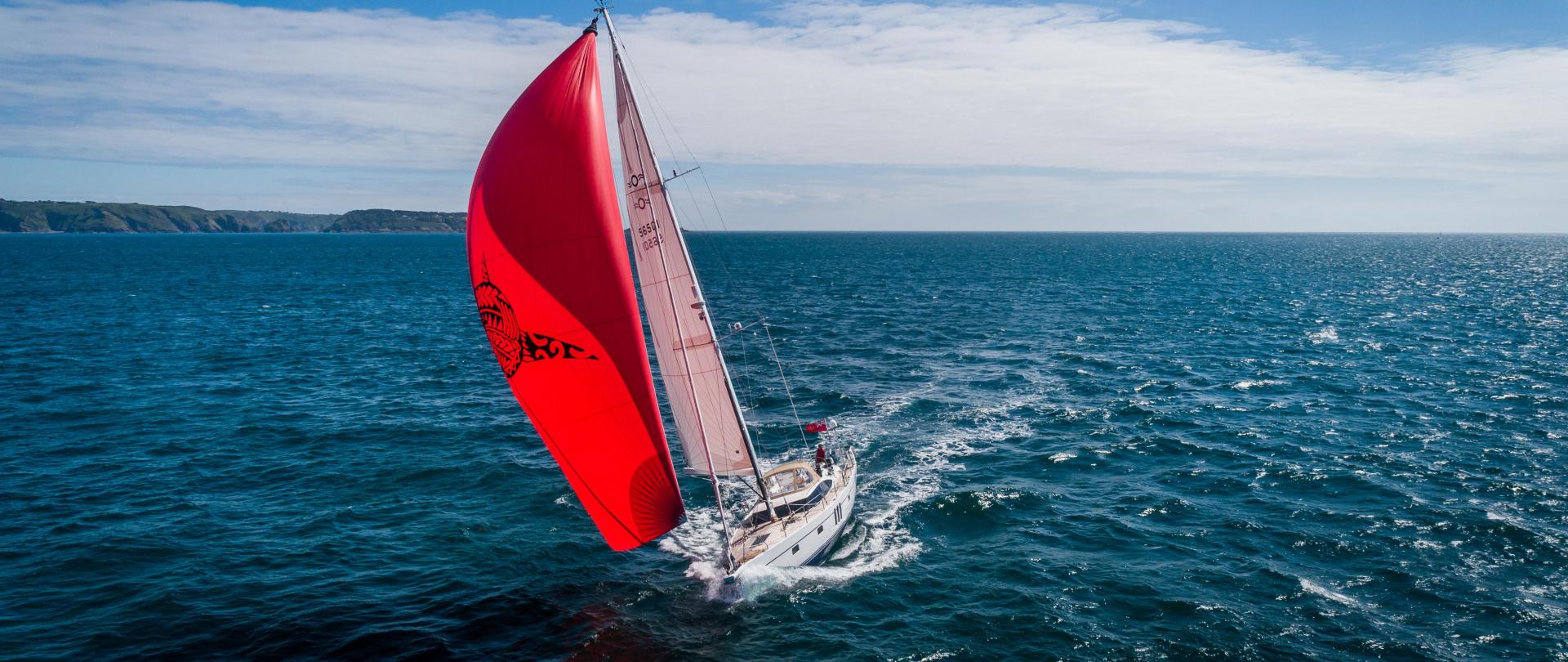
By Elaine Bunting
What makes the ideal yacht for ocean adventures and long distance voyaging elaine bunting investigates..
If your dream is to sail across oceans or even around the world, what is the right yacht? What type and size should you look for? And what equipment is going to add most to your safety and enjoyment of life on board?
The answers to these questions will define your experience and are going to vary depending on your budget, how long you intend to be away, and with whom you’ll be sailing. There are however some common denominators you’ll need to think about to sail safely and comfortably.
First, the fundamentals of a true bluewater yacht: its design and sea-keeping attributes. A good bluewater sailboat is capable of making long passages in comfort and will look after you in whatever conditions you encounter.
Oyster Yachts are renowned for their adventuring credentials; the yachts are well-found, luxurious and solidly built. About 95 have already circumnavigated the world and with another 25 participating in the Oyster World Rally 2022-23 soon Oysters will have logged over 100 successful circumnavigations. Starting with the fundamentals, they have hulls with integrated keels, are certified for strength and safety, and have keel-stepped masts. They are designed with self-sufficiency in mind and have generous accommodation and tankage for long ranges. Equipment is over-specified, from rig and steering gear to winches and windlasses, and there is easy access to systems and machinery.
Discover the perfect yacht for ocean adventures, highlighting key design features and insights from experienced sailors. Learn how to embark on an incredible long-distance voyage.
- Learn about the essential features and characteristics of a bluewater cruiser.
- Explore the design elements that contribute to comfort and safety during extended passages.
- Find out why Oyster Yachts are renowned for their adventuring credentials.
- Understand the significance of size when choosing a yacht for long-term cruising.
- Get insights into the equipment, systems, and communication tools crucial for a successful voyage.
- Learn about the importance of after-sales support and preparation for long-distance cruising.
- Uncover the wisdom and encouragement from experienced bluewater sailors to embrace the adventure of a lifetime.
The evolution of every design in the last 24 years is linked by a common thread: Humphreys Yacht Design. Renowned yacht designer Rob Humphreys is at the helm, working closely for the last 15 years with son Tom, a Fellow of the Royal Institute of Naval Architects.
The primary job of a bluewater yacht, says Humphreys, is to be capable of being sailed by a shorthanded crew. It has to be easily handled, comfortable at sea on long passages yet capable of a reliable turn of speed that will make the miles slip by without great effort.
“The motion of the boat is important. Performance is important, too, but less so – comfort is more telling,” Humphreys explains. He favours a hull shape with “shallower rocker forward and a deeper mid-section to distribute the volume, which creates that softer ride.”
Moderate displacement yachts such as Oysters are born passagemakers. The hull form is not only capable of producing reliable daily mileages on passage in comfort, without stressing crew or yacht, but can accommodate generous fuel and water tanks and bluewater critical items such as generator, large battery bank, washing machine and air conditioning. It also provides excellent internal stowage for stores and spares and ample locker space externally in sail locker and lazarettes.
“Control and manageability and the steering qualities are also important so there is less burden on autopilot systems. And the other side of it is that a yacht should have good load carrying abilities for stores and spares.”
The latest generation hull shapes, with plumb stems and beam carried right aft, not only look purposeful, they create a larger interior and can sail faster and more efficiently. A long waterline and greater hull volume means more accommodation in the bow area, but most particularly aft. That wider shape also benefits a yacht in pure sailing terms.
“Increased power aft helps with free stability,” Humphreys explains. “Stability is generated through hull form and is not so much dependent on the mechanical stability of the lead [on the keel]. So, in that respect, these boats are a little bit more powerful, a benefit all round, but particularly when sailing upwind and close reaching.”
Wide hull shapes are also suited to twin rudders, which in turn, says Humphreys, “gives fingertip control and makes a boat easy to steer.”
These evolutions can be traced back to race yacht design, as can the plumb bow. “That is another aspect of hull form that has translated well,” says Humphreys. “More vertical bows give you more waterline length, and that is always working for you. It gives you a better chance of sustained daily mileages, of reliable speed rather than exceptional speed.”
These latest designs also have increased freeboard, which means it is possible for yachts to have a flush foredeck for aesthetic and practical reasons, yet also really good headroom below. For Oyster Yachts it has allowed large vertical ‘seascape’ windows that let in light and connect cabins with the world and the views outside.
Other features that distinguish the true bluewater cruiser are a safe, protected and well-sheltered cockpit and helm stations, with sail controls led back; a good galley that is easy to use and secure at sea; a practical and comfortable navigation area; and clear and uncluttered sidedecks and foredeck.
The centre cockpit design that is a hallmark of Oyster Yachts is comfortable for long-distance cruise and “provides protection while sailing and entertaining in port, and is great in terms of overall visibility,” affirms owner Stephen Gratton. Stephen and his wife, Debbie, sailed around the world in their Oyster 53, Amelie, then returned through the Panama Canal to Canada and Alaska, sailed back across the Pacific to French Polynesia and are currently in Seattle.
“We have been in some extreme conditions, but even when things go wrong we know that Amelie can look after us. The comfort is great. Even in a gale, when you go below it all goes quiet. You feel like you are on a well-made boat and we like the solidity of design and thoughtfulness.”
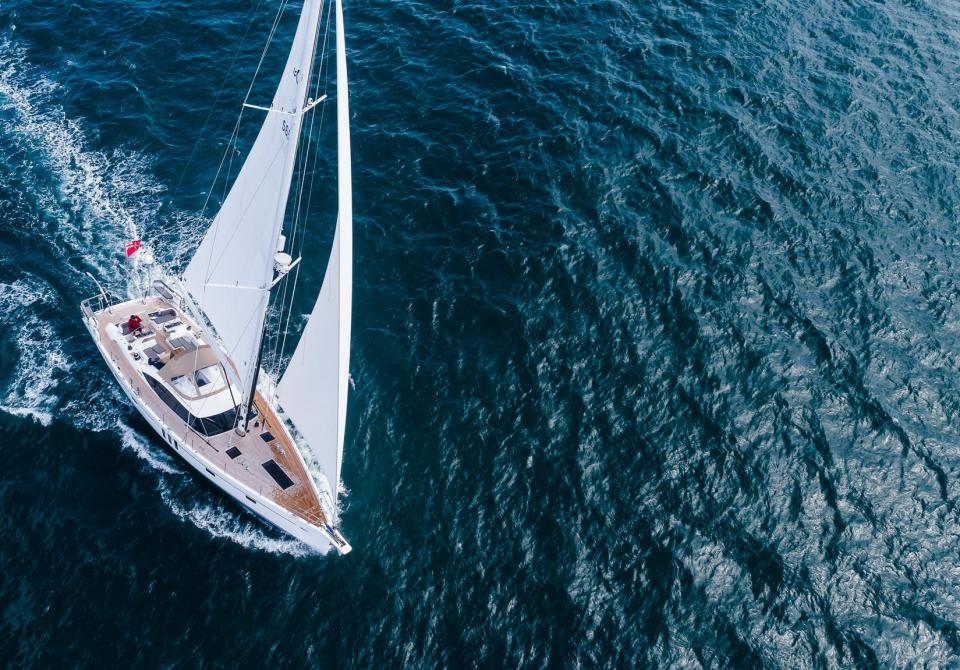
Other attributes that mark out a capable, go-anywhere bluewater boat include a galley that is safe, secure and easy to work in. The linear galley that is a feature of Oyster yachts is designed to be a seamanlike and usable space at sea, with abundant fridge and freezer capacity, and plentiful space for food stowage.
Similarly, a secure navigation area and chart table that is comfortable, safe and inviting to use at sea is also essential, as is a powerful, reliable propulsion system, large battery banks and multiple means of power generation.
Shade and ventilation are very important for sailing in the Tropics. Oyster Yachts is the only builder to offer front saloon windows that open out to allow cooling air to circulate through the boat, and one of the few builders that still fits dorade vents for forced ventilation.
Every element is solidly built and made to last for hundreds of thousands of miles of sailing in all conditions. Above all, it the solidity of the design and strength of build that owners point to when describing what they most cherish about their yachts.
“One of the things that is very important is to be able to trust your boat under all circumstances and be well prepared for bad weather,” comments Leo Nagtegaal, another round-the-world skipper, and owner of Oyster 625 Bubbles. “Your boat is actually one of the safest places to be.
What size yacht is best?
While small yachts can, and do, cross oceans, a moderate displacement, higher volume yacht has all the advantages for long-term cruising. A sweet spot for ocean cruisers lies between 45ft and 65ft. Yachts in this range can accommodate the comforts, stores and spares a crew of family and friends needs whilst also making quick passage times.
Larger yachts, fitted with hydraulic furling and electric winches, can still be sailed by a short-handed family crew, though beyond 65ft loads increase with size, maintenance demands grow too and it may require the help of professional crew.
When Leo Nagtegaal sold his business, he and his wife, Karin, bought an Oyster 56, Duchess. In 2013 they set off to realise Leo’s lifelong dream of sailing around the world.
The Nagtegaals loved the sailing life and people so much that, in 2014, they traded up to an Oyster 625. “We thought that as we’d be pretty much living aboard nine months of the year for the next five, six or seven years, we’d like just a little more space,” says Leo.
In his opinion, 45ft is the minimum size for long-term ocean voyaging: “Size is very personal,” he admits. “I have friends who went around Cape Horn in a 33ft wooden boat and did well, so they will disagree when I say that a bluewater yacht should be at least 45ft. It really depends on how the boat is equipped.”
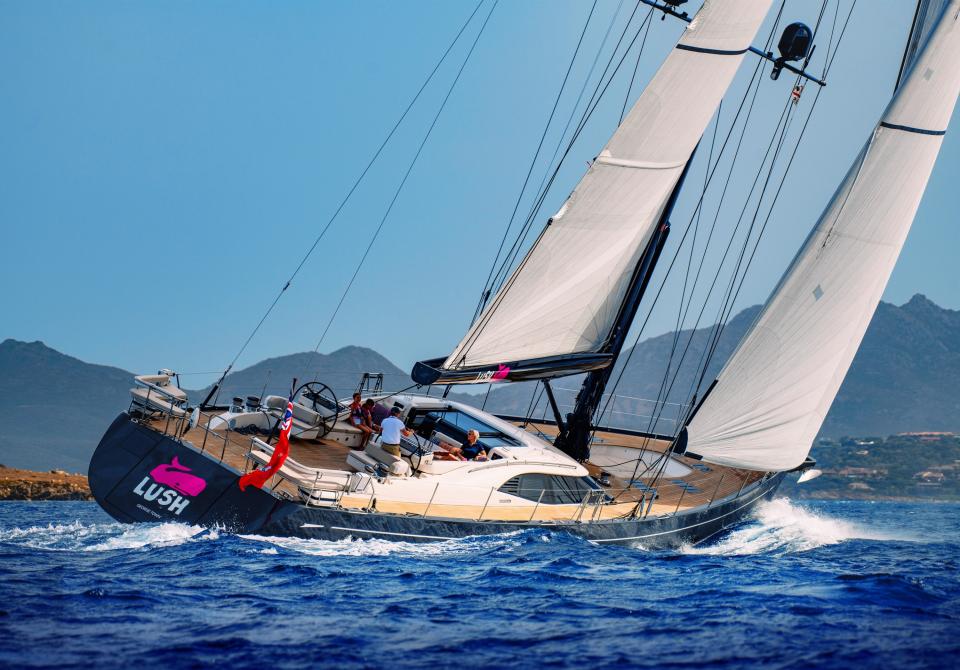
Paul and Trish Ducker also sailed on the Oyster World Rally 2013-14 as far as New Zealand. They have ordered a new Oyster 565 and hope to take part in the 2024-25 rally. Their cruising is mainly done double-handed. “We don’t want anyone else living on board; we like the privacy and freedom,” Paul explains.
“For us, at the time about 54ft is as large as we wanted to go. Up to 60ft would be fine, but as you get older you are not so fit and strong and it tends to affect things like taking down sails and jumping around the boat coming into a marina.” On their new Oyster, they will have a bow and stern thruster to make close quarters manoeuvring easier, and headsails they can pole out for stress-free downwind passages.
Stephen and Debbie Gratton have owned six different yachts. Before buying their Oyster 53 Amelie in 2008, they owned a Contessa 32, which Stephen raced across the Atlantic in the single-handed OSTAR race. To enjoy cruising as a way of life, however, they knew they needed to change from their pretty but cramped design to a much bigger, more solidly built, heavier displacement yacht.
“Originally we thought anything over 40ft was OK for ocean passages and we thought about having a boat built for sailing round the world,” says Stephen. “But it was not going to be able to provide many creature comforts for my wife and me and we started realising that you get more comfort when a boat is over 50ft,” says Stephen.
Gratton emphasises the benefits of a bigger yacht size beyond merely space inside. “You have better ability to take the waves — the hull shape and distance between waves can all make a difference. Hull design is so important.”
Stephen Haines took delivery of his new Oyster 565, Panthalassa, in 2019. He has been planning a circumnavigation “for many, many years”. Unusually, Panthalassa represents a downsizing for Haines. He previously owned a 40m Huisman which he sailed with his young family all over the Mediterranean, the Caribbean, Bahamas and US east coast. On the Huisman, Haines had had professional crew, but for his round the world voyage he wants to skipper and run the boat himself. “Having crew on board changes the dynamics and it is not the same,” he says. “When you are employing people it takes quite a long time to make your boat a home as there a lot of people around. It can be hard work.”
Haines says the 565 is “the perfect size for me” and says: “I wouldn’t swap with a bigger boat. In terms of build quality an Oyster is right up there, strong with a good reputation. My Huisman was a one-off, but the more 565s they build, the happier I am. It is easier to get spares and it adds to the residual value.
“I bought the boat to go across oceans and for me it is about the motion of the boat. Panthalassa sits on the water like a much, much bigger boat and in a big sea I have been impressed with her seakeeping.”
what equipment do you need?
From sails to power management and electronics, a multitude of choices shape the ideal bluewater cruiser. The sail inventory, for example, is part of personalising your boat and will depend on how many crew you have and how you like to sail.
The majority of ocean crossings on a tradewinds circumnavigation are on reaching and running angles. A suitable downwind set up can be as simple as the mainsail and a poled-out genoa, or it could be twin headsails set to run day after day. Or you might want to add more power and speed with an asymmetric spinnaker on a furler, or a specialised spinnaker such as the Parasailor.
Ideally, you would have multiple off-wind sail options (including for regattas if you plan to race) and upwind sails that can easily be reefed. In-mast furling, automated systems and electric winches take all the hard work out of reducing sail.
The latest Oysters and other modern cruising designs feature bowsprits that allow an additional light wind Code Sail to be set on a furler so you can keep sailing instead of turning on the engine. But whatever you add to the inventory, the important thing is to have sails that you want to use and don’t find daunting.
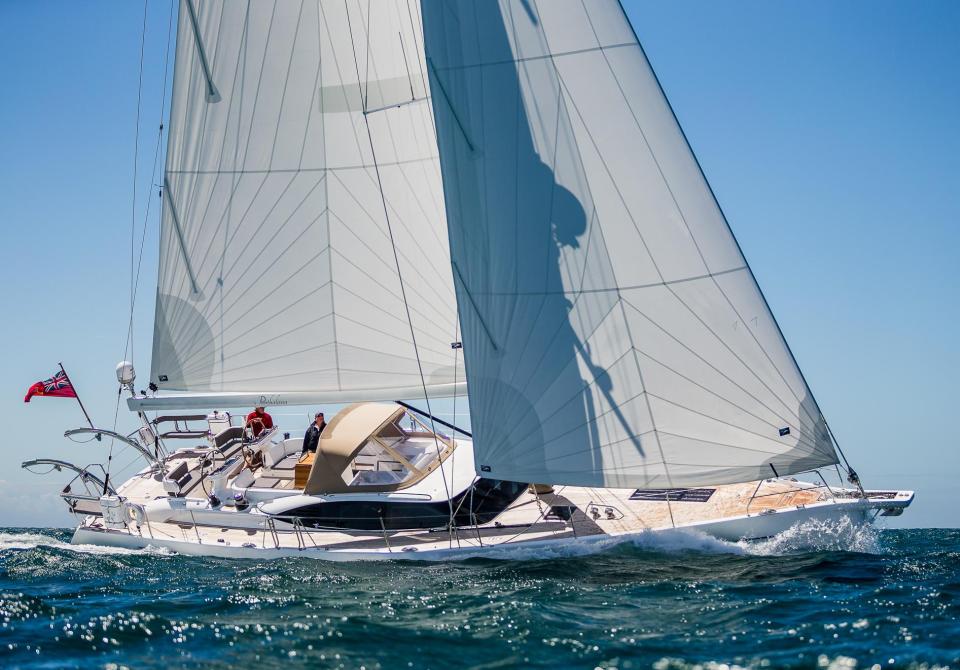
High on the list of essentials is a robust windlass that can handle as large an anchor as possible, ground tackle of up to 100 or 120m for anchoring in deep bays, and a second kedge anchor. The CQR type is ever popular, though many Oyster owners opt for a Rocna or upgrade to the stainless steel Ultra anchor, says Durham.
Power management is one the biggest and most critical issues boat owners face. “Questions about power come up all the time. Power management is key, and trying to use as little as possible,” says Mark Durham. Most Oyster owners opt for a generator, but are increasingly looking at diversifying power sources with solar and hydro power also charging high capacity lithium ion batteries.
“It is about trying to use as many different methods of power generation as you can, for example wind generators, hydrogenerators or solar panels,” says Durham. Alternative energy sources not only reduce emissions and the consumption of fossil fuels, they also allow longer periods of silent running and extend generator service intervals.
“We are doing a fantastic project at the moment on Oyster 725 hull number 1, putting solar panels on the hard top so [the owner] will not have to use his generator as often,” says Mark Durham. “He has got 12 lithium-ion batteries giving 2400Ah. Previously he was using his generator in the morning and evening to charge batteries and make water, now all systems can be run off batteries that are charged by the solar panels, and the generator is run rarely.
Now, with 24v watermakers we can run them off the batteries, which can be charged by solar power.”
“This is a really interesting part of the planning and many owners are enjoying the process of using less diesel.”
Power upgrades are always a worthwhile element of a refit. Stephen Gratton says that fitting a new 5kW inverter and 400 A/h of lithium ion batteries to his Oyster 53 is “the biggest change we have made in the 13 years we have had our boat. I would say that the ability to have big gaps between charging and the silence when cooking is one of the best things.”
Leo Nagtegaal also upgraded the inverter on his Oyster 625, Bubbles, to a 5kW unit and has solar panels on his hard-top bimini. “That provides two-thirds of my power needs. I can run more equipment, for example the washing machine and other appliances, so that was a big improvement,” he says.
A watermaker is a prized item on bluewater cruisers of all sizes, giving crews independence from shore. A reliable, well-specc'ed autopilot that has a fast speed of response downwind, with back-up spares, is essential. Bow thrusters and even stern thrusters are increasingly popular, especially for couples who sail two-up frequently.
Communications is critical for almost all long-term cruisers. Satellite comms and on board Wi-Fi networks not only make it simple to keep in touch with home, friends and work but to get detailed real-time weather data and forecasts, and even repair advice and downloads. SSB radio, dated technology though it undoubtedly is, also remains popular with crews who live aboard for lengthy periods – this is still a good way to connect with the cruising community and the camaraderie and help it offers.
“We use Iridium for weather data and emergencies, but for us SSB is something we enjoy using,” says Stephen Gratton. “We came up from French Polynesia to the Pacific North West this year and were part of a [radio] net and we had our last discussion the night before we arrived in the Juan De Fuca Strait, 4,000 miles away. It really felt like people there were thinking about you.”
For getting ashore, and as a transport workhorse when at anchor, everyone needs a sturdy tender and reliable outboard that can easily be brought aboard and stowed away. Solid floor inflatables or small RIBs are the best choice, stored securely on davits, or mounted on the foredeck.
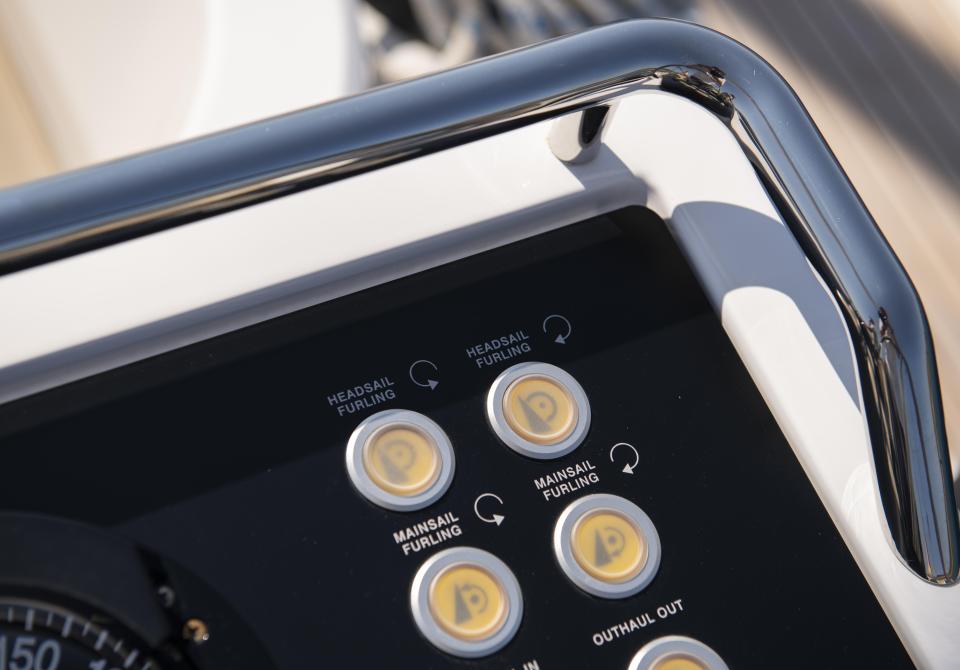
Making your yacht a home from home
On an extended voyage, your yacht is your home, a place to entertain guests and enjoy visits from friends and family. Comforts are important and, unsurprisingly, all the cruisers we spoke to advised having as many of them as possible.
Paul and Trish Ducker have lived aboard their Oyster 54, Babe, almost full-time since she was launched in 2011. For their new boat, an Oyster 565 currently in build, they are going for “all the mod cons”.
While accepting that high equipment levels may bring increased demands in terms of maintenance, Paul says: “It is our home, so we want everything, from air-con to a water maker to a washing machine."
“I would say,” he adds, “everything generally on Oysters is useful even if is not essential.” At the top of the Duckers’ priority list are a large capacity fridge and freezer; sufficient power to run a washing machine; air conditioning from time to time; an electric cooker; and entertainment equipment.
Stephen and Debbie Gratton also mention an electric hob and cooker. "It really works for us. Food is a very important part of our enjoyment at sea and entertainment with friends. The change to lithium batteries was a game changer for us as we can use any of these appliances with just the inverter.”
Andy Armshaw is one of Oyster Yacht’s most experienced project managers, helping owners make the right choices for comfortable cruising. “Good galley set-ups are important,” he agrees. “Most people now go for a Quooker boiling water tap so there is no need to put a kettle on or a pan on the stove. More people are definitely looking at fitting an induction hob and there is a move away from gas, not only from the safety point of view but getting a refill in different places.”
Owners want “really well-appointed heads, and generally want what they have at home, such as fixed head rain showers. They also expect their boat to be comfortable, and we offer a choice of soft furnishings, fabrics and timbers. Also sprung mattresses, because one of the most valuable things on board is rest.”
Good lee cloths are needed for sea berths and are worth fitting in the saloon as well as in cabins. “Sometimes people in forward cabins will migrate aft at sea,” observes Armshaw.
A bimini that can be kept up on passage will keep crew shaded from the sun. A canvas sunshade for covering the cockpit and perhaps also the foredeck will extend your outdoor living area in the Tropics. The biminis and sprayhoods fitted to Oyster yachts are also extremely solid and to be kept up permanently while sailing.
When he was spec’ing his new Oyster 565 Panthalassa, Stephen Haines thought: “If I am going to be living on it and sailing round the world, quite honestly give me everything. I want the icemaker, nice mattresses, a washing machine, a tumble dryer. I got almost everything you can get. It’s nice to have everything – why not?
Like everyone we spoke to, Haines admits that maintenance comes with the territory. What makes the biggest difference to an owner is having excellent after sales support and advice at the end of a phone line.
“I have learned more about that in the last two years than in the rest of my life and now I’m living on the boat it has become daily life. But you only have to get Oyster Yachts on the phone, and they can talk me through it. I reckon it took nearly a full season to really get to this stage and really know my boat inside out and back to front.
“Now, I am very comfortable. I know my boat can cope with any conditions. If she could speak, I think Panthalassa would say ‘There’s nothing to worry about’.”
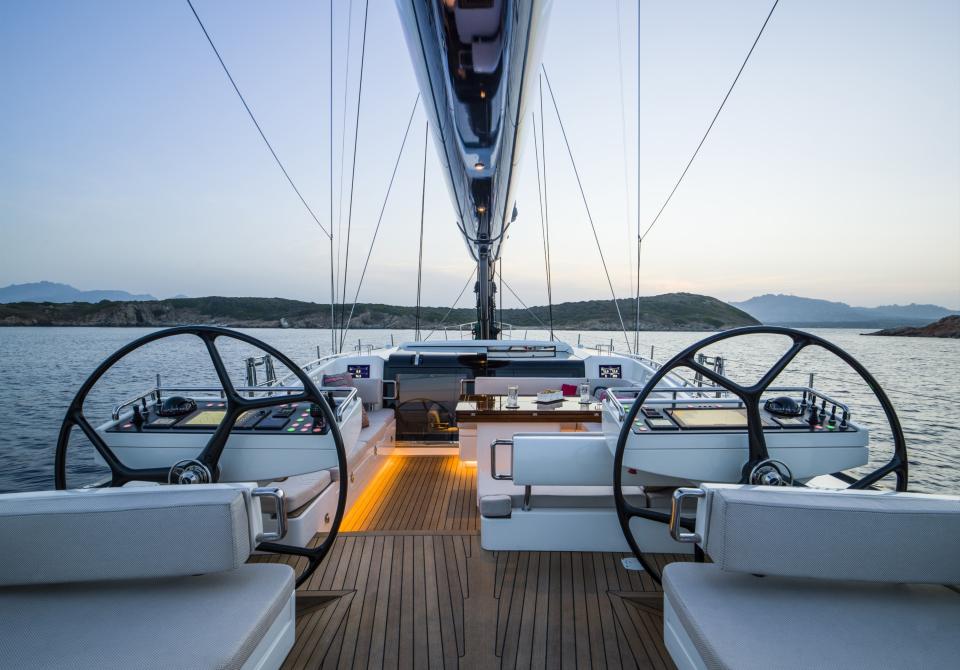
Get ready to go
How long does it take to prepare to cast the lines off and go cruising? Typically, owners getting ready to go off for an Atlantic crossing or further, take a season or two to prepare, though I have met many people who have successfully done it much quicker. A longer runway, however, allows you to spec your boat, trial it thoroughly, and get your life organised for leaving.
Some owners advocate a year of home waters cruising before going further afield. For example, Leo Nagtegaal had his Oyster 56 Duchess shipped to Singapore, where he was working, and sailed from there for several years until taking full retirement and joining the Oyster World Rally 2013-14. A period of shorter-range cruising allows the whole crew to gain the knowledge, training and skills needed, including essential maintenance know-how and medical and sea survival training – and to understand your boat inside out.
But however, you plan to break free, what really helps is a deadline: a date that you are going to set off, with a scene you can visualise to keep you motivated as you work through the preparations and demands of shore life. Most preparations are really just logistics, and you’re probably already pretty good at that. The bigger obstacle is often mustering the courage to leave.
Preparing a bluewater yacht and all that is needed to set free and go is a complex project, but you’ll have plenty of good help and advice along the way. I have yet to talk to anyone who has regretted it. When I ask bluewater sailors for their best advice, it usually boils down to a simple prescription: just go. Life is too short to put off your dreams.
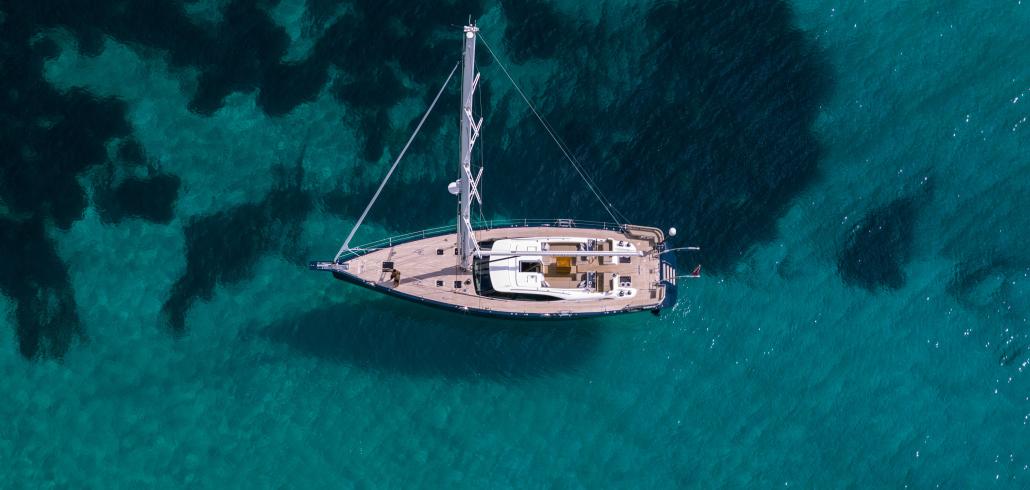
Explore the Oyster fleet
More stories.
Read more inspiring stories from the world of Oyster
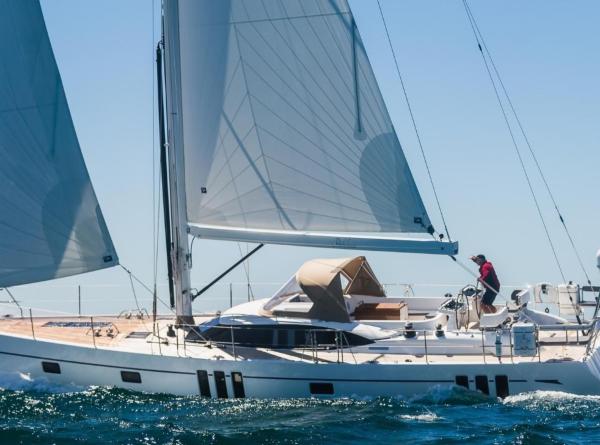
Sign up to our newsletter
Be the first to hear about new launches, exclusive events and all things Oyster
© 2024 OYSTER YACHTS
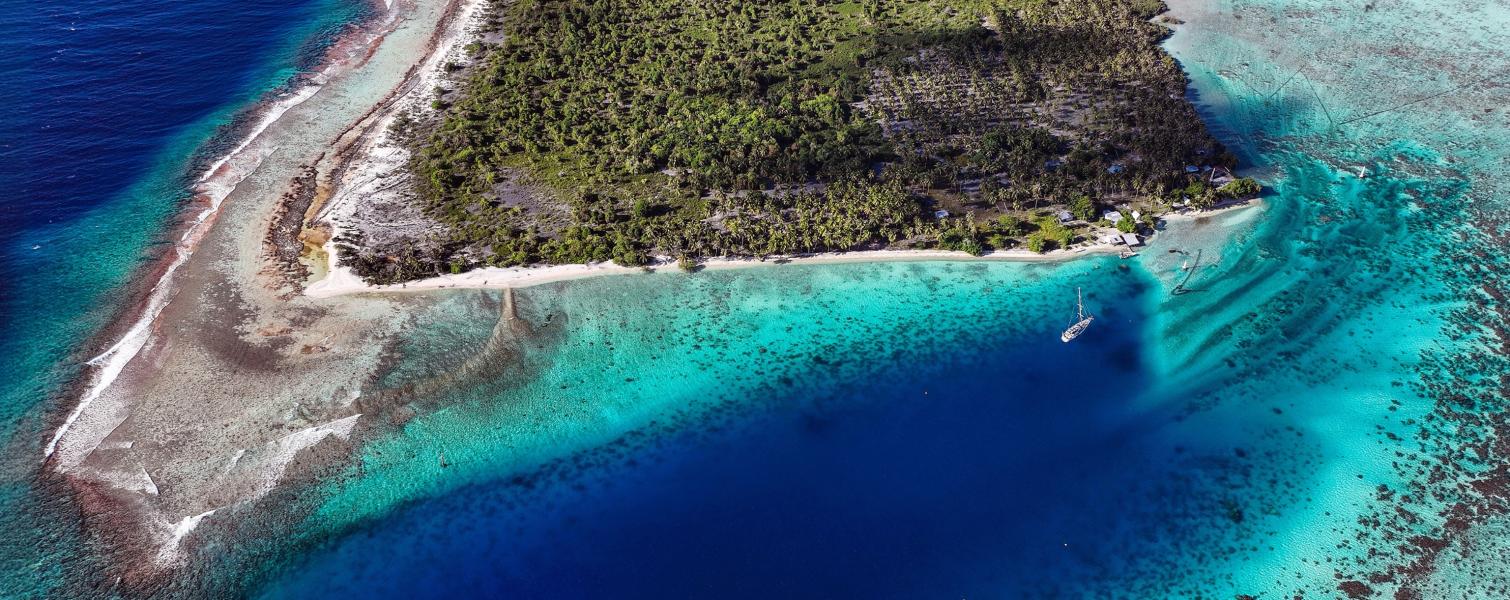
OYSTER WORLD RALLY
Entries for the Oyster World Rally 2028-29 are now open. Embark on the sailing adventure of a lifetime
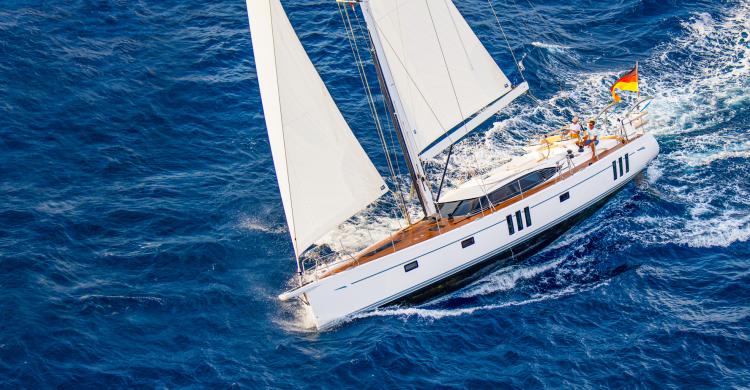
The new 565 Series II
The pursuit of perfection continues
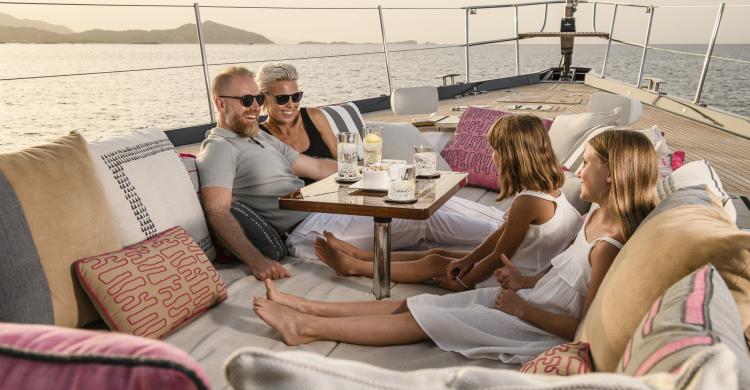
Oyster Charter
Experience exhilarating sailing, luxury and style on an Oyster charter

New 565 Series II
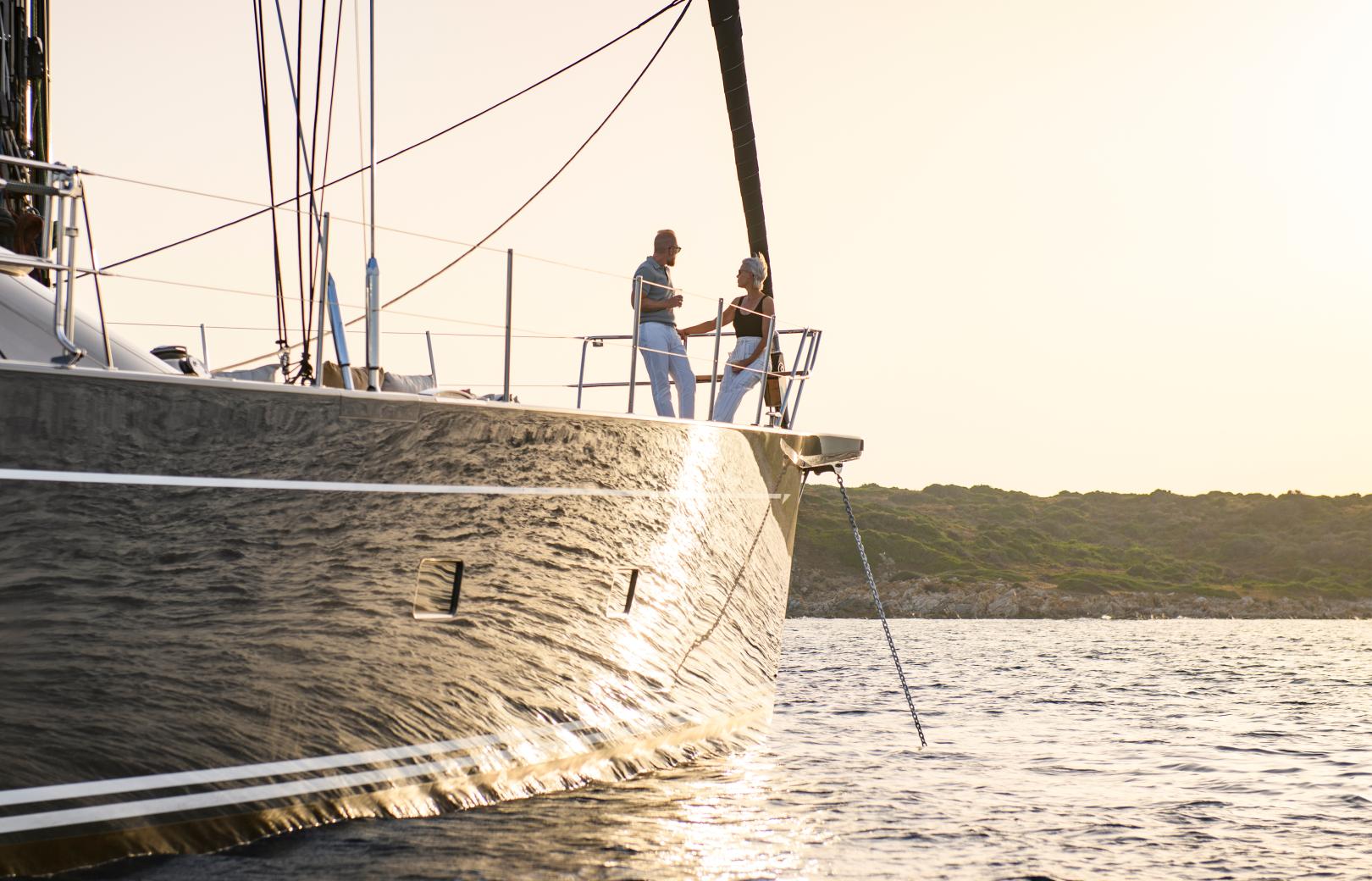
LUXURY CHARTER
Experience exhilarating sailing, luxury and style on an oyster charter. personal, exclusive and uniquely oyster.
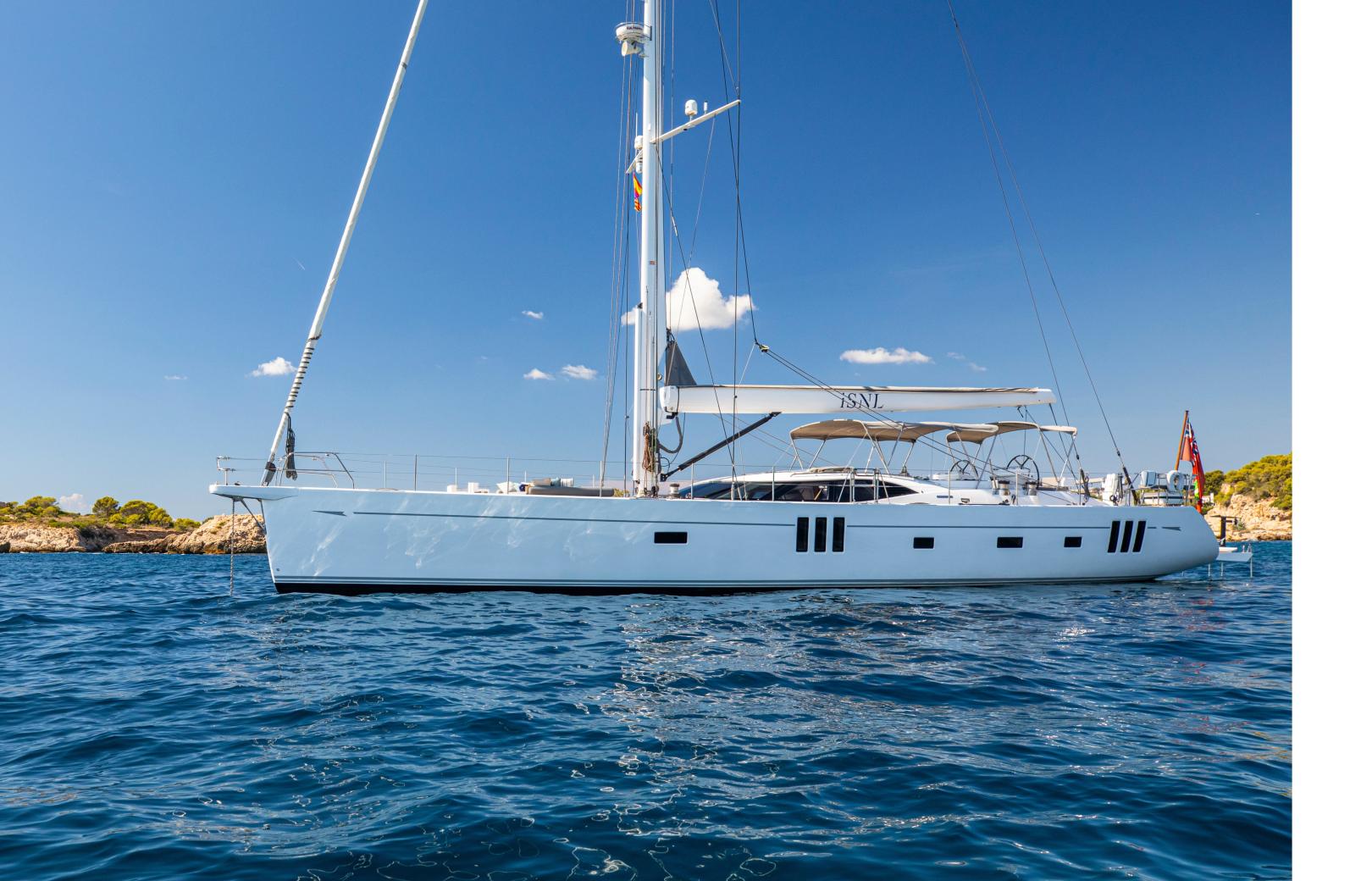
Oyster 825 iSNL
Discover this exceptional late model 825 with a unbeatable spec and a bespoke layout.
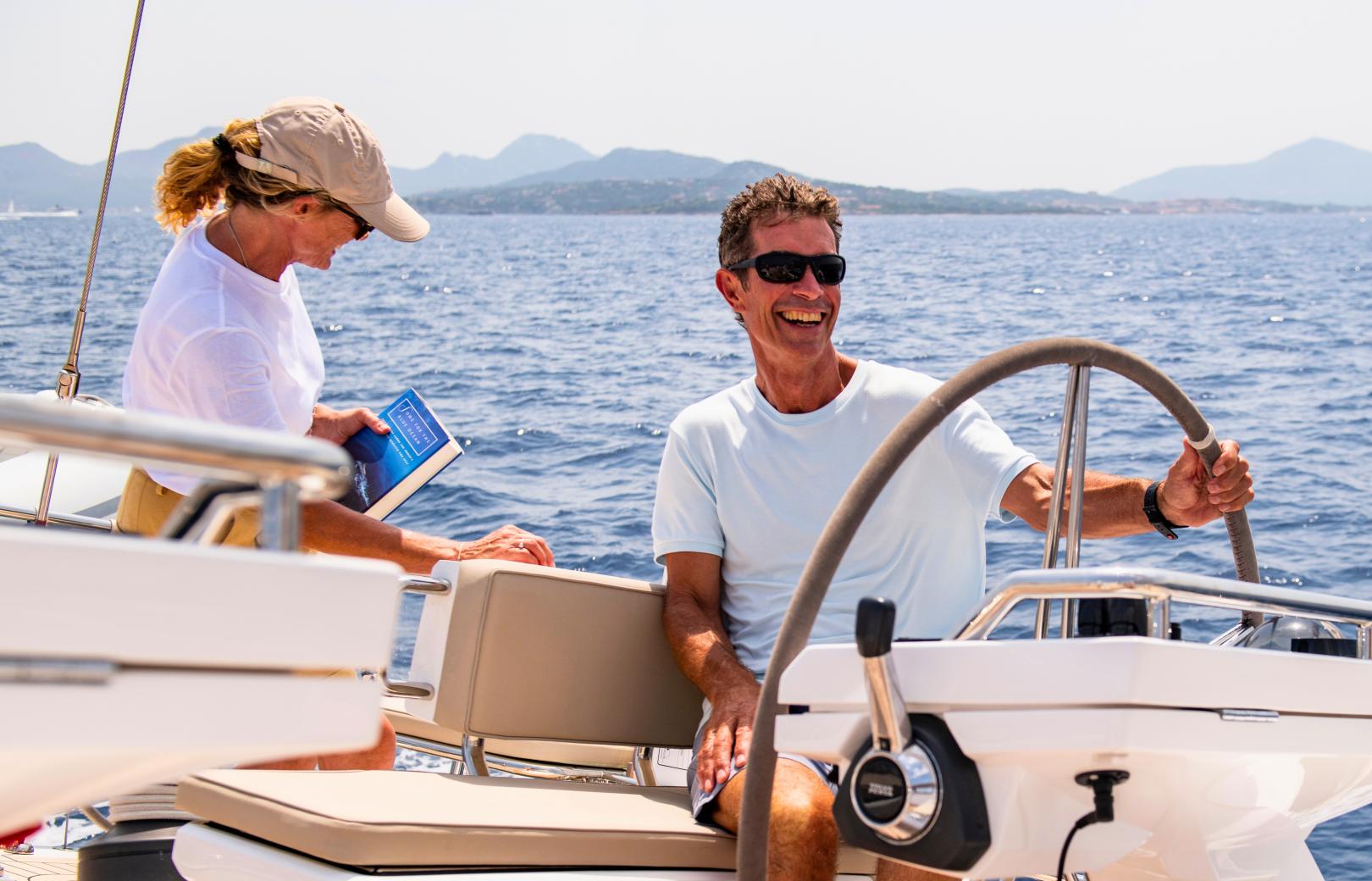
oyster ownership
Personalised care, unforgettable experiences and lifelong yacht support, oyster world rally.
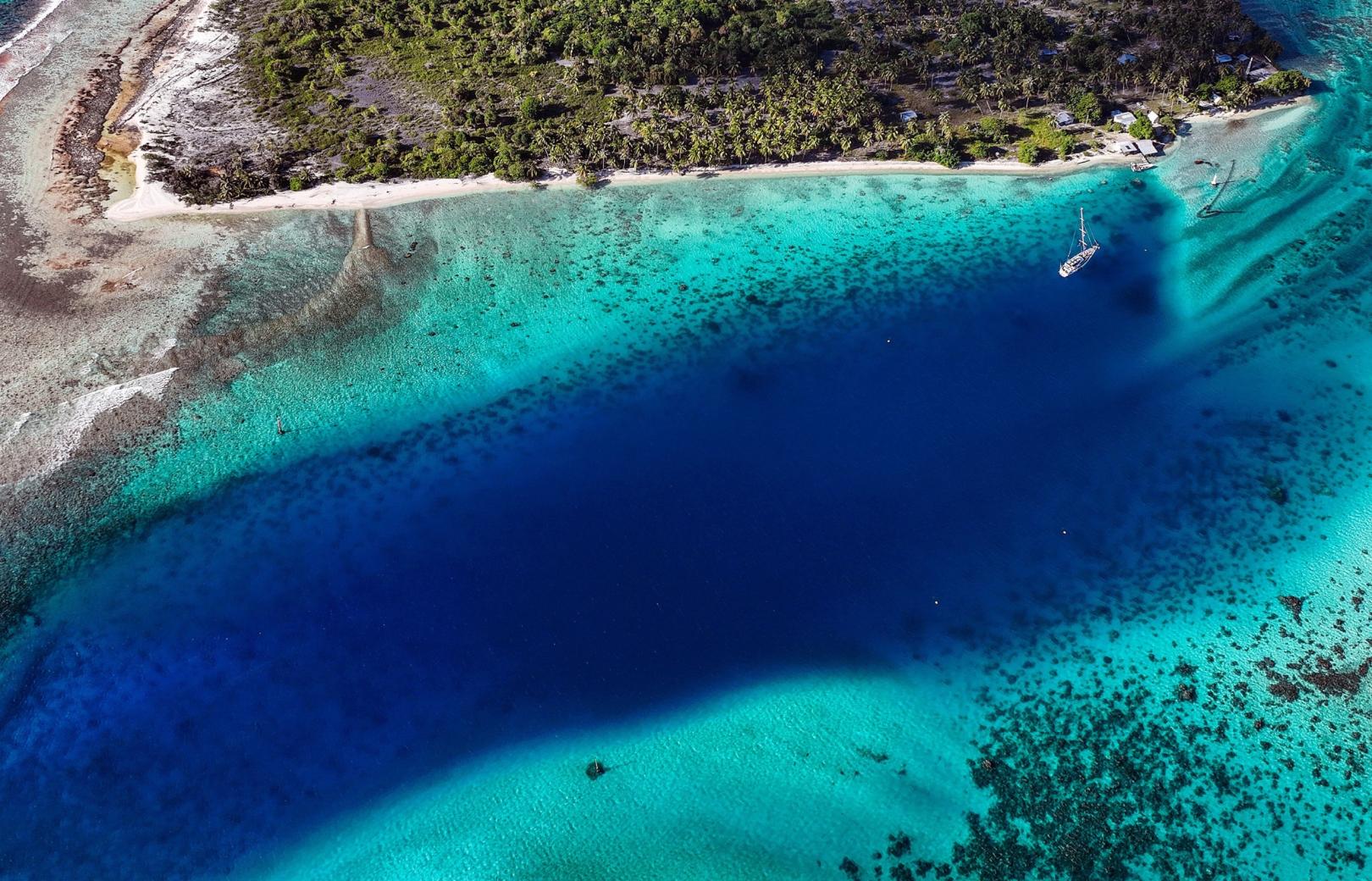
ENTRIES OPEN
Embark on the sailing adventure of a lifetime. entries are now open for the oyster world rally 2028-29.
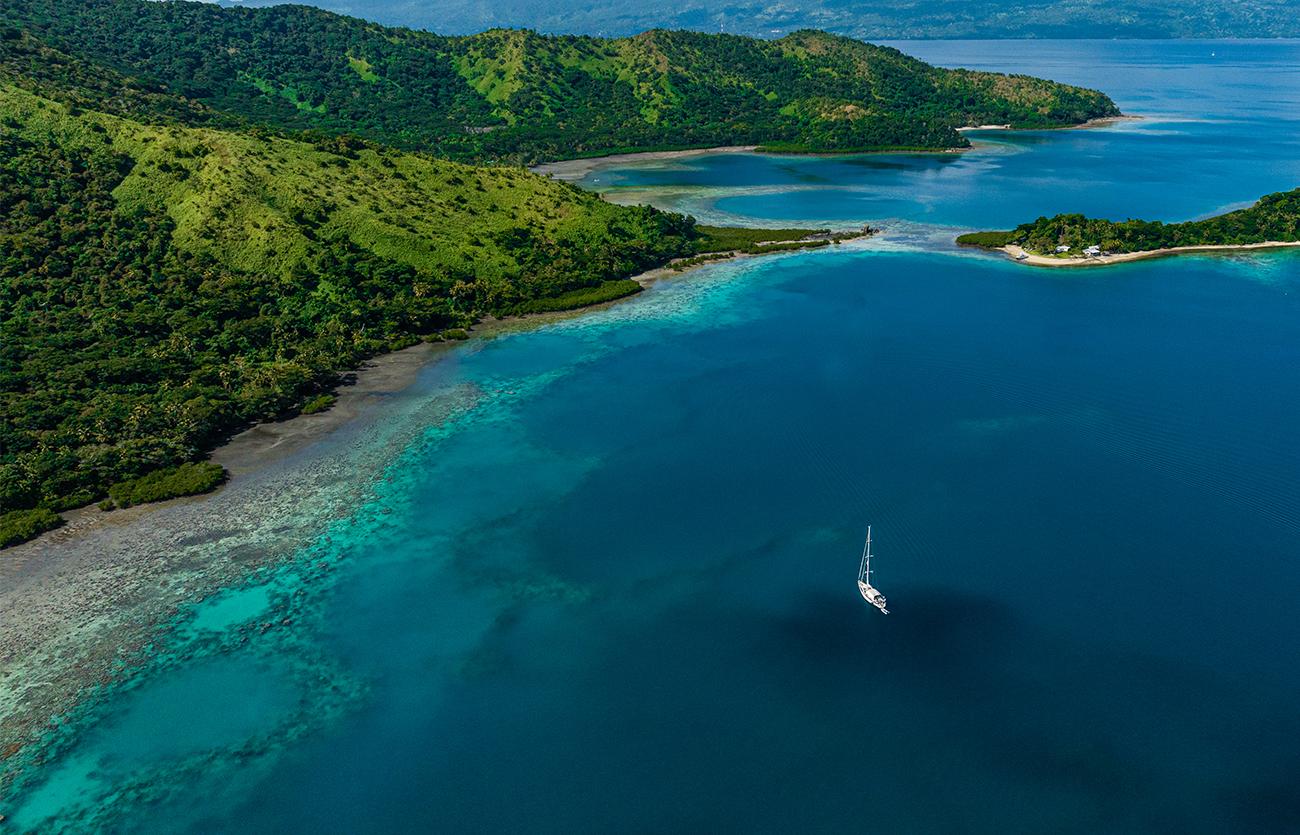
Follow the Oyster World Rally 2024-25 fleet live
Winner of European Yacht of the Year 2023. She is a new breed of luxury 50 foot yacht, offering effortless shorthanded sailing capability.
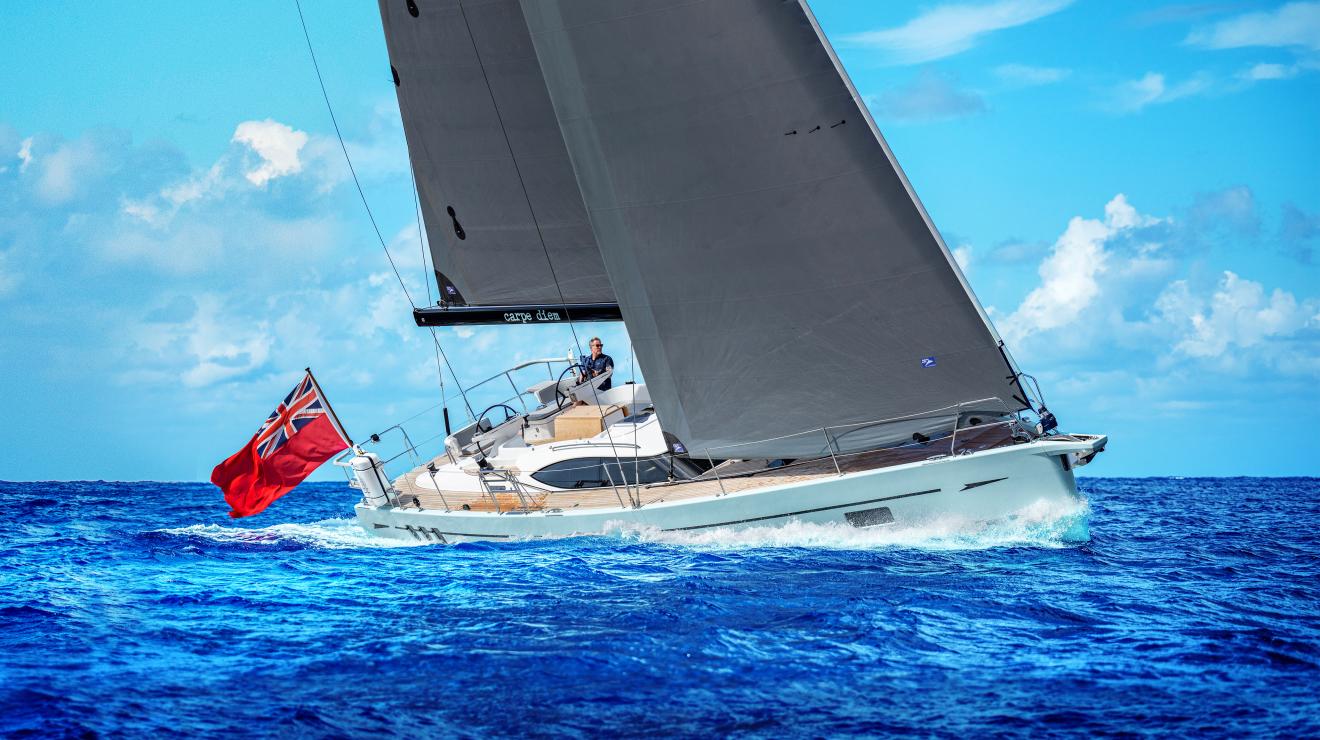
A magnificent, award-winning sub 60 foot sailing yacht, offering luxurious living space and outstanding shorthanded sailing capability.
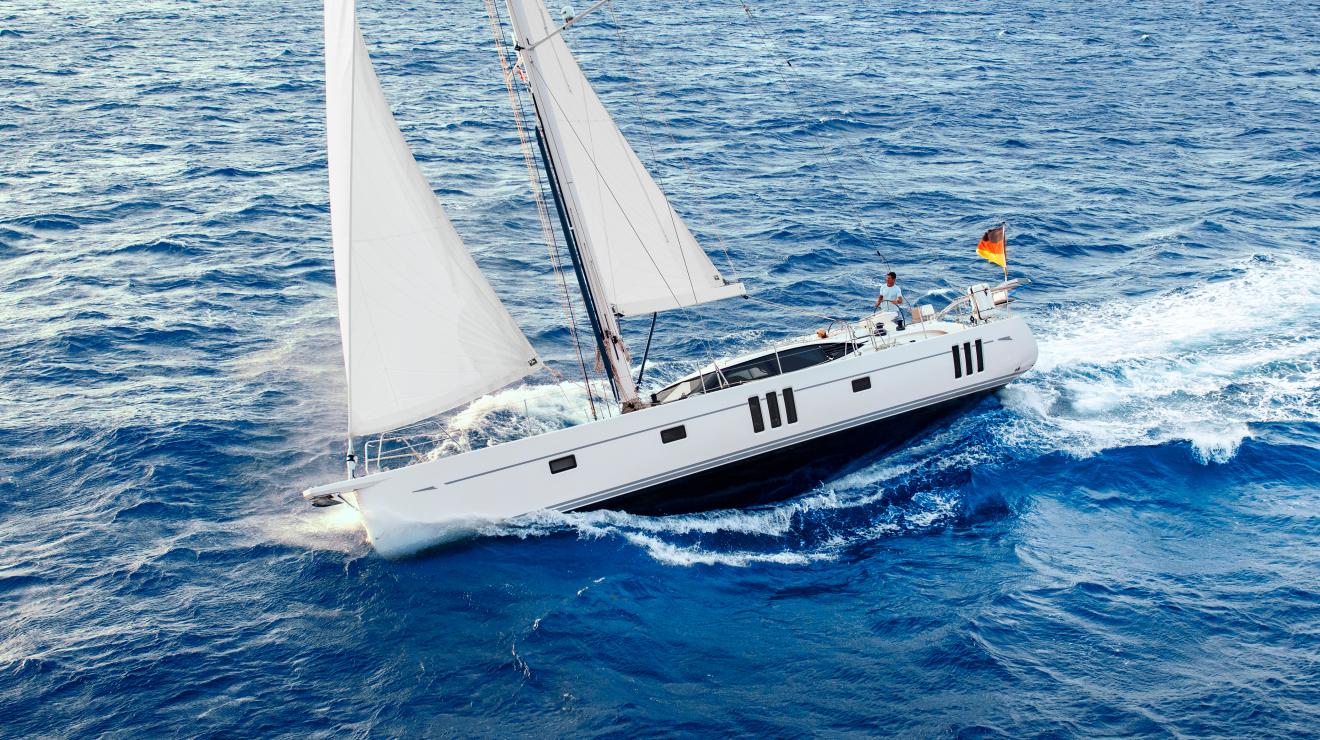
A beautifully proportioned 60 foot, luxury liveaboard bluewater cruiser, offering effortless shorthanded sailing capability.
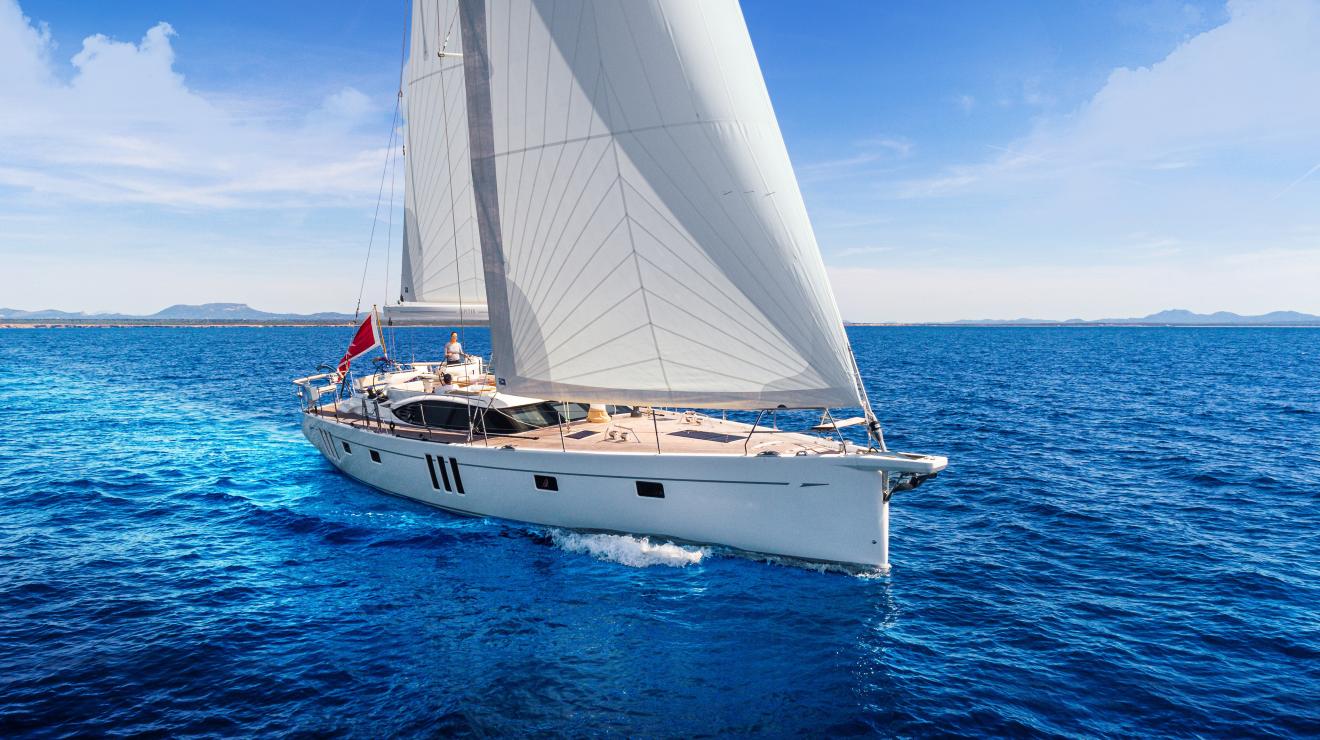
A superb sub 70 foot ocean sailboat offering versatile luxury living space and impeccable sailing performance.
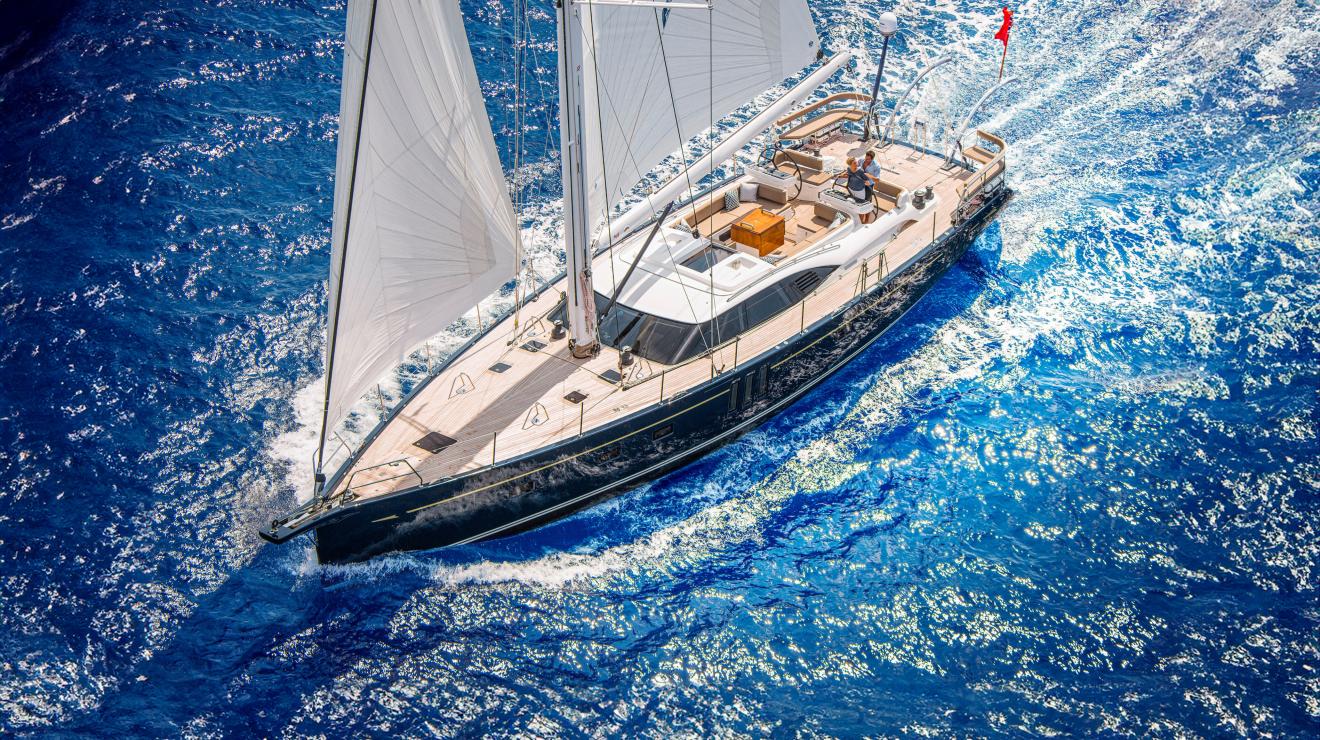
An inspired 75 foot yacht, offering infinite configuration options, generous luxury living space and flexible crew quarters.
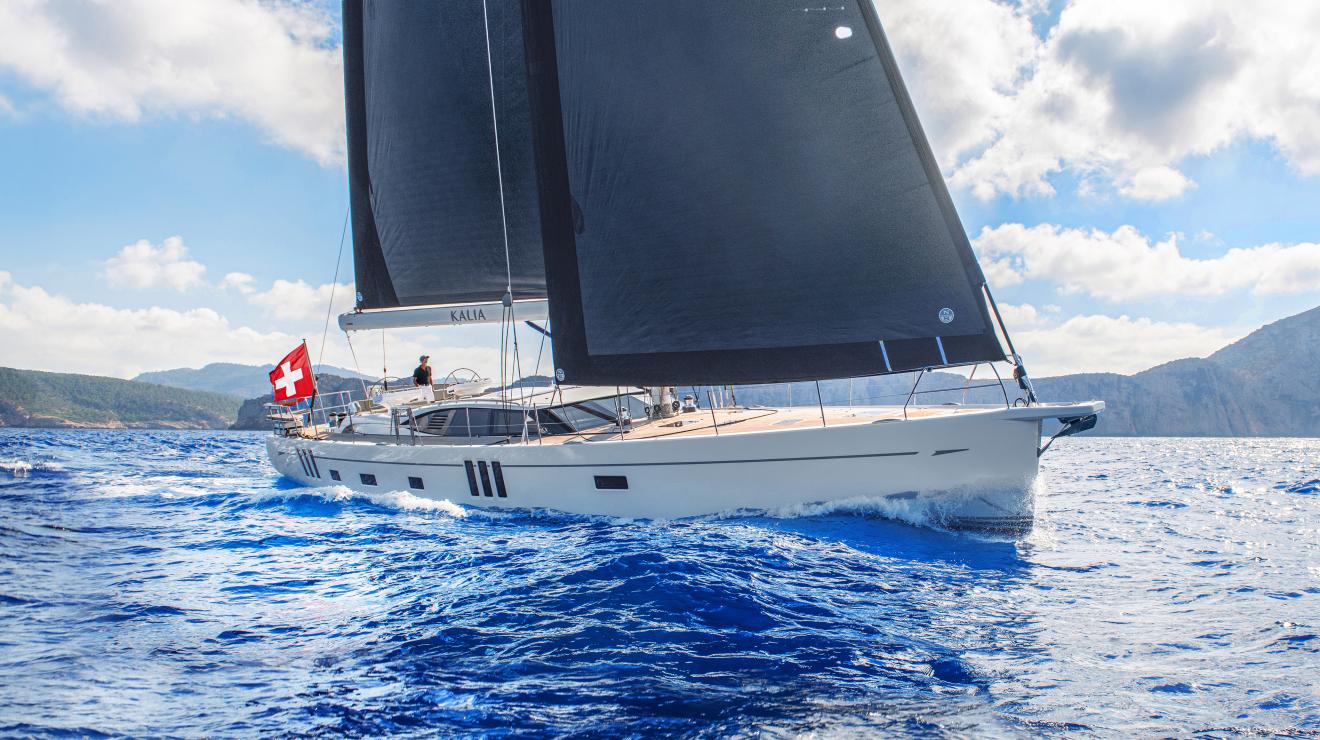
Oyster 885SII
The remarkable, iconic 90 foot sailboat, perfect for relaxed luxury voyages of discovery.
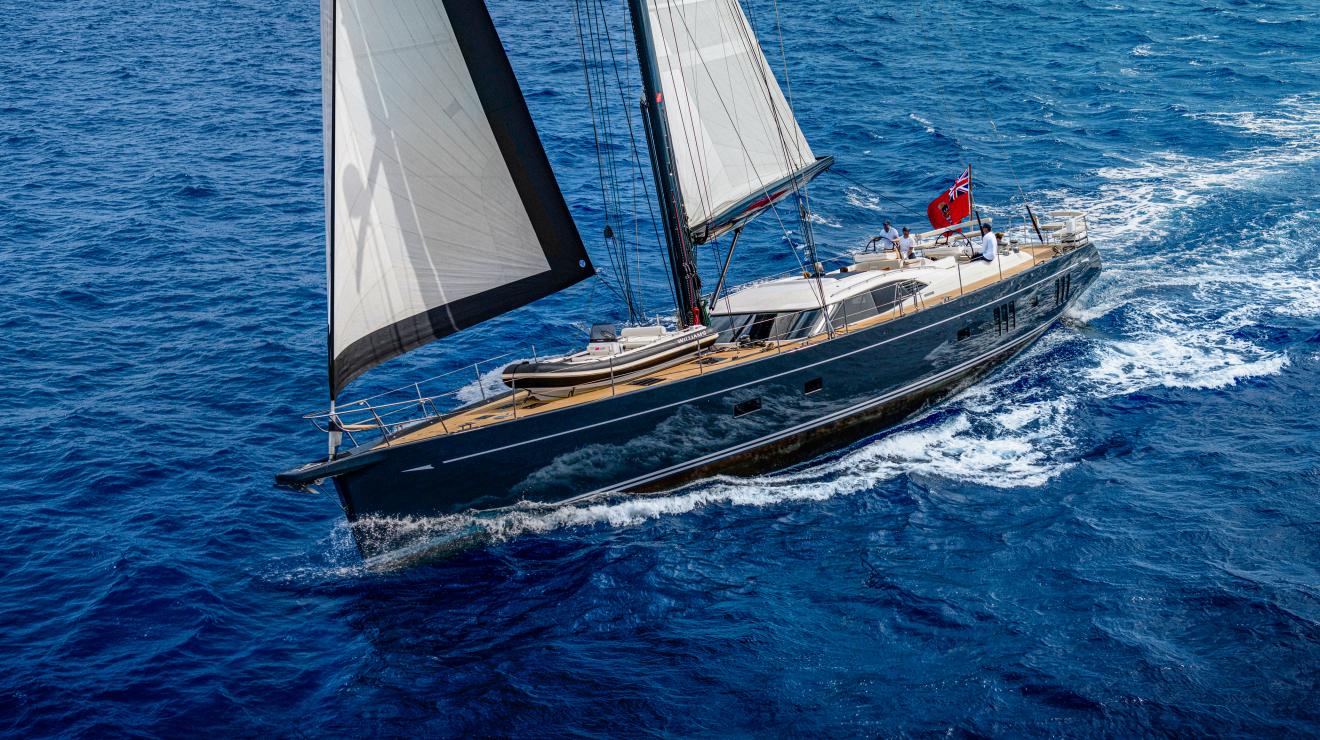
First name *
Last name *
Phone number *
Country/Region *
Attach CV *
Attach covering letter
Current occupation
LinkedIn profile
Yachting Monthly
- Digital edition

Singlehanded sailing for the first time
- Toby Heppell
- August 31, 2020
Toby Heppell looks at the art of singlehanded sailing and considers what constitutes good seamanship when it’s only you on board

Sailing alone gives you freedom to set off when you want, but requires a different approach. Credit: Richard Langdon/Ocean Images
Singlehanded sailing is often something we associate with feats of adventure and endurance, bringing forward ideas of the lone sailor heading off across oceans.
Setting off on a significant offshore voyage on your own is a truly specialist activity.
You are likely to experience sleep deprivation, the stresses of being alone for long periods of time and the possibility of facing inclement weather by yourself.
That may well not be for all of us.

Editor Theo Stocker headed out on his Sadler 29 to put the advice into practice. Credit: Richard Langdon/Ocean Images
But closer to home, many of us are likely to go singlehanded sailing – be it regularly or just the odd occasion, a short coastal trip or a longer voyage, or when a crew member is laid low by seasickness or other ailment.
You might end up without a crew and face the choice of leaving the boat in a distant port or taking a fair wind home alone.
You may be a couple sailing with a young child that needs constant attention, leaving the skipper to handle the boat alone.
Understanding the skills and kit necessary to successfully and safely sail by yourself is, if not an essential skill, certainly a useful string to the bow.
Freedom and responsibility of singlehanded sailing
‘Sailing solo there is the dependence on oneself that is really appealing,’ say Mervyn Wheatley, veteran of many solo ocean races and trips.

Toby Heppell got his first boat aged four and grew up sailing on the East Coast. He has been a sailing journalist for over 15 years. Credit: Richard Langdon
‘A great deal of that appeal is that you know if something goes wrong then you are going to have to sort it out yourself.
As a solo skipper, you are master of your own destiny, entirely free to run the boat exactly as you wish.
With that comes total responsibility for everything on board: food, maintenance, sail choice, pilotage – it’s all up to you.
‘There’s an unmistakable excitement in slipping the lines and knowing that success or failure is entirely down to your resourcefulness and seamanship,’ says Wheatley.
‘Completing a solo passage satisfies like nothing else. But with that responsibility comes a significant reliance on making sure everything onboard and yourself are up to the challenge.’
In this article, I’m going to look at the various aspects you should consider to make sure you’re ready for solo coastal daysails, rather than long-distance offshore singlehanded sailing, when considerations around sleep management become more vital.
Is your boat up to singlehanded sailing?
Though the recent trend has been for ever-bigger boats, you need to be fairly agile to singlehand a boat much over 35ft, or have invested some serious money into automation.
Typically at about 35ft you are reaching the point where sail size is a big factor in terms of managing reefing and winching.
Setting up your boat so that you have to leave the helm as little as possible is important.
If you do have to leave the helm when sailing, doing so on starboard tack, keeping a good lookout and setting an autopilot will keep you in control.

Clip on: Make sure your jackstays are in good condition, and let you work on deck effectively. Credit: Richard Langdon/Ocean Images
A furling headsail saves foredeck work and in-mast or in-boom furling makes mainsail reefing simpler, and the slight loss of performance may not be important to you.
A slab-reefed main can take longer to reef but lines led aft make it easier.
Crucially, if you drop it as you are coming in to harbour, the main will block your vision forward unless you have lazy jacks.
Fortunately, these are easy to add if you don’t have them already, and a stack-pack sail bag makes stowing the sail even easier.
Leaving the cockpit for any reason is among the highest risks for solo sailors, particularly as handling sails at the start and end of your passage is likely to be close to harbour with more traffic around.

Lines aft: Leading lines aft helps avoid trips forward out of the cockpit. Credit: Richard Langdon/Ocean Images
Leading lines back to the cockpit will make life easier, with the caveat that any friction points, particularly in single-line reefing systems, need addressing.
Taking the main halyard back to the cockpit at the very least is a must.
When it comes to mooring by yourself, ‘midships cleats are often underrated and underused, but they are invaluable,’ says ex-Navy navigator and cruising author Andy du Port.
‘With only two of us on board, we have become adept at lassoing pontoon cleats from amidships and hauling in reasonably firmly before the boat has a chance to start drifting off.’
In terms of safety, eliminating risk of going overboard is key and staying clipped on is a good way to do that.
Make sure your jackstays can be reached from inside the cockpit, and let you get to the mast or other working areas on deck.
Webbing rather than wire won’t roll underfoot.
Sensible cockpit strong points should let you move from helm to winches, halyards, instruments, and companionway without unclipping.
Optimal cockpit layout for singlehanded sailing
Whether you have a wheel or tiller, the layout of the cockpit is important as to whether it works well for singlehanded sailing.
It is worth noting, however, that a tiller can be slotted between your legs when hoisting sails or handling lines.
The ability to see a chartplotter on deck is important, as you will need to do much of your navigation from the helm and modern chart plotters make this easier.
Particularly in coastal waters, you will want to spend as little time as possible down below at the chart table so you can keep a proper lookout.

Navigation: A setup that works on deck reduces time spent below. Credit: Richard Langdon/Ocean Images
Effective self-steering is essential for singlehanded sailing.
An autopilot is excellent under power as the engine keeps the batteries topped up but under sail, if you haven’t trimmed correctly for a neutral helm, the autopilot has to work hard and will draw more power.
Modern units draw 2-3A but older models can draw double that.
For this reason, an easily visible battery monitor will help.
Some autopilots include a remote control you can wear on your wrist or on a lanyard to alter course.
For smaller boats or longer passages, a windvane is effective on every point of sail and draws no power.

Midships: A midships cleat is a big help if you don’t have crew to help. Credit: Richard Langdon/Ocean Images
However, they are vulnerable in port, and struggle under motor as prop wash confuses the servo blade.
‘If I am in coastal waters then I use an autopilot as it’s easier,’ says Wheatley.
‘If I’m nipping across the Channel then I know I can plug into the mains on the other side. I use a windvane on ocean passages.’
Ensure essentials such as handbearing compass, sunscreen and water are in place before you slip lines. Finally, get to know your boat well. A refresher on the key parts of each of your main systems might be a good idea before a singlehanded passage.
Physical limitations
Singlehanded sailing requires a reasonable level of physical fitness.
Every manoeuvre is slower and more arduous when sailing alone, so you’ll need the endurance to handle longer passages.
It’s really easy to become dehydrated, so keep a bottle of water in the cockpit, preferably in a pocket along with a few biscuits to keep your energy up and help you deal with tiredness.

The demands of helming, sail handling, manoeuvring, navigation and other tasks on board while singlehanded sailing should not be underestimated. Credit: Richard Langdon/Ocean Images
‘If you’re feeling a bit tired to begin with, if you’re going to sail a long way that is only going to get worse and will probably guarantee seasickness,’ explains ocean sailing legend, Pete Goss.
‘Sometimes if you just take it a bit easy at the start of a longer passage that makes things easier for the rest of the trip.
‘Plan to only go a short distance before possibly anchoring up for some hours, to make sure you get some rest and you have properly got your sea legs.
‘That can be the difference between a great solo passage and a terrible one where you are tired and sick from the off.
‘No-one functions well in that sort of condition.’

Nutrition: Keep yourself rested and fuelled. Heave to and put the kettle on for a break. Credit: Richard Langdon/Ocean Images
‘Eating is a really important thing to focus on too,’ says record breaking skipper Dee Caffari.
‘It is really just getting the balance right and realising the effect hunger has on your body and mind.
‘I did a lot of work with sports psychologists before doing big races to understand myself a lot more.
‘Much of it was focused on understanding when I am tired and when I am hungry.
‘There are moments now when I realise I just need to eat and take a 10-minute break, and then I am a totally different person.
‘Clearly not everyone has access to a psychologist, but taking the time to notice the signs of sleep deprivation and hunger and what they mean in terms of how you function is crucial.’
Solo safety
Singlehanded sailing should be approached much like sailing at night in terms of safety.
You want everything you might need ready to hand, and to take a much more cautious approach.

Make sure you can navigate from the cockpit, whether on a plotter or paper chart in a plastic wallet. Time below is time not keeping a look out. Credit: Richard Langdon/Ocean Images
Going overboard is not a good idea at the best of times and becomes even more serious when solo.
Everything should be done to minimise this risk.
While much of this is a matter of attitude, and planning each manoeuvre to predict the main dangers, having the right equipment in the right place will also help.
Navigation and communication
Being able to manage your boat, and all of the key navigation and safety systems from the cockpit is the key.
Think through your navigation and communications equipment.
A chart plotter and a VHF radio handset on deck will save the need to go below.

Shore contact: Register your vessel details with the Coastguard on the SafeTrx app, then let a shore contact know your ETA. This can also be done with the app. Credit: Richard Langdon/Ocean Images
Should you need to make a distress call, having a radio that is set up with a DSC button will make things easier.
Modern handheld VHF radios are capable of this, as are command microphones for fixed VHF sets, which also have the advantage of a longer range.
It is worth having binoculars, flares, and a grab bag easily to hand too.
AIS and radar
Making your boat more visible to others will help make up some of the potential shortfall of only having one set of eyes to keep lookout.
A properly working AIS unit, radar reflector, and potentially a radar enhancer and alarm, will help alert you to approaching vessels and you to them.
On board equipment
Though they are key bits of safety kit on any yacht, the lifebelt and danbuoy aren’t so important for singlehanded sailing, as there will be no-one left to throw them after you if you did go overboard.
But the rest of the boat’s standard equipment should be located, inspected and brought up to spec before a solo passage if they aren’t already.
These include the liferaft, fire extinguishers, bilge pump, flares, first aid kit and so on.
Man overboard
Falling overboard, serious enough with a fully-crewed boat, becomes even more unpalatable solo.
Everything should be done to avoid this possibility.
Clearly, a mindset that is consistently aware of the risk is your biggest asset, and will help you avoid doing things that could leave you exposed.

MOB: You’re most likely to fall overboard when mooring. Make sure your bathing ladder can be operated from the water or rig an emergency one. Credit: Richard Langdon/Ocean Images
Keeping clipped can serve as a reminder of this, and goes some way to keeping you connected to the boat, though being overboard on the end of the tether may be little better than being overboard without one.
‘I do wear a tether often,’ says Wheatley.
‘But the thing to remember about going over the side is that a tether does keep you there, but if you go over by yourself and you are tethered on, then you are not going to get back onboard.
‘However, it is much easier to find a boat than a body so I take the view that I wear one to make it easier for my family should I go over.’
Emergency ladder
Often the biggest risk of going overboard for a singlehander is actually in harbour.
Picking up the mooring buoy, or even stepping across from pontoon to boat has often led to an unexpected dunking.
This can rapidly become serious if you are wearing heavy clothing or the water is anything less than balmy, and do not have an easy means of climbing out.
For this reason many solo sailors carry an emergency ladder with a line that can be reached from the water.
In this scenario, a lifejacket will help you float during the initial phase of cold shock, and should therefore be worn, not just when things start to get ‘a bit lively’ out at sea.
Modern lifejackets are far more impressive than their early counterparts.
Lightweight, slimline, and comfortable to wear, the hood helps prevent secondary drowning and the bright colour and light makes it easier to locate you by day and night.
Crucially, technology has moved on so that it is possible to carry AIS and satellite distress beacons in or on the lifejacket.
Along with a VHF radio in your pocket, this is likely to be your only chance of calling for help at sea should the worst happen.
It should therefore be a serious consideration for anyone sailing solo, however far they venture.
Passage plan
As a solo sailor, it is a good idea to have a shore contact who you keep updated with your plans and your estimated time of arrival, and who knows to call the Coastguard with the details of your boat if you become overdue.

Cockpit kit: Gear close to hand should include binoculars, compass, knife and PLB, as well as grab bag, food and drink. Credit: Richard Langdon/Ocean Images
This can be supplemented by having your details up to date on the RYA SafeTrx app , which the Coastguard now uses as its leisure vessel registry, as well as being an active passage-tracking tool.
Even if the alarm is raised, hopefully a phone or VHF radio call will quickly establish all is well.
Tangled ropes
It’s easy for piles of rope to mount up when there’s no second pair of hands to help.
Keep up with tidying lines away, so you don’t end up with a tangled mess that could jam just when you need a halyard to run free.
With a little patience, singlehanded sailing is rarely more difficult than sailing two- or three-up for the experienced skipper.
Manoeuvres take longer to complete and you are likely to spend more time in the cockpit than you otherwise might, but your approach to most situations will be broadly the same.
Where things can get tricky is in slipping the lines and mooring.

Springing the stern out is fine with crew, but springing the bow out means you can handle lines without leaving the cockpit. Credit: Richard Langdon/Ocean Images
The latter being all the worse for coming at the end of your passage and so your decision making is likely to be impaired through weariness.
Slipping the lines is clearly much easier if the wind is blowing you off the pontoon.
Here your midships cleat will come in handy as you can get yourself tight to the pontoon with this and then drop the bow line, before heading back to remove the stern line and finally slipping the midships line.
Do remember to have plenty of fenders fore and aft as the boat may pivot around the midships cleat, depending on wind and tide direction.

Multi-tasking: Tiller boats can be steered with your knees while coiling lines, but don’t get distracted. Credit: Richard Langdon/Ocean Images
As ever, the process for leaving a windward berth can be trickier.
It is easier to spring off the bow first as you have cockpit access to your sternline.
So this is your best option if there is little to no tide, or the tide is coming from ahead.
If there is no tide running and the wind is blowing to onto your pontoon, then you will probably need to motor astern with the stern line firm to help bring the bow out.

Midships cleat: If you can get a midships line on, it will hold the boat to the pontoon while you sort the other lines. Credit: Richard Langdon/Ocean Images
Once it moves clear of the pontoon you can motor ahead as you slip the sternline.
With the tide from astern, use a slipped bow spring.
With sufficient tide the engine does not have to be engaged; simply slip all the lines bar the bow spring, go to the foredeck, watch the stern come away from the pontoon, slip the spring and return to the cockpit.
Once you are in open water, set the engine slow ahead and engage the autopilot while you recover lines and fenders.
Lines can be coiled and fenders tidied away in the cockpit.
On the water
Before taking on any planned singlehanded sailing, your boat handling should be up to scratch, but even the best sailors will find their skills improving quickly from a bit of time on the water alone.
Thinking through manoeuvring into and out of marinas berths and moorings, and then practising this a few times can take away some of the stress of a solo trip.

Heaving to: Lash the helm and back the jib to give yourself a break, but get the boat balanced first. Credit: Richard Langdon/Ocean Images
At sea you need to be able to heave-to or stop comfortably, as this will give you time to boil the kettle, tend to any problems, or even have a quick break.
Manoeuvres such as tacking or reefing can also be rehearsed: which lines are eased or hauled in first, and when to put the helm down will be particular to your boat, but can be practised.
Once you’re at sea, it is worth keeping manoeuvres to a minimum when possible, as they take time and energy, and incur an element of risk.
As beating will involve a heeled boat and some tacking, it is, by its very nature, the toughest point of sail.
Self-steering
Vane steering systems or an autopilot that can adjust the course to the wind shifts, will keep the boat steering effectively.
Some newer autopilots also have tacking and gybing functions, leaving you free to concentrate on trimming the sails.

An autopilot or self-steering is vital. Credit: Richard Langdon/Ocean Images
An autopilot remote is also an option, giving you access to control from anywhere on the boat (usually worn on the wrist).
It’s also worth spending time on your passage planning and general theory.
Going below for five minutes to check when the tide turns or to find out what a specific light means will be five minutes that you’re not on deck keeping a lookout.
When coming in to harbour, start the engine relatively far out from your destination to give you time to douse sail and prepare yourself.
Lazyjacks prevent a dropped mainsail blowing off the boom and restricting visibility forward.
Rig your fenders and lines in open water where you have space to drift or motor slowly under autopilot.
If you do not yet know where you will be going it is well worth fendering port and starboard with stern and midships lines on both sides.

Rig fenders and lines once you’re out of the waves, but before you enter confined waters. Credit: Richard Langdon/Ocean Images
Most marinas will send someone to help you if you radio ahead and let them know that you are on your own, or others on the pontoon will normally be happy to catch a line, but you should be prepared to do things alone if needed.
Coming alongside a pontoon, the midships line is critical.
Position the tail so that it is easily picked up when you move forward from the helm.
Prepare bow and stern lines and bring the ends amidships so you can reach them from the pontoon.

Boat handling: Without someone to take the lines ashore, being able to get your boat stopped where you want it makes life much easier. Credit: Richard Langdon/Ocean Images
Stop the boat dead with your midships cleat as close as possible to your selected pontoon cleat, and throw a lasso of rope over it – a skill well worth practising.
Sweat the line to bring the boat as close as you can.
You are then secure and have more time to take bow and stern lines across and adjust your position.
You can also use the midships line as a spring.

Stern line: Throw a coil of line from each hand to lasso a cleat at the stern. Credit: Richard Langdon/Ocean Images
Once the line is made off, put the engine ahead with the helm towards the pontoon.
This will hold the boat snug alongside while you sort the other lines.

Lazy jacks: When dropping the main, lazyjacks help prevent the sail blocking the view and let you delay a trip on deck. Credit: Richard Langdon/Ocean Images
This is harder if the wind is blowing off the pontoon; your boat handling has to be positive and accurate.
If coming alongside isn’t working, getting a line onto a cleat from the bow or stern will get you secure and give you time to warp the boat in.

Which line first? If the wind is offshore, the midships line is useful to get on first. Credit: Richard Langdon/Ocean Images
If you don’t fancy it, consider picking up a swinging mooring or dropping the anchor until help is available or the conditions change.
The key to mooring alone is to be ready beforehand, in open water, and to have planned what order you will do things in.

Midships spring: Helm to the pontoon and forward gear will hold you alongside. Credit: Richard Langdon/Ocean Images
This can be practised while you have crew by getting the boat to stop in her berth without relying on lines to take the boat’s way off.
It looks much better too!
Don’t get overpowered
Managing the amount of sail you have set before you become overpowered is more important when you are singlehanded sailing as it takes longer to reduce sail and you will have no extra pairs of hands if things get exciting.
If you know it’s going to be a windy sail, reef before you leave your mooring.
If you have a ramshorn for the tack reefing point, you may need a small piece of bungee to hold the cringle in place until you have hoisted the sail.

Reef earlier than you would with crew. It’ll save energy, reduce risk and reflect a more conservative approach. Credit: Richard Langdon/Ocean Images
If you are already out on the water, reef early, before the wind increases too much.
Be conservative with how early you reef.
Before you tackle reefing the mainsail, furl away some of the headsail.
This will slow the boat, making the motion easier and reducing heel, so making reefing the main easier.
Having a more heavily reefed main, and using the genoa to fine-tune the sailing area with the furling line also makes changing gears singlehanded less arduous and avoids trips on deck before needing to shake out or take in the next reef.

Going forward to the mast, make sure you are clipped on. Credit: Richard Langdon/Ocean Images
‘For short-handed crews, mainsails need to be quick to drop in an emergency and require no feeding when hoisting, to avoid unnecessary trips out of the cockpit,’ says Pip Hare .
‘Avoid using a main with a bolt rope, because when the sail is dropped it will not remain captive at the mast and can quickly become uncontrollable.’
Downwind, keeping the rig under control requires some forethought.
A main boom preventer should be used if you’re sailing deep downwind, but is precarious to rig at sea, so have this ready before you set off, or even rig one on each side.
Most singlehanders are likely to be reluctant to set coloured sails off the wind in all but the best conditions and using a headsail, poled out, is more likely.

Keep rope tails tidy when singlehanded sailing to prevent a dangerous tangle in the cockpit. Credit: Richard Langdon/Ocean Images
To set your poled-out headsail, begin by furling it away while you ready a pole on the windward side with uphaul, downhaul and guy.
This will give you full control of the sail from the cockpit.
Once you are set up it is simply a case of unfurling the sail and trimming from the helm.
It’s an easy and easily manageable solution and can be furled away without dropping the pole.

If your reefing system has ramshorns, a piece of bungee can hold it in place while you go aft. Credit: Richard Langdon/Ocean Images
It will be easiest to furl the sail before you gybe, then attend to changing over the pole before again unfurling.
Setting a spinnaker or cruising chute is a more long-winded process solo so should only be taken on if you have a long leg ahead of you and you are sailing in relatively traffic-free waters.
A cruising chute is simpler to set up than a spinnaker.
Rigging can be done with the headsail furled and hoisted in its snuffer.
You’ll probably need to be on the foredeck to raise the snuffer, so make sure you are secure before doing so.
Continues below…

Jeanne Socrates: 77 & solo non-stop around the world
Jeanne Socrates battled equipment failure during her record circumnavigation. She tells Katy Stickland how she overcame adversity

Storm tactics from the Golden Globe Race: Mark Slats
Golden Globe Race skippers share their experiences of ocean storms, providing lessons for all of us about how to cope…

Manoeuvre under sail: getting home without an engine
We’re used to relying on our engines, but could you get home without one? James Stevens shows how it’s done…
Set the boat on a course deep downwind until you can get back to the cockpit to trim the sail.
Hoisting a spinnaker takes more planning and more time both to set and douse.
For gybing either of them, you would be best to snuff or drop the sail and reset on the new side.
Singlehanded sailing checklist
- Boat well maintained with all known faults rectified
- Sail handling arrangement set up with lines back to cockpit if possible
- Autopilot or self-steering set up, calibrated and working, with remote if available
- Hove-to practised and balanced sail plan checked
- Furling headsail and mainsail lazyjacks set up and working
- Enough fenders and mooring lines to rig both sides, and means of getting midships line onto a pontoon cleat
- Confident you can handle the boat for the given forecast
- Practised mooring, manoeuvring and sail handling alone
- Well rested ahead of passage
- Food and drink prepared in advance and available on deck
- Familiar with boat’s key systems and how to troubleshoot each of them
- Short passages and daysailing in coastal waters are better
- Avoid overnight passages initially
- Full passage plan completed with necessary notes available on deck
- Passage plan and ETA shared with shore contact, coastguard or RYA SafeTrx app
- Boat details registered on RYA SafeTrx app or website
Safety and kit
- Adopt conservative approach to risk and safety
- VHF radio on deck
- Chartplotter or paper chart on deck
- Wearing lifejacket at all times, particularly start and end of passage recommended
- Carry personal safety equipment, including VHF, knife, torch, and PLB or AIS beacon
- Jackstays rigged, tether clipped on
- Emergency ladder in reach from water
- Have easily available: wet weather gear, binoculars, handbearing compass, knife, sunscreen, snacks, and water.
For all the latest from the sailing world, follow our social media channels Facebook, Twitter and Instagram .
Have you thought about taking out a subscription to Yachting Monthly magazine?
Subscriptions are available in both print and digital editions through our official online shop Magazines Direct and all postage and delivery costs are included.
- Yachting Monthly is packed with all the information you need to help you get the most from your time on the water.
- Take your seamanship to the next level with tips, advice and skills from our expert skippers and sailors
- Impartial in-depth reviews of the latest yachts and equipment will ensure you buy the best whatever your budget
- If you are looking to cruise away with friends Yachting Monthly will give you plenty of ideas of where to sail and anchor

Best Liveaboard Bluewater Catamarans

Catamarans are known for seaworthiness, but what sets a run-of-the-mill recreational cat from a full-blown liveaboard blue water cruiser?
The best production blue water cruising catamarans are the Manta 42, the Lagoon 42, the Leopard 45, the Lagoon 450, and the Prout 45. These vessels have excellent living accommodations and great sea keeping abilities.
In this article, we’ll cover five of the best liveaboard cruising catamarans, along with what sets them apart from similar vessels. Additionally, we’ll go over what to look for in a catamaran that functions both as a home and an offshore adventure cruiser.
We sourced the specifications listed in this article directly from boat design guides and the manufacturers themselves.
Table of contents
Characteristics of Liveaboard Cruising Catamarans
Generally speaking, blue water catamarans that are suitable for offshore cruising and living aboard are between 40 and 50 feet in length. Some well-designed catamarans between 25 and 39 feet in length can also be used.
A good liveaboard cruising catamaran should have adequate berthing and galley facilities, along with an enclosed cockpit. Catamarans without enclosed cockpits, especially smaller vessels, aren’t spacious enough in the hull to accommodate good liveaboard facilities.
As far as cruising is concerned, the best Bluewater catamarans are designed for durability and seaworthiness. A vessel’s sea keeping abilities rely on more than just smoothness and speed. These vessels should be water-tight in key locations, positively buoyant, and equipped with all the right extras.
Factors that Increase Catamaran Seaworthiness
There are several additions that manufacturers commonly include with sea-going blue water catamarans. These include water-tight hatches, radar units, a backup generator, and a berth close to the cockpit.
The latter is particularly important, as the captain and crew need to be able to grab the controls in the event of a nighttime emergency.
Other add-ons, such as automatic winches and controls, are extremely beneficial to blue water catamarans. These devices allow the sails to be controlled remotely without the crew needing to walk on deck.
Cruising Catamaran vs. Bluewater Catamaran
Fundamentally, cruising catamarans and ‘blue water’ catamarans are one and the same. When companies classify a catamaran as a ‘cruising’ catamaran, they usually do so because of a few notable design features.
These include cruising accommodations such as large-capacity water tanks, large fuel tanks, onboard power supplies (like a generator and a battery bank; sometimes solar panels), and long-distance communication systems. Radar is another perk, and it’s available on most cruising catamarans.
Best sea-going Liveaboard Catamarans
We searched the market, researched specifications, and listened to the owner’s opinions to find the best sea-going catamarans on the market.
These vessels are also spacious and comfortable enough to live aboard, both at sea on extended voyages and in a marina. Here are our top picks.
1. Manta 42
The Manta 42 is a well-known and popular cruising catamaran with a reputation for seaworthiness and exceptional comfort for its size. This vessel, while on the smaller end for cruising catamarans, is quite seaworthy and handles well in all conditions.
The Manta 42 is powerful—it has a large sail area for its size, which gives it incredible speed in both low and high wind conditions.
The Manta 42 has an unconventional design feature that makes it stronger than the competition—and technically, more seaworthy than many larger and fancier catamarans. The feature we’re referring to is the Manta 42’s fixed crossbeam, which is stronger than typical designs.
The Manta 42’s interior is really well-designed and ideal for living aboard. The hulls feature large berthing areas, and the center cockpit area features a full-size marine galley and sitting areas. This vessel is popular with families, as there’s plenty of room for parents and one or two kids.
2. Lagoon 42
Here’s another 42-foot cruising catamaran with exceptional seaworthiness, shallow draft, and spacious accommodations. The Lagoon 42 is a modern and advanced sailing catamaran with numerous cruising features, such as a self-tacking jib and a flybridge.
This model has extensive sleeping capacity. Standard versions can sleep up to 12 adults, which is much more than many catamarans in the 40 to 45-foot range. The vessel also features four separate heads, which ensures privacy for guests and family members.
This vessel is designed for comfort, and therefore it's a bit beefier than some slimmer and less spacious models. It’s a heavy boat with a 25-foot beam, and it has excellent sea keeping abilities.
The primary drawback of the design is that its size and hull shape limits speed. But this isn’t as big of an issue on long voyages, and it’s still much faster than an equivalently-sized monohull.
3. Leopard 45
This premium catamaran is a bit larger and more comfortable than the vessels we’ve discussed so far. It’s a luxury catamaran with everything you’d expect for the half-million-dollar price point.
This vessel shines on the open water where it can let out its sails and stretch its legs. The vessel is lightning fast in the right conditions, and it has an astounding 700-gallon fuel capacity for when the wind isn’t blowing. You can sail it, motor it along, or do both at the same time for even greater speed.
From the factory, the Leopard 45 sleeps around 12 adults at its maximum capacity or four couples in separate staterooms—each with its own bathroom and shower. The center cockpit is also quite spacious, and the vessel can be navigated from the flybridge above the central living area.
4. Lagoon 450
Here’s another 45-foot catamaran that comes from one of the world’s most respected catamaran builders. Lagoon, which is currently producing several catamaran models, is known for its high-quality material choice and construction.
The Lagoon 450 is a flybridge sailing catamaran. Its design is based on the best-selling Lagoon 440—a slightly smaller model that proved itself over years of use and countless miles sailed between owners. And though it’s only 45 feet long, this catamaran is massive both inside and out.
The vessel is fast and nimble, and it has excellent sea keeping qualities. Below decks, the surprisingly wide hulls have room for full-size staterooms both fore and aft. But what the Lagoon 450 is known for is its deck space. There’s a ton of room on the decks for hanging out, living activities, and entertaining guests.
The center cockpit of the Lagoon 450 is like something out of a luxury condo. The styling is impetuous and airy, and there’s more than enough room to prepare a full meal for ten people or more. The settee can double as a sea cabin, with more than enough room for a small crew.
5. Prout 45
Here’s a sleek and fast catamaran that’s a superior choice for cruising and living aboard. The Prout 45 debuted in the 1990s and was a huge success.
Impressively, over 2,000 individual Prout 45 cruising cats were eventually produced. That’s a lot for a production catamaran—especially a large 45-foot model with a hefty price tag.
This sea-going catamaran has unconventional features, including pointed monohull-like bows and a nearly flush cockpit.
The interior arrangement of the vessel is unconventional as well, but many owners eventually learn to prefer it. For example, oddities include a galley in one of the hulls instead of the center, where catamarans often keep such facilities.
This is a fast cruising catamaran with a very shallow draft. Three feet six inches of draft, to be precise.
This means that the Prout 45 is ideal for sailing in shallow locations, such as around tropical coral reefs and in areas known for sandbars. The draft of this vessel is much closer in depth to that of a 20 to 25-foot displacement monohull than to a full-size 45-foot catamaran.
Related Articles
Daniel Wade
I've personally had thousands of questions about sailing and sailboats over the years. As I learn and experience sailing, and the community, I share the answers that work and make sense to me, here on Life of Sailing.
by this author
Best Sailboats
Most Recent

What Does "Sailing By The Lee" Mean?
October 3, 2023

The Best Sailing Schools And Programs: Reviews & Ratings
September 26, 2023
Important Legal Info
Lifeofsailing.com is a participant in the Amazon Services LLC Associates Program, an affiliate advertising program designed to provide a means for sites to earn advertising fees by advertising and linking to Amazon. This site also participates in other affiliate programs and is compensated for referring traffic and business to these companies.
Similar Posts

Affordable Sailboats You Can Build at Home
September 13, 2023

Best Small Sailboats With Standing Headroom
December 28, 2023

Best Bluewater Sailboats Under $50K
Popular posts.

Best Liveaboard Catamaran Sailboats

Can a Novice Sail Around the World?
Elizabeth O'Malley
June 15, 2022

4 Best Electric Outboard Motors

How Long Did It Take The Vikings To Sail To England?

10 Best Sailboat Brands (And Why)
December 20, 2023

7 Best Places To Liveaboard A Sailboat
Get the best sailing content.
Top Rated Posts
© 2024 Life of Sailing Email: [email protected] Address: 11816 Inwood Rd #3024 Dallas, TX 75244 Disclaimer Privacy Policy

- Search forums
- Yachting Monthly's Scuttlebutt
Best singlehanded, bluewater sailboat (not "caravan on keels")
- Thread starter Homeward Bound
- Start date 20 Feb 2013
- 20 Feb 2013
Homeward Bound
Hi folks. This is my first post but I promise have done my 'due diligence' by reading other related threads first and I am aware of the problems in asking for a "best of" anything recommendation ... but I have a specific angle I have not seen asked and I understand might be best served by links to other places as I am looking at a blind spot in my own awareness. I am look for an economical, singlehanded, bluewater sailboat and not "caravan on keels". I don't mean to offend anyone else's taste and requirement, and I understand there are perfectly good reasons to go for comforts, but I am exhausted by trawling through all the perfect adequate AWBs to find what I am looking for (... and I am starting to wonder if I should be look at older racing stuff of which I know nothing ). It seems the vast majority of boats are aimed at stuffing in as many people in as possible, including the wife and her kitchen sink, and that the 4 birth-er is the industry standard form. I'm not after that. I'm looking to escape her ... kind of like when a man has a mid-life crisis and buys a Harley-Davidson with a single seat to make the point clear. I'm looking for a singlehander with good long distance bluewater capacities and am willing to accept low head heights and spartan facilities, e.g. single bunk but more storage/tank space. (However, I am headed off to warmer places and would prefer some ventilation, meaning that some of the more airless low-profile cabin designs are out). In terms of preference, I'd say; wood, steel, GRP (... or if it has to be GRP to have a lot of wood in the cabin) with an inboard engine and a proper head not a portapotty. I'm aware of most of the obvious good choices around the 28 foot mark and, at present, Folkboat or FB derivatives seem to be the more obvious choice. There are many to choose from and many are either raw or have already been customised. I've also had a look at some of the 20 - 22 mini cruisers which are interesting, but they seem to go for really high prices considering what they are or what the money would buy elsewhere. What I am thinking is that although this is not an obviously commercial design it must be a fairly common ideal and that, perhaps, there is something in the vintage/classic world that exists ... Or that is a stage a few people go through and once they have it out of their system, or become domesticated, move back to a more comfortable design, so there may be the odd custom designed boat coming up now and again. Other boats which have caught my eye for other reasons are the Kingfisher 30; strong and with large fuel and water tanks, and a Van de Stadt Zeebonk; steel & built like a tank (as in Panzer tank). Where my knowledge is weak is on potentially lighter & faster stuff. Thanks. Hope this interests others too.
Sadler 25's seem to be doing quite a few atlantic circuits these days and I know a norwegian chap who regularly does the same in a Contessa 26. If you want something a bit bigger then an old S&S 34.
Well-known member
Not caravan on keels Click to expand...
Here is an idea: http://www.theyachtmarket.com/boats_for_sale/372274/ If you want a smaller boat for blue water cruising, it's nice to know your boat is unsinkable. Put your own criteria into the search engine and, to give yourself a wider choice, don't just limit your choice to British boats. The Etap is a particularly well made boat but you must check that water has not infiltrated between the buoyant hull skins.
V1701 said: Albin Vega, once held a speed record for transat, one's recently circumnavigated N & S America including going the Northwest Passage, non-stop... http://www.solotheamericas.org/?page_id=283 Click to expand...
Active member
Vancouvers seem to have that sort of reputation. Your requirement for plentiful ventilation might conflict with the ocean capability.
Cutlass 27. Put a wind vane on the stern of mine, added an inner forstay to take a storm jib then had to close my business and go and work for someone else curtailing my plans!
Vancouver 27 or 28 would be my choice. Designed for blue water sailing, well built with a long keel, will easily accept wind-vane self steering and easily enough room for one person.
There's an Ohlson 38 for sale at Marconi SC (I have no connection to the seller or other interest). It's a good long distance boat for blue water - v trad styling and a good sea-keeper by all accounts. I mention it because the owner single-handed for many years.
Homeward Bound said: I'm looking for a singlehander with good long distance bluewater capacities and am willing to accept low head heights and spartan facilities, e.g. single bunk but more storage/tank space. (However, I am headed off to warmer places and would prefer some ventilation, meaning that some of the more airless low-profile cabin designs are out). In terms of preference, I'd say; wood, steel, GRP (... or if it has to be GRP to have a lot of wood in the cabin) with an inboard engine and a proper head not a portapotty. Click to expand...
I would also have said Vancouver 27 or partic 28, tho latter significantly more expensive. However, I equally like the look of the Contest marque as mentioned by Rossynant and was looking at details of a 31 for sale just the other day (window shopping only!)and thought what a nice boat it looked for its age and definite blue water pretensions. Link here: http://www.yachtsnet.co.uk/boats/o89912/o89912.htm
You would do well to trawl through the Jester Challenge forum - plenty of people there doing the kind of sailing that you're planning. Good luck.
. With loadsa money : HR 31 With money - Vancouver 27 or Mk II Cardinal Vertue On a budget - Albin Vega, Halcyon 27, Elizabethan 30 - W
How about a junk rigged Corribee... http://www.thesimplesailor.com/Mingming.html
Spuddy said: Vancouvers seem to have that sort of reputation. Your requirement for plentiful ventilation might conflict with the ocean capability. Click to expand...
- 21 Feb 2013
Thank you very, very much for these recommendations, particularly for the Jester Challenge , which I didn't know of but hits the nail on the head, and apologies if I get a bit philosophical here. Please also excuse me whilst I read up on them for a while, you've given me a lot of homework. I do not know anyone else who has the yearning for this. The Val Howells reference is what it is about, I guess, and the stuff about "those who abhor the rules, regulations and general 'nannydom' that threaten our freedoms" and "the lack of expectations on others" all resonates very well. Think of it as a 'Punk Yachting' approach. I hope to head eastward not westward and go and pay respect to Yoh Aoki ( Yoh Aoki ) with whom a friend studied. If you don't know of Yoh, can I introduce you to his wonderful story ... (see link). The Albin Vega ( Albin Vega ) I was not aware of and reviews very well ... with a surprising turn of speed, and the added advantage of having a built in bath if one wants! I also get the Corribee and have looked a junk sails on a couple of yachts. The Elizabethan 30 had already come on the radar, I don't want to spend a lot of money on this at all or want it to be about that. Yes, old GRP did score more highly and I know how wrong the priority of materials is ( ... but then wood does have the advantage of providing for a Viking send off! ). I guess if you are going to spend a long time staring at something it ought to be nice to look at, and wood is warm, but I don't see myself living with this for a long time so that does not matter. I'm looking for a one-off experience, and it's similar question to, "why ride a vintage Triumph when a modern Honda really does do every job better?". It's true but a Honda also lacks something. Please shoot me down in I am wrong here but I'm just starting to notice how different nations/cultures craft their boats differently and am trying to think outside of my box. A lot of the 70s/80s British stuff and later which I see have gone on in a sort of Abigail Party/Austin Allegro direction ( how cutting can I get!?! ) and a bit pedestrian for what I am after. You know, it's all 'wife and two kids' which I have not got ... " why go touring the Highlands in a two-door open-top sports car when you can take a caravan and make tea and toast all day? ". I know it is wrong to generalise but older designs seem to tend to be narrower. Are broader beams a compromise to fit more space in? I'm not looking for space. I do get something like a Falmouth Cutter ( Falmouth Cutter , they are expensive enough and old Bristols way beyond my budget ). I kind of see them as a kind of ( v. competent ) Morris Oxfords of the waves and old fashioned British. I guess I like the Folkboats just for their more stripped back and slightly racier nature and one of the most appealing so far I looked at was an open interior FB with a wood burner in it. It had a feel of a real ship. I'm start to wonder what more trad. Baltic or Asian sailboat would be like. Someone else wrote here, there don't seem to be many boats made with singlehanding in mind. I guess a few of you are going to think I am nuts but I'll refer back to the Jester guys and Aoki. It's not just about getting there, it's about having a particular sort of experience that is getting rarer and rarer in this world. Perhaps I need to find one of these good boats that has had already 'the caravan' ripped out of it. If I see one more boat that 'the wife' made matching cushions and curtains for ... and I am afraid secretly yearned for net ones too ... I'll scream and set fire to it.
Rossynant said: Deep Seadog ... Click to expand...
Other threads that may be of interest
- Thursday at 16:16
- 28 Aug 2024
- leonardermo
- 26 Aug 2024
- Motor Boat Forum
- Friday at 20:14
- emmanuelkatto
- 20 Aug 2024
- Yacht Racing, Tech and Design
Members online
- Porthandbuoy
- Irish Rover
- Achillesheel
- DoubleEnder
- footsoldier
- Billy_Mizzen
- biffandkatie
- Charlie Boy
Share this page

IMAGES
VIDEO
COMMENTS
Hallberg Rassy 352. This is a sturdy and high-quality sailboat built between 1978 to 1991. It features a progressive design, combining a walk through with the aft-cabin from the main saloon. It is made with a tall and standard rig each supported on double and single spreaders, respectively.
The most legendary solo bluewater sailboats are the Contessa 32, Westsail 32, Hallberg-Rassy 42F, Pacific Seacraft 37, Island Packet 38, Tayana 42, and Amel 54. These boats have it all: from robust designs to a world-renowned reputation for performance and reliability. They are known for their seaworthiness, durability, and comfort.
9. Dehler 29. While this boat is not as popular in America, the Dehler 29 is a popular German sailboat. This boat is starting to become popular as more sailors look for single handed boats. In 1998, this boat earned the honors for boat of the year and sailing boat of the year in the Cruising World Magazine.
Given that it's a single-handed sailboat, you can tiller steer it and cat rig it with ease to give you easy maneuverability, confidence, and absolute versatility. ... Best Bluewater Sailboats Under $50K. Daniel Wade. December 28, 2023. Popular Posts. Best Liveaboard Catamaran Sailboats. Daniel Wade. December 28, 2023.
The ten best solo bluewater catamarans have unique designs, are about 40 feet (12.2m) long, boast an autopilot, all lines to the cockpit, and can provide a safe ocean passage with only one sailor on board. Popular short-handed bluewater cat models include the Manta 42, Dolphin 42, and the FP Belize 43. Whether you're looking to buy a brand ...
The Hallberg-Rassy 372's deck layout is thoughtfully designed for single-handed sailing, with well-positioned winches and control lines. Stepping below deck, the Hallberg-Rassy 372 welcomes sailors into a spacious and well-appointed interior. The layout is designed with extended bluewater cruising in mind, offering comfort and practicality.
Vancouver 28. Photo credit: YachtFathom.co.uk. A sensible small boat with a "go-anywhere" attitude, this pocket cruiser was designed with ocean sailors in mind. One of the best cruising sailboats under 40 feet, the Vancouver 28 is great sailing in a small package. Hull Type:Full keel with transom hung rudder.
Small bluewater sailboats are a great choice for sailing around the world. Here are our top 5 picks for small cruising sailboats. ... Jordan finds the helm setup to be perfect for single-handed sailing, which is very important for night watches. The guys also love the V-berth because it has been designed to offer more space for the feet at the ...
The 10 best bluewater boats. 1. Westsail 32. Photo credit: SailboatData.com. The Westsail 32 is one of the most iconic bluewater cruisers and 19 have set out to cross the Pacific in the PPJ rally since 2009. In 1973, this small cruising sailboat garnered a 4-page spread in Time magazine.
Here are the best liveaboard sailboats for bluewater cruising. 1. Pacific Seacraft Flicka 20. cdmech. The Flicka 20 is the smallest and most interesting sailboat on our list. At only 20 feet overall in length, the interior accommodations of this vessel are spartan at best and suitable for minimalist living.
The Grand Soleil 42 LC is Cantiere del Pardo 's latest entry model of the bluewater line. Comfort and sailing autonomy are the main features of this 12-meter, designed by Marco Lostuzzi together with Nauta Design and Cantiere del Pardo's Technical Office. The 42 LC is available in two versions; standard or sport.
Is the AMEL 50, The only True single-handed blue water sailboat? Did we hope to find out on our test sail and answer all your questions on this spectacular b...
43 of the best bluewater sailboat designs of all time
The Westsail 32 is one of the most iconic bluewater cruisers. Built by the Westsail Corporation in the 1970s, this plucky, small sailboat has developed a cult following over the decades. Since 2009, 19 have set out to cross the Pacific in the PPJ rallies. The Westsail 32 is known for its sturdy construction, seaworthiness, and classic looks.
Twelve Top Bluewater Cruising Boats
Oyster 565. The Oyster 565, produced by the prestigious British manufacturer Oyster Yachts, is an epitome of luxury and performance. Designed for blue-water cruising, it incorporates several features that make single-handed sailing possible. The boat's centre cockpit design, combined with in-mast furling and powered winches, ensures all ...
In this article, I talk about single-handed sailing and look at the nine best sailboats for one person, ranging from small lake dinghies all the way to comfy cruisers capable of oceanic crossings. Here are the best sailboats for solo sailing. RS Aero. Jeanneau Sunfast 3200. Beneteau Oceanis 62.
Lastly, you can find more great info and recommendations on bluewater sailboats and outfitting them for sea in these books: The Voyager's Handbook: The Essential Guide to Blue Water Cruising by Beth Leonard; ... I single-handed a Bruce Roberts 31 (schooner-rigged) across the Atlantic and back . I was 70 yrs.old, the boat did the work. Also ...
Atlantic 47. The A47 suits short-handed fast ocean sailing at an approachable size. Lengthening it to 49ft allowed for an aft cockpit. It is available as a sloop or with White's patented ...
What makes the ideal bluewater sailboat for ocean adventures and long distance voyaging? Elaine Bunting investigates. Yachts Charter Brokerage Ownership ... Before buying their Oyster 53 Amelie in 2008, they owned a Contessa 32, which Stephen raced across the Atlantic in the single-handed OSTAR race. To enjoy cruising as a way of life, however ...
Singlehanded sailing is often something we associate with feats of adventure and endurance, bringing forward ideas of the lone sailor heading off across oceans. Setting off on a significant offshore voyage on your own is a truly specialist activity. You are likely to experience sleep deprivation, the stresses of being alone for long periods of ...
The best production blue water cruising catamarans are the Manta 42, the Lagoon 42, the Leopard 45, the Lagoon 450, and the Prout 45. These vessels have excellent living accommodations and great sea keeping abilities. In this article, we'll cover five of the best liveaboard cruising catamarans, along with what sets them apart from similar ...
No reason to resign from reasonable comfort. Good bluewater boats cheaply available that I like is old Contest 29 longkeel (finkeel was also made, could be) or old Contest 31 (longish fin/skeg). Hi quality built, plenty of best woods inside and out. Draft moderate. Comfy and headroom over 6 feet.